NORTH SAILS BLOG
Tutto
Events
Guides
News
People
Podcast
Sustainability
Tech & Innovation
Travel & Adventure
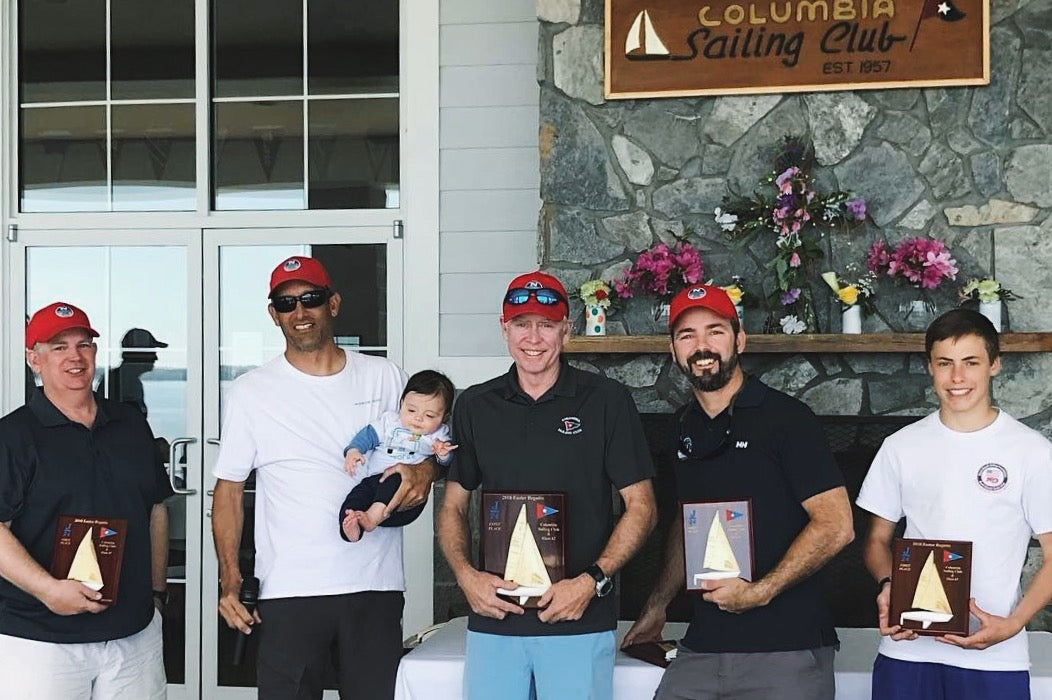
events
J/24 EASTER REGATTA, COLUMBIA SAILING CLUB
J/24 EASTER REGATTA
Paul Abdullah’s Team Tarheel Finishes Strong With Five Bullets
Easter came earlier this year but didn’t stop anyone from having a great time at the 2018 J/24 Easter Regatta at the Columbia Sailing Club. Eighteen teams were blessed to fabulous conditions and the excellent hospitality from the club and its members who made all feel very welcome.
Friday’s conditions started out 10-15 knots and slowly dropped to 7-12 as the day went on. The Saturday’s forecast wasn’t great, but what do those weathermen know! The winds blew and the PRO was able to get another four races off. Team Tarheel started the regatta strong with a 1-2-1-1 and remained strong on Saturday with a 2-1-1-2.
There was little breeze early Sunday morning and the PRO postponed waiting until the wind filled in. After 20 minutes passed, the RC decided it was time to race. Team Tarheel closed it out finishing 3rd, and using that as their drop. The RC sent the fleet in with the 2018 Easter Regatta in the books.
We caught up with Tarheel’s skipper Paul Abdullah:
Paul, 5 bullets! What were the 3 key factors for team Tarheel to have such success?
Our boat speed was incredible! Knowing what mode to sail in with each pressure line approaching was important. Also, we attacked the wind instead of waiting for it to come to us.
Which North designs did you use?
We used the North Fat Head Mainsail, SD-TH Genoa and FR-2 Spinnaker. Boat speed and pointing was excellent.
Do you have any tips for the North Americans in Charleston?
I would always stress boat prep. Make sure everything works well for your team. Replace any lines or blocks that aren’t working properly.
Charleston has a lot of current. Understand the depths of the harbor and where you can “hide” from current.
Thanks Paul and congratulations for a brilliant regatta!
Learn more about the North fast J/24 designs.
2018 J/24 Easter Regatta
1. Paul Abdullah
3. James Howard
4. Christopher Stone
6. Steve Wood
9. Bill Derr
Full Results
READ MORE
READ MORE
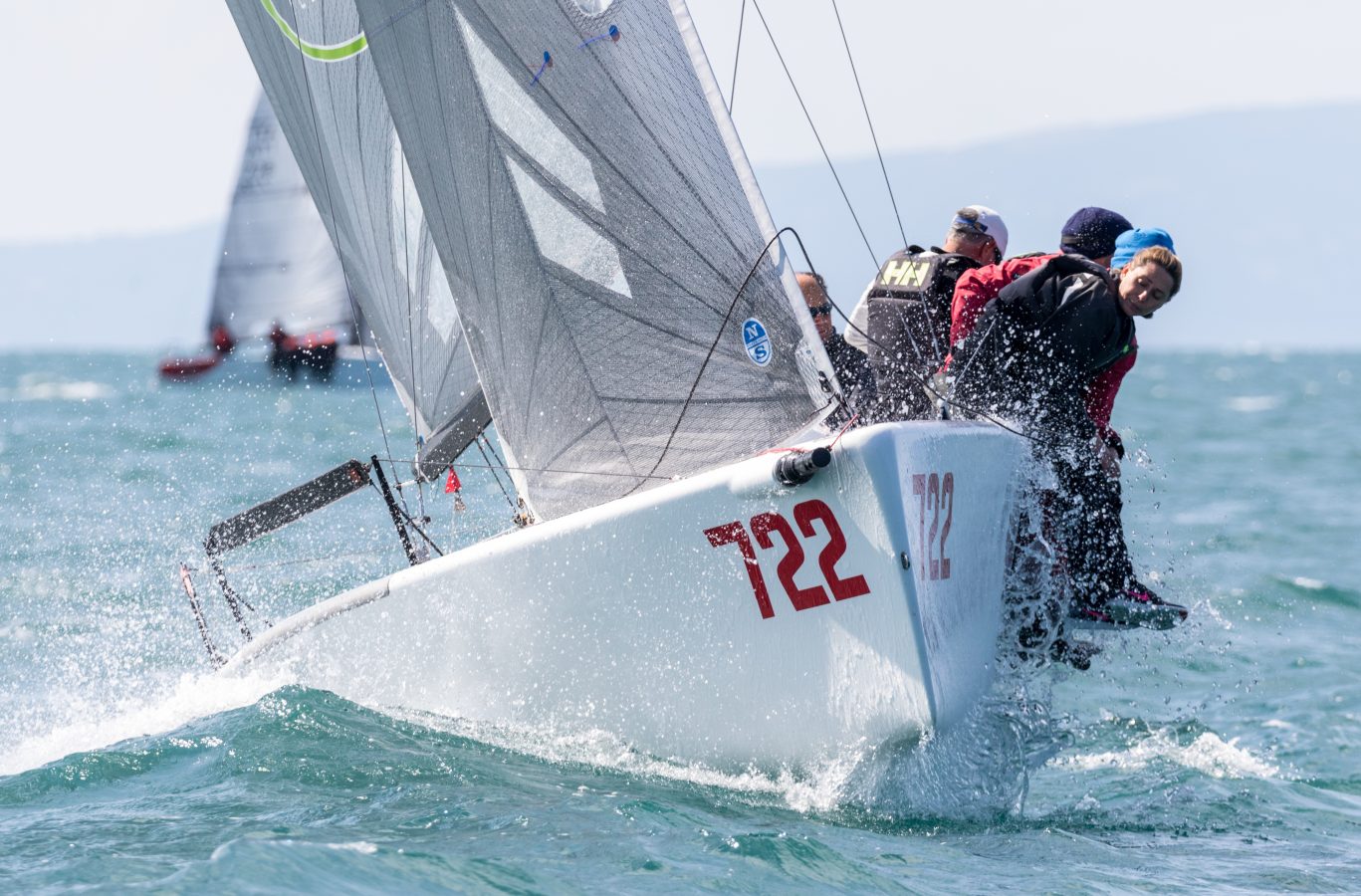
events
ALTEA WINS MELGES 24 EUROPEAN SERIES ACT 1
ALTEA WINS MELGES 24 EUROPEAN SERIES ACT 1
Andrea Racchelli and Team Altea Nails the Series in Punta Ala
The event in Punta Ala marks the start of the European summer sailing season for the Melges 24 class. Despite variable conditions across the 3-day regatta, the race committee completed nine races. A battle between Altea and the Hungarian FGF Sailing Team broke out, however Altea lead by Andrea Racchelli repeated their success from 2009 to take the win in Punta Ala. Andrea is a veteran to the Melges 24 class having sailed in the boats for nearly 20 years! He now also acts as class president in Italy. We spoke to Andrea about his team and asked for a few tips for sailors in the class.
How long have you been racing the boat and why did you choose to sail the Melges 24?
I have been sailing Melges 24 since 2001. We bought the first boat at the end of 2000, at that time the Melges 24 was the best one design class, with a lot of great sailors competing. The boat was so modern compared to other one design boats like the J/24, which for us was a big challenge.
Tell us a little about your team; who does what on the boat and why you chose this team.
The Altea team was born in 1997. During all these years many people sailed on our boats, but always as a group of friends! I’m the helm and tactician of the boat and the team manager. The trimmer is Enzo Bonini – we have sailed together since 1992. In Punta Ala the bowman was Alberto Verna while the pit was Tiziano Auguadro, the oldest member of the group. He has been with us for many adventures. Finally we had the new entry Marta Conti, she will be with us for sure also in the future. During next season we will have onboard also Michele Gregoratto, Filippo Togni e Matteo Ramian.
In the light/medium wind conditions that you had in Punta Ala, what would your top tip be for going fast upwind and downwind?
On Melges 24 the setup of the boat and the boat handling is very important. Having the full crew hiking is the secret to have good speed upwind. On the downwind you have to work hard on the angle to keep boat speed always right. Of course you need very good sails, fresh as possible!
How do you set-up the rig for a days racing and what adjustments would you make throughout the day?
On Melges 24 you always have to change setup during racing. I have a base setup for 8 knots of wind. We always dock out with that and change tensions for every change of conditions. (For more information on Melges 24 tuning, check out the Melges 24 North Sails tuning guide)
Which North Sails products do you use? Why did you choose North Sails and what is it that makes you keep using them?
At the moment I use AP-3 mainsail, J-7+ jib and P-2 Spinnaker most of time, however sometimes theP-1. I chose North Sails in 2002 because North is the most experienced sailmaker in the class and a great team of experts working on the sails.
What tips would you give to new teams coming into this highly competitive fleet?
Train hard on maneuvering, always try and keep the crew consistent. Always ask class experts about initial setup and then work on it yourself and most important, have fun!
What events do you have coming up in the calendar and what can we expect from you and your team this season?
The two main events will be the World Championship in Victoria (Canada) and the European Championship in Riva del Garda (Italy). Our best result was 2nd at the Worlds in 2015 and so we will try to do better than this!
For more information for the Melges 24 class and the North Sails products, visit our class page and speak to your local expert.
Full results
READ MORE
READ MORE
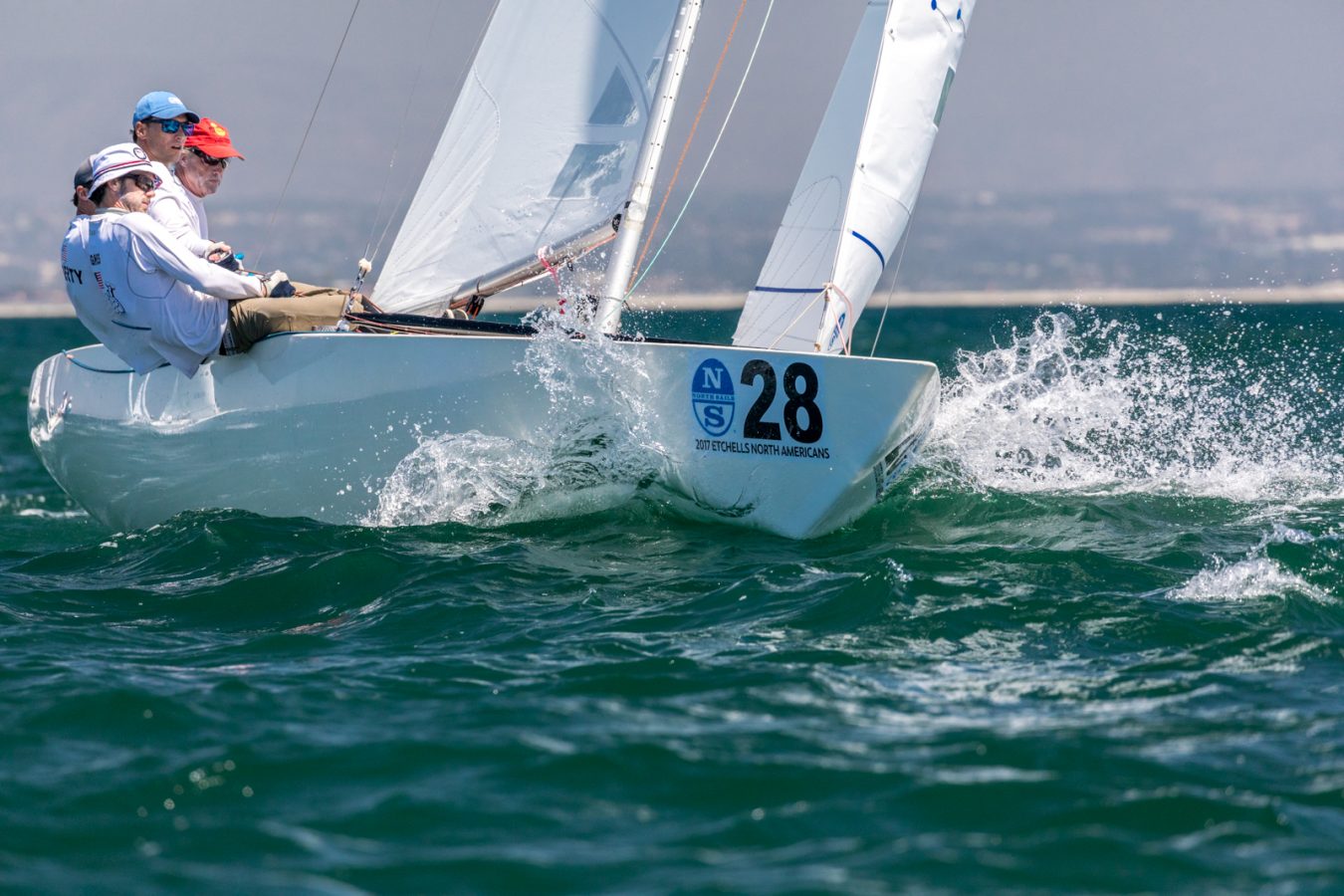
events
THE TACTICIAN ROLE: INTERVIEW WITH MICHAEL MENNINGER
THE TACTICIAN ROLE
Michael Menninger, tactician on SCIMITAR, 2017 World Champion and 4-time Etchells Winter Series winner
Michael Menninger is on a roll. In September of last year the young professional sailor and tactician won the Etchells Worlds in San Francisco with Steve Benjamin. Just a couple of weeks ago Michael and SCIMITAR team wrapped up an overall win of 2017-2018 Etchells Biscayne Bay series, the de facto winter championship for the class. Using North Sails at all these events their team has been truly dominant. Chris Snow from North One Design caught up with Michael to get some insights sailing for one of the worlds best.
Would you say you’re kind of like the quarterback in a way for the team?
A little bit. I mean I’m super lucky to sail with someone like Benj, who has so much experience and knowledge already. He is the quarterback in a way because he does all the organization behind the scenes. Sailing is seemingly always on his mind, and he’s always thinking of ways to improve the team, sails, parts, etc.
He is also the best driver I’ve ever sailed with because he’s not only very skilled but also very receptive and trusting with all the crew. He never dictates or tells us what to do. He is always really quiet and making sure that he is driving to the best of his ability, and then listening to us on where to go and what to do.
During regattas, I guess you could say the football gets passed, and I take on the role of the the quarterback. I just try and make sure that everyone is rested, calm, and ready to race.
Before the start, what’s the discussion on board like? What kind of things are you guys talking about together before the racing starts?
We monitor a few things: the geometry of the race course, as well as the wind strength and how our rig tune, sail and batten selection matches up with the conditions. We also closely monitor our wind forecasts to see how they are matching up with our observations, and it can help us guess what we expect to see next.
In your role as tactician, how do you manage the last couple critical minutes before the start? What type of information are you giving to the team and what are you getting from them?
This is, for sure, the biggest moment in the whole race. I come up with a general plan of where to start. Sometimes, it’s very specific and sometimes it isn’t, but it’s nice to have some sort of plan. A main priority for me is just to stay clear of any big packs and making sure we keep our destiny in our own hands. I find if you have a very specific plan, sometimes it will take you into a crowded situation and then you have greater odds of getting mixed up with another boat or two and not being able to execute on the important things, like hitting the line with speed. That being said, our top priority is to always be in our own water and do what we can to control the boats around us. So once we get into a comfortable place on the line, it’s all about time and distance and managing our hole from that point forward.
What I’m doing at this point is just painting a picture of what we will do next, and take in information such as time, and distance to the line. I’m basically trying to keep us in relatively low-risk situations from 2:00 – 1:00 to go to the start.
I think it’s a really big advantage to have four people on the boat because we have more eyes. We have someone spotting for poachers and hookers. A poacher is someone that is coming in on port and can potentially tack to leeward of you and take up your hole to leeward. And a hooker is someone who is reaching down the line behind you on starboard who is going faster through the water than you and can potentially hook you and control you.
Someone is calling the time, and in some cases, we put Ian on the bow so they can monitor our line sight. If we’re in the middle of the line, it’s nearly impossible to judge how far away you are, and it’s really helpful to have someone on the bow telling us how many boat lengths we have. Given all this information, I dictate which mode we should be in and I work with Benj and the jib trimmer on what needs to be done in those final seconds. I am the voice on the boat so the communication at this stage needs to be clear. If we are controlling the boats around us, the goal is to hit the line at speed at the gun.
It sounds like you would rather start in an uncongested area versus completely at the favored end.
Yea most of the time. It’s so hard to come back in this fleet, if you start in 30th, it is really unlikely that you’re gonna get back to the top eight. So just being able to start and go straight for longer than most, and pick the next best decision and try to get on the next shift, may get you into 15th place right away. Staying clear, keeping our options open and making sure we can pass boats on every leg and not start out at 30th or 40th, is a big priority.
In such a tight fleet there are many times upwind and crossing situations where you have to decide whether or not to cross-tack or allow another boat to cross even though you have right-of-way. How do you typically make these decisions?
The two biggest things that I monitor are where is the max pressure on the course and if we are lifted or headed. Knowing those two things will help you make a lot of good decisions. Sometimes I will sit in a compromised lane for a long time just to stay on the lifted tack, or if I know it will bring me into better pressure or the next shift sooner. I try my best to be patient, but if you see something that you are confident in you should act immediately such as sailing to the pressure.
Ian is kind of my eyes for macro pressure. Focusing on boat-speed, staying in mode with Benj, and trimming the main keeps me pretty busy so having another set of eyes looking forward is key. I rely on the guys up forward with just keeping me honest where the best pressure is. I think you have to be ready to take some transoms in order to stay in the best pressure. If you can do that you will pass all the boats that are hoping something will come their way even if they are sailing away from the pressure. Don’t be hopeful.
Is Ian the second person back?
Yes, he’s the second person back. Previously we had Dave on the jib and now we have Johnny on the jib with Ian just behind. Ian is pretty much just hiking upwind so he has the time to keep his head out of the boat. The jib trimmer is also busy trying to adjust the jib and rig so we can keep the boat at max power. We have the jib trimmer calling micro pressure, counting down the puffs. That’s really helpful for me because there is a lot of different controls to play once a puff hits you (the traveler, the mainsheet, the cunningham, the backstay). Ideally, finding out how strong a puff is going hit us and for how long it gives me time to change the mainsail as the puff is actually hitting us instead of after.
The last third or quarter of the first beat is critical. The boats are still close together and getting around the top mark in good shape can make or break your race. How do you handle this part of the race? Do you have any pointers on that?
I think it goes back to are lifted or are you in the best pressure. You may think that getting out to an edge for clean air and a clean rounding may be best, but if you are sailing away from the best pressure, then that’s obviously no good. It’s pretty tough. You have to imagine the race course without any other boats and ask yourself, what would you do if you were out there alone? If there’s more pressure on the left, you have to go there. You have to spend a tack to go to that pressure and then do your best from that point on.
On the flip side of that, if you have 20 boats going to a single puff, you definitely don’t want to sail behind them all. You want to make sure you are leading them back to the next shift or the next layline. If there’s a puff on the left and there are literally 20 boats in that puff that are taking it back, I don’t think you really want to take all the transoms just to get in that puff because you’ll still be behind them. In that case, you really want to lay up underneath, see if you can get a little bit of the puff on the edge, and be in a position to where, once that puff goes away, the people that are a little bit compromised out of that 20 boat pack are going to be slowly pushed back behind you.
One last thing is to really avoid the laylines at all costs. Since these boats are so windshift-driven and especially in a place like Miami, where the wind’s oscillating all the time and oscillations can be pretty short, getting out to a layline early means that you’re going to miss the last shift and lose boats.
How do you play the downwinds? How early do you decide which gate mark to go to?
I spend a lot of my time looking behind us, just to make sure that we are in a clear lane. Ian on the bow is also looking back a lot and helping me with the macro pressure. One other thing downwind is overstanding is a massive penalty in these boats. Big penalty both upwind and downwind, really. I’m always trying to lead people back to the middle in most cases unless there is big pressure on the side.
As for the gates, sometimes I leave that decision pretty late. I am open-minded on either gate and it can be really difficult to tell which one is closer. I try to not be overly committed to a gate until I’m really sure of which one is going to be favored, and a huge factor in making that decision is which turn is cleaner. Cleaner means which rounding will get you into clearer air and the clearest water as soon as possible.
For example, let’s just say that the majority of the fleet is on the course right side looking upwind, and as you approach the gates there is a right-hand shift making a left turn, favored. A lot of people may think that making a left turn would be better because of the shift and the mark is further upwind. But if it takes you into 25 spinnakers, and chop from all those boats coming downwind, that’s not really good either. In that particular situation, I’d be taking a good look at the other turn, as it could potentially get me into clear and clean water sooner.
It seems to me if you’re rounding directly behind five boats or so, it’s extremely difficult to get the boat going. It turns into a massive pinch fest, and everyone’s going really slow. If you compound that with a lot of boats coming downwind and giving you bad air and more chop, then that’s so painful. If you can take the other rounding, even though it’s not quite as favored, but you have a little bit more room to breathe, you can get the boat moving quicker, then that’s something to really take into consideration.
Actually, I made this mistake on Sunday of the Midwinters on the very last race. I chose the gate to get some more pressure and the shift but it wasn’t quite as clean and we lost a boat that was way behind us. It was super frustrating because I felt like I made the correct decision at the time based on the wind strength and the shifts.
If you sail in a place like San Diego or San Francisco you really have to make sure that you’re going to be rounding a favored gate. That’s going to take you to a side that’s clearly going to pay. In a place that’s oscillating, making sure your rounding is the clearest, it should be a very high priority as well.
You’re just getting started in your sailing career. Is there anybody that you could credit with influencing you in sailing?
Definitely. My family got me into sailing and have given me the tools to succeed from an early age. In the recent years, there hasn’t really been anyone guiding me per say. Sailing’s a great sport because there are so many amazing things to do. You have America’s Cup, Volvo and offshore racing, high-performance sailing like the Moth fleet, the Olympics, professional one-design sailing. They’re all fantastic and have incredible competition.
I think being guided would be easier if you wanted to do just one thing, such as the Olympics. I feel like for myself and for a lot of other sailors who want to keep their options open, there really isn’t a guidebook or a right thing to do and a wrong thing to do.
For me, I just try my hardest to be the best teammate I can be and help our team win in any way that I can, and see where it takes me. In the last few years, I’d have to say a big thank you to Argyle Campbell who gave me a start in the Etchells fleet. He trusted me to put a team together and that was my first year ever sailing Etchells. We ended up winning the JAG series that year too.
Lastly, a huge thank you to Heidi and Benj for giving me all the opportunity I could hope for. Sailing on one of the best Etchells programs is amazing, and bringing me onboard their TP52 Spooky as a tactician has been a fantastic experience.
It’s all been a fun ride these last two years and it has opened the door to other sailing opportunities which I’m really excited for such as doing tactics on Rio for the TransPac 52 West Coast Series. I’m looking forward to sailing more in the Etchells class and also expanding into other classes as well. It’s all been good.
Michael, thanks so much and we wish you the best of luck in all your upcoming adventures!
READ MORE
READ MORE

events
ROAD TO THE J/22 WORLDS: KEEPING IT SIMPLE
KEEPING IT SIMPLE
Four basic rules to simplify your race days
Hop into my DeLorean, buckle up, and let’s go “Back to the Future”!
It’s September 2018. Imagine yourself at the dock at the start of day 2 of the 2018 Worlds in Annapolis. It’s currently blowing 18 knots with even bigger puffs because a front has just rolled through. There’s a 50% chance of this wind speed persisting all day and a 50% chance of the breeze dying to 8 knots in a few hours. What’s going through your mind? What should you set the rig to? Is the bay full of waves and steep chop? Should you think about changing your forestay? Where is the sweet spot for your jib halyard? Are the jib cars too far forward, too far aft, or just right? What about the top main batten? Should you stick with the standard or use the heavy-air batten? What is the competition going to do? Who do you have to watch out for? When should you leave the dock? Do you have enough food and water onboard? All these questions and more are swirling around in your head. How can you manage to answer them all correctly?
Hopefully, many of these questions will be answered in your preparation leading up to the “Big Event” because, if you try to focus on all these questions simultaneously, it’s easy to get muddled and over-complicate things. That’s why, as the season gets rolling, now is a good time to put in place a plan for your team to “keep it simple” as an important foundation to successful sailboat racing. To simplify your race days, try following these four basic rules.
First, have a plan and stick to it.
You’ve raced before, so set a routine that works and stick with it. For instance, you can keep provisioning simple by bringing the same food every day. You know what’s been successful in the past, so why overcomplicate things? As for how much water to bring, it’s better to have too much than too little. You can always dump some over the side if it’s not getting used. Knowing when you need to get to the boat and when to leave the dock should also be part of your premade plan. Again, keep it simple. Start with when you want to get to the racecourse (not too late but also not so early that you wear yourself out) and work backwards from there. Your daily schedule should then fall into place and won’t be an added concern.
Second, don’t leave things to the last minute.
When you come in from racing, it’s rare that something doesn’t need to be fixed or tweaked. How tempting is it to say, “I’m tired. I’ll just do that in the morning. What I need right now is a beer!” But how many times do projects on boats take longer than expected? (Hint: Every time!) That’s why you shouldn’t wait until later to get a job done. Just bite the bullet and do it when you get back to the dock. Avoiding stressful, last-minute work is part of keeping things simple. Good boat preparation isn’t last-minute.
Practice isn’t last-minute either, even though we’ve all heard people say, “I’d like to get out to the racecourse early to practice.” During a major regatta is not the time to try to improve your skills. That’s what practice before the event is for. The mornings of a major regatta are for getting out to the course and perfecting your setup for the day. So keep it simple and eliminate practice from your race-day plan.
Third, don’t sweat the details you can’t change.
As you head out to the racecourse, the question of whether your tuning is right always weighs on your mind, but don’t dwell on it now. Getting these details right is what the time before the first race and between subsequent races is for. When you get to the course, find a boat to tune upwind with, make some changes to go faster, and then get ready to race. Once the race has started, don’t obsess about the rig. It’s set; you can’t change it; so don’t think about it. Too many times I hear people say that they weren’t fast because their rig was too tight when the breeze dropped a knot or two during a race. But remember that everyone else is probably dealing with a tight rig too, so quit worrying about the rig and just make the boat go as fast as you can. If you’ve practiced and your team is ready, the tuning will be good enough to allow you to win the race. The point is not to focus on something you can’t change. Keep it simple and focus only on important decisions you’re able to make.
Fourth, make sure you’re going fast.
Speed is king in keeping things simple. Both upwind and downwind, speed makes everything easier because it allows you to concentrate on the race and your tactics. Whatever your problems may be on the racecourse, speed will help you overcome them. For instance, it you’re having trouble pointing, it’s probably because you’re not going fast enough to make the keel work, so you’re sliding sideways more than the boat next to you. The solution? Keep it simple. Put the bow down, go faster, then trim the main harder and let the boat do the work. You can also minimize risk by being conservative when you’re going fast, enabling you to tack in easy lanes. Keeping it simple with conservative tactics means that you’re apt to round the top mark with the leaders and move forward from there.
So back to all those questions that were swirling around in your head before the second day of the Worlds. You already have answers to them, so don’t overcomplicate things. Filling your head with questions and raising self-doubts is never helpful. Instead, keep it simple and don’t overthink. Have a plan and stick with it, never leave things to the last minute, and avoid getting stressed over details that you can’t change. Above all, make sure to go fast so you can focus on the racing and your tactics. As some of you may have already heard me say: Sailboat racing is like NASCAR – just go fast and turn left!
Mike Marshall crossing the finish line to win the 2016 J/22 World Championship
READ MORE
READ MORE
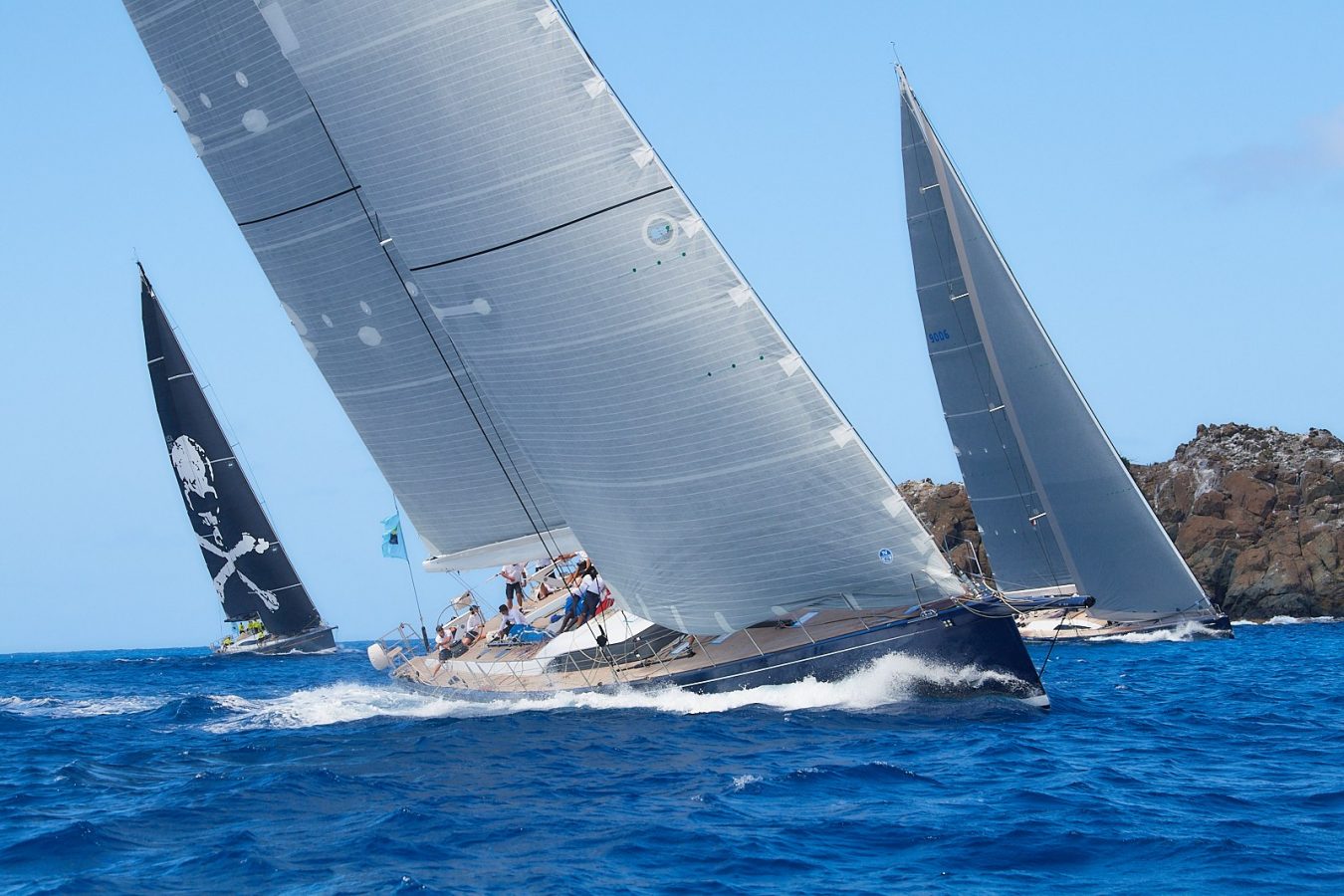
events
BUCKET BRAGGING RIGHTS
BUCKET BRAGGING RIGHTS
North Sails Superyacht Clients Sweep Podium at 2018 St Barths Bucket
Competitive superyacht sailing and onshore camradaries are hallmarks of the St Barths Bucket © Michael Kurtz
Superyachts were on parade this past weekend for the St Barths Bucket Regatta. Founded in 1986, “The Bucket” is an annual three-day invitational regatta that plays host to the world’s most breathtaking superyachts. This year is especially significant as many worried about the island after the 2017 hurricanes, but St Barths has bounced back, and island hospitality was running at full force.
“A huge amount of credit to the island of St Barths, the event organizers, and the owners who had faith the island would recover in time,” said Ken Read, President of North Sails. The Bucket is always an amazing, well-run event and everyone who sails these superyacht machines looks forward to a beautiful week in paradise. Superyacht racing is alive and well because of events like the Bucket.”
North Sails inventories powered all first place finishers and overall winner Nilaya in the Pursuit Classes, as well as Svea, first place overall on the J Class. It was a busy week of North Sails who had close to thirty sales and service reps on the island. Global Service Manager Ben Fletcher once again had the North pop-up loft working to ensure all boats were race ready should they need repairs. North’s sales and service presence is a testament to their global superyacht structure, which is enhanced with our expanded presence in Palma.
“It was a great week for North Sails and our clients,” remarked Tom Whidden, CEO of North Technology Group. “Bucket racing is competitive, yet there is a tremendous amount of friendship and camaraderie once the yachts hit the dock. Having been involved in North’s decision to leap into 3Di, the Bucket is proof that this technology creates the highest performance and most durable Superyacht sails. You used only to see 3Di on race yachts, but we’re now seeing many of the cruising oriented yachts sailing with 3Di inventories. The product holds its shape and will not delaminate making it possible to carry a single inventory for both racing and cruising, a quality owners and crews can appreciate. I sail on SPIIP whose 3Di mainsail has outlasted our expectations by years and still has amazingly good shape.”
Three J Class yachts participated in the 2018 Bucket. Svea collected six points to take first place with Velsheda and Topaz with 12 and 13 points respectively. © Michael Kurtz
Crew pulls in the spinnaker onto the deck of SIIP © Claire Matches
READ MORE
READ MORE
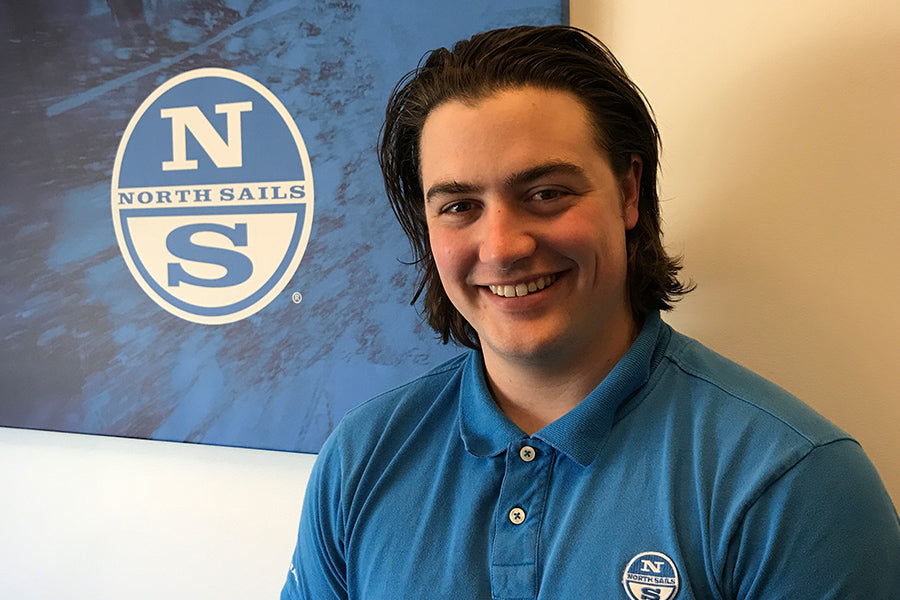
events
DESIGNER SPOTLIGHT: MAX TRINGALE
DESIGNER SPOTLIGHT : MAX TRINGALE
Developing Tools To Help Visualize Performance
There is a lot happening behind the scenes in a sailmaker’s world – things you wouldn’t know about unless you asked. North Sails Designer Max Tringale, based out of Portsmouth, Rhode Island USA, is teaming up with North U. on an exciting new project that will help to better educate sailors on sail trim. Max has a very defined background in boat building, marine systems engineering, and yacht design. Along with the North Sails design team, Max is building an easy-to-use application called Sail Trim Simulator. The tool will help clients and sales experts make sense of sail trim, fundamentals of sail shape, and understand how these variables impact performance.
Max explained;
“Our goal with the Sail Trim Simulator and with this new technology is to provide more enjoyment out of sailboat racing for our customers through a better understanding of what their boat is doing and how their sails are working.”
The North U. Sail Trim Simulator is being developed to help clients visualize how sails and rig interact together and how that relationship is manipulated by the different sail controls to achieve desired sail shapes. “We currently have two sail models, the TP52 and J/35, loaded into the simulator,” explained Tringale.
Bill Gladstone, director of North U. commented;
“There are specific boat designs for each model, and the user can select which performance factors they want to turn on or off. The Sail Trim Simulator has the ability to alter everything from wind speed to sea-state, which can all be altered to create a simulation of what you’d expect when you are out on the water. The user will be able to see the performance difference so they will understand how they should set the sails up for maximum speed in given wind conditions.”
In both screens, the J/35 is sailing at a little over 12 knots. In the upper right-hand corner, you have adjustments for wind speed and sea-state.
The Sail Trim Simulator is particularly suited for one design sailing, where it can be used as part of North Sails tuning guide to further explain rig set up and tuning. When supplied with various rig settings and tensions, the tool provides a visual aid to show why North recommends particular settings. The app provides targets for rig adjustments and trim settings before even getting on the water.
User optionality for viewing angles to see the slot of the genoa and mainsail and what the leech looks like from the top down view, showing flatness of the sail when the trim is applied.
“We’re looking at seven different control factors; mainsheet, backstay, traveler, cunningham, jib sheet, jib lead, and jib luff tension,” explained Tringale. “For each one of those controls, we are developing optimum sail shapes. We identify the optimum for each control point, understand how it is correlated with the other points, and then define optimum sail shapes for each wind speed. Other controls like rig tension and mast rake are left standard at this time to simplify the tool.”
When the user opens the application they will notice that each control point has a working range. For example, if you want to pull on more backstay tension, you can adjust in millimeter increments and watch as the output numbers change. The app has a function called the Magic Wand, allowing the user to set a desired TWS and having the app find the optimum upwind boat trim for that wind speed. Also shown is the VMG and TWA the boat is sailing at, showing optimum sail trim.
Image shows boat trimmed to 16 kts TWS. By dropping the traveler and adding more backstay, the main is flattened and the genoa can be sheeted in and the lead moved aft to twist the head. Image shows boat trimmed to 6 kts TWS. Using the magic wand, the boat sails naturally at 45.6 deg TWA with no backstay and the traveler set below centerline. Notice how the jib luff tension is softened.
Users can gain an understanding of how certain sail controls are used to de-power, and power up the boat. By adjusting controls, the shift in draft location manipulates twist, which affects boat speed, point, and VMG. All the controls are connected so the user can work towards their target boat speed for selected TWS.The rudder angle indicates if you have too little helm, which would tell the user sail trim adjustments are needed.
North U. is currently beta-testing the application during their Trim Seminars to make sure that the data that we’re developing is real, useful, and user friendly.
North Sails enjoys having a lot of talented designers contributing to their product development and are always looking to improve. “The Sail Trim Simulator is one tool that can help our designers (as well as our customers) understand the cause and effect of sail and rig trim,” remarked Tringale. “Not only the actual change in sail shape but also overall boat performance, which is ultimately what we are looking for.”
“It is incredible how much data and work has gone into the Sail Trim Simulator because it really shows the power of the North Design Suite software. We’re the only ones that are developing something like this that we know of. This project is special because we’ve developed real flying sail shape and rig data, developed using Membrane™ program coupled with Flow™, our program for the fluid surface interactions. From there, those optimized flying shapes are run through the North VPP, which is doing integrations between the various flying shapes. It really is a unique thing that we have; the ability to produce a tool like this.”
The creation of the Sail Trim Simulator is just the beginning of a new generation of designers at North Sails who strive to create the best products for our clients.
North U Seminars provide classroom training with a roster of top instructors and the latest in interactive multimedia training. Check our schedule of upcoming full and evening seminars, or get info on how to bring a North U seminar for your club, fleet, or association.
READ MORE
READ MORE

events
J/24 MIDWINTERS: BOGUS SAILS TO WIN
NORTH POWER SWEEPS J/24 MIDWINTERS
North’s Will Welles Shares How They Sailed To Win
© Chris Howell
35 teams met at Shake-a-leg Miami for the 2018 Midwinter Championship where sunny skies and beautiful breeze greeted sailors with ideal racing conditions for the three-day event. Each day brought building breeze from the NNW that slowly clocked NNE by the end of each day, keeping sailors on their toes with oscillating shifts that were as high as 30 degrees. As the breeze increased, teams concentrated on maintaining boat speed in the developing chop, which made for some great opportunities to gain both upwind and downwind if you could catch the right shift and make smart decisions.
At the end of day one, Will Welles’ team Bogus was hot as ever, ending the day with snake eyes giving them 4 points total. This would be a precursor to the remaining race days, as Will’s team never scored worse than a 5th place, allowing them to win the race to the dock as the last race would be their victory lap. Consistency paid off the remainder of the weekend, driving Welles to win the overall championship by 18 points, with one discard. In second place was Tony Parker’s North-powered Bangor Packet. Mark Laura’s Baba Louie was unstoppable, stepping up the level of competition in the Corinthian division. Congratulations to our clients on a successful weekend. A great start to the 2018 spring sailing season.
Full Results
The truth About Bogus, 2018 J/24 Midwinter Champs
We caught up with skipper Will Welles who was driven to success in Miami for the J/24 Midwinter Championship with his team Bogus. Hear the truth, first-hand from Will, on how his team sailed to win the regatta.
What were some of the things you focused on during some of the practice days leading up to the first day of racing?
We had a lot to do in a little time because we borrowed a boat that was already down there, we picked a boat that we knew had good pedigree, but we knew we’d have to spend a day or so changing a couple things to make it the way we wanted it (Thank you Nick Turney!). Once the boat was set and the full team had arrived we were able to head out sailing spending a few hours on Wednesday and then a few more hours on Thursday.
“Our main focus was to make sure the boat was up to speed, that it had the straight line speed that we are use to with our own boat. We just set the boat up to our dock tune and then went out and lined up with a few boats and pretty quickly found our speed, straight from the tuning guide!”
When you get out on the race course, what are some things that your team focuses on? Of course you probably sail upwind a little bit, make sure your rig feels right, your boat speed is good, get the trimmer warmed up- but what else are you doing to get ready for the first race?
“The big thing is, we don’t want to rush, so we get out there at least an hour early and spend at least an hour on the race course before the first warning signal.”
In Miami we actually got out there about an hour and a half early each day, and without rushing, your heart rate isn’t too high and you can just focus on getting your homework done. The homework is sailing the course and seeing what the wind is doing. Logging in some compass numbers upwind and checking the rig setting. We like to meet at least another boat out there to sail upwind together to make sure we’re going alright and that our rig set is where we want it to be. We get some numbers and then go back to the line and check in. Note: As far as rig settings go, we were always making sure we weren’t ever caught too tight on the rig, we’re always gearing towards maximum power. There were some big holes (lighter air patches) on the course, and they lasted a long time, so max power was key.
Sometimes we’ll do a split tack where both boats start at the committee boat, one on starboard and one on port and we sail for five or maybe six minutes then tack and see where where we are when we come back together. Sometimes this is helpful, but it’s not always helpful. You just have to take it as more data.
“You can’t always think that if a boat that sailed the right side crushed the left side, that’s how it’s going to be by the time you get the first race started.”
So we do the split tack and then we go back to the line and take a little water break, maybe eat a granola bar and then start doing our starting line homework. We ping the line at both ends, then log some head to wind compass readings which helps us get an idea of what the shifts are doing. Then the big focus is getting off the line on the favored side of the starting line and getting to the side you want to sail the first beat. We usually discuss all this stuff as a group, then try to execute our plan.
So after the start, you guys are heading up the first beat. Is there a lot of communication between you and the trimmer? And if so, what kind of information is discussed?
Rich and I have sailed together for a bunch of years, so the talking is minimal, but that’s just because we know what to expect with one another and we know what we’re looking for. There’s not a lot of conversation. Depending on sea state, the bigger the waves he might be playing a little bit more sheet than he would if it was flatter water. In conditions like Miami, it wasn’t that wavy, there was some small chop. We’d get out of the tack, he’d get the genoa inside the lifeline then to the rail, I’d put the winch handle in and when the boat was up to speed I’d grind it the rest of the way in.
We pretty much leave it in unless I was flogging the main more than I wanted to in a puff, he listens to that and I might tell him for some waves, burp the genoa (sheet) a little bit. Or if the breeze drops down a little bit, I might tell him to burp the sheet or if I adjust the backstay I’d let him know that too. So there’s little chatter. We’re always talking about the sheet. I do the final winch handle fine trimming, in and he’s doing the easing out of the sheet up wind.
As you approach the downwind leg, rounding the top mark, you crack off and start the pre-feed. Who makes the calls from there?
We have a discussion, soon as we round the top mark, I’m asking the tactician (PJ Schaffer in this case) are we extending or looking to jibe? We’ll have that discussion and I know before we get to the offset what the plan is. It’s my job to get the boat setup so that we can either jibe or continue and extend. I’m watching the boats around close behind us, or close in front to make sure we are clear to make a move if we decide that is the plan. The breezier it is, the less weight you want off the rail from the weather mark to the offset. So we try to keep weight on the rail and trim the sails to the angle we’re sailing to the offset so we can get maximum speed. Making sure the main is trimmed just right, the vang, and the genoa, we go for the pole and pre-feed the guy and be ready to set the kite at the offset when I call for it.
Then once the spinnaker is set we’re always talking about angle and pressure. I’ll ask Rich if he likes the angle out of a jibe if we do execute. I’ve got a good feel from the rudder and the wind on my neck, and he’s got probably the best feel with the pressure in the kite from the sheet. I’m always looking to hear what he’s feeling in the sheet and that kind of helps me plan whether I want to start putting the bow up or start pushing the bow down.
“We usually have someone on the boat giving us a heads up on what’s coming big picture pressure wise, whether it’s a long lull or a big puff or just medium pressure. That’s also good information for me to decide where I need to put the boat. It’s just good communication so everyone is on the same page.”
The key is that we don’t talk constantly, we talk as needed. I think sometimes people can talk too much, so when you’re communicating less words are usually better than trying to sprinkle lots of extra words in there. Just getting right to the meat of what we’re trying to talk about whether it’s a puff or a lull or good pressure works the best.
What would you say are three things that contributed to your team’s success at the Regatta?
Everyone on the team brought a lot of skills to the team, and so it was almost easy. We all just fit together really well and everyone knew their jobs and did their jobs and it just worked. Having a good boat and a good team is so crucial and it’s a key to success. Once you have that stuff, it’s getting good start, picking some shifts correctly, .and having fast sails of course.
Give us three tips that would help a J/24 class sailer get faster on the race course?
The boats have been around for a long time, and the tuning information that we have is pretty solid. You can get a boat, set the rig up right to the tuning guide and have speed straight away, which is really good. That takes one huge thing off the plate. Boat speed is a crucial part, thankfully the tuning guide and our sail designs offer boat speed to all the teams that use our product. Boat preparation is also key. Making sure you have a good keel, rudder, bottom, mast and rigging, and make sure they won’t fail you on the race course or hold you back. That’s all relatively easy stuff to get sorted. Once you get those things figured out, get sails and needed boat speed then the real difference becomes the crew.
“Sailing all you can together in all the conditions and approaching it as a team and all growing as a team is so important.”
Knowing ahead of time you’re going to be doing an event or even back to back events, is there any mental preparation involved to get your mind right?
The key is the people you surround yourself with. It’s a lot of work to get a sailboat to a starting line and if all that work is on one person’s shoulders then that can create some stress, so having a good team with good teammates that all know their strengths and weaknesses and bring what they can to the table to help scratch things off the to do list is kind of what it’s all about.
“It’s who you surround yourself with and the teammates you go to battle with.”
If you don’t have good teammates, then you get on your heels with the boat work and boat preparation and that creates stress and makes it hard to succeed. Making sure you leave enough time to do everything you need to, be prepared, eating good food, getting good rest, and having good teammates that are helping with the workload is very important in mental preparation not just for the skipper, but for the entire crew.
Interested in regatta winning J/24 sails? Contact our experts!
READ MORE
READ MORE

events
VIPER 640 WORLDS: INTERVIEW NICK JERWOOD
INTERVIEW WITH 2018 VIPER 640 WORLD CHAMPION NICK JERWOOD
Top Ten Teams Powered by North Sails
North Sails is proud of all clients for their dominant performance at the Schweppes Viper 640 World Championship in Perth. All top ten boats at the Worlds were powered by North. Our own Viper expert, Zeke Horowitz, had the pleasure of catching up with new World champion Nick Jerwood to pick his brain on the key factors that led to his team’s success. Please enjoy the interview with the Champ below!
Tell us a little bit about your team and what it’s like to sail as a family at such a high level. How long have you guys been sailing together and how much Viper experience do you have as a team?
Brian is the father of my daughter’s crew in the 470 Class and he asked me back in September 17 whether I would be able to sail the Viper with him, potentially on up to and including the Worlds. I jumped at the chance never having sailed with Brian before but knowing full well what a really top bloke he is, it was an easy decision! The choice of middleman was the next piece of the puzzle that we had to solve, the answer came to us fairly quickly after Matt (my son and helm of the World Match Racing Tour team “Redline Racing”) confirmed he would be able to sail the Worlds with us. To sail with Matt was quite an honor, I haven’t had the pleasure of sailing with him in a regatta for many years, so to see first hand how much he has matured as a sailor and to benefit from the professional approach that he brought to the team was a real learning experience for both Brian and I. Brian had sailed Vipers to a limited degree prior to September 17 but my exposure to the class had been ZERO. Matt had very little prior experience of the Viper but thankfully he had good experience of asymmetric classes, 49er, M32, GC32 etc. which proved invaluable. My sailing experience has almost entirely been on symmetrical spinnaker classes so early on in our campaign I was quite lost on the downwind legs, initially always sailing way too low and then too high, downwind sailing was definitely the aspect of Viper sailing that took the longest to get to grips with.
What was your practice/training schedule like as you prepared for the Worlds?
Matt couldn’t sail regularly with Brian and I due to his other sailing and coaching commitments for most of the run-up to the event, but this didn’t stop Brian and I sailing at every opportunity we had. During 2017 training opportunities were quite rare for us due to work commitments but my time freed up in early January 18 at which time Brian and I ramped up the effort to get out on the water three to four times a week with various experienced crews who helped us learn a lot about the boat. Matt trained with us whenever he could but this was limited to maybe six or seven- sessions until the week before the event when he returned to Perth from Sailing a GC32 in Melbourne and we were able to get out on the water for some solid practice sessions most of that week. Little did we know the conditions during the worlds were going to be totally different to those we had been practicing in.
How did you approach the tuning to make sure you were going really fast in all conditions? What were the three things on your “tuning checklist” you double checked before starting each race?
We knew we had very little time to experiment with the boat’s setup prior to the event, choosing instead to set the boat up to replicate the North Tuning Guide as closely as we could, hoping that this would be a quick easy way of dialing up boat speed. The hope being that this approach would enable us to spend more of our time concentrating on boat handling and starting rather than setup.
We gained confidence quite early on from the feel of the boat, the response of the rig and look of the sails that the North Sails tuning guide had set us on the right track to be as fast as any boat out there, so we were able to save many hours of tuning up time just by following the straightforward North guide.
One of my sailing tenants is to make sure you have the basics covered, build on a strong footing so to speak. So before each race, we would make sure the basics were in place as far as rig setup was concerned then the three most important considerations for us would be, Cap shroud setting, chocks and luff tension. All three of which tended to be set to the conditions while most other adjustments were more, set and forget.
You ended up winning the Championship by a pretty large margin. How did your strategy and approach to each race change as you could start tasting the Championship near the end of the event?
We were very conscious of the quality of competitors in the fleet, we have a huge respect for their abilities so were at no point confident that the win was ours until it was in the bag. We had a UFD on the first day so could not push the starts at any point, this coupled with the random light gusty conditions that prevailed, and the close proximity of the shore to the top of the course meant that the potential for a deep finishing position was always present and that would put a huge dent in our regatta prospects. The last day was particularly difficult, we were determined to get the job done (win the event) during the first race of the day but after going for what appeared to be a certain pin bias start the wind started playing tricks and we quickly found ourselves in the middle of the fleet bouncing around the 13th position that we needed to achieve the win. We had talked together during the event about how we needed to trust each other’s abilities and that, as long as we did our best and sailed to keep the odds in our favor then things would turn out for the best. We did just that, didn’t panic, just stayed close to our nearest opposition sailing as fast and free as we could in the conditions. It paid off, and to our great relief we won the event with a race to spare. To go on to win the last race was the icing!
What is your favorite thing about racing the Viper?
Without doubt, sailing downwind in 20 knots, or even 25 knots and above on a good day when we get blessed with a good seabreeze. It’s what we live for. A close second is the mateship and friends you get from participating in such a tight fleet, really lovely people following their passion for the sport. Can’t think of a better way to spend leisure time.
What are three tips you would give a first-time Viper sailor to help them have success in their racing?
Keep it simple and make sure you have the basics covered before worrying about the 1%. The standard boats are excellent, while the off-the-shelf sails from North set up beautifully to their guide to give a fast responsive package. Just concentrate on pointing the boat in the right direction and you will have everything you need to make the boat competitive. Don’t put up with anything that doesn’t work properly, the equipment needs to be the best quality and in good working order so that you can enjoy sailing and get the most out of the experience.
What’s next for team Jerwood?
That is quite a funny question for us, but not in the way you may first think. As mentioned earlier, my daughter Nia sails with Brian’s Daughter Monique in the 470 class and they set-up a facebook page called “Nia Jerwood / Monique deVries – AUS 470 Sailing Team“. So, as a result, the AUS Viper sailing team from the same families has been named in jest by the girls as “Jerwood and de Vries Sailing Team B” 🙂 But in all seriousness, we will continue on sailing Vipers, Flying 15s and various other classes just having fun for the foreseeable future. Always with an eye on ramping up again for the next Viper Worlds at some point..! Can’t wait.
North clients finished 1,2,3,4,5,6,7,8*,9,10 in Perth.
Learn more about North’s fast Viper sails.
READ MORE
READ MORE
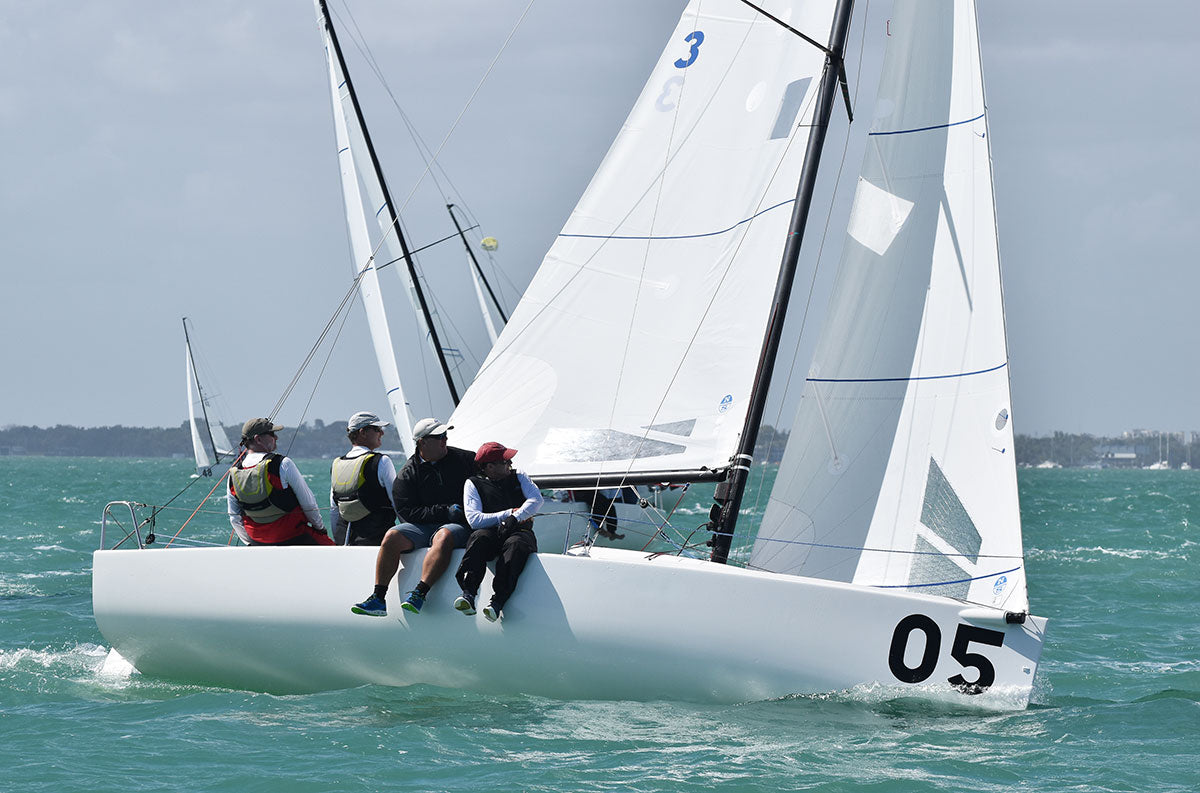
events
NORTH POWERS 1,2 AT THE J/70 MIDWINTERS
NORTH POWERS 1,2 AT THE J/70 MIDWINTERS
Following up on wins at the Davis Island Winter Series and North Americans, North customers win again – Jack Franco (Open Division) and Jenn & Ray Wulff (Corinthian Division)
Jack Franco’s 3Ball JT, 2018 J/70 Midwinter Champions
The J/70 has become one of the most competitive classes in one-design racing and North clients have consistently taken the top spot on the podium. In fact, North products have powered the winners of all three events at the US Winter Series and the North Americans, proving again that North has the fastest J/70 sails available. Jack Franco’s 3 Ball JT did it again last weekend in Miami, sailing to success in a 61-boat fleet with consistent single-digit race results in a variety of conditions. We caught up with North Sails’ Allan Terhune who sailed on the 3 Ball JT to learn what worked for them:
There were a few things we worked on diligently on the 3 Ball JT both during practice and also during the actual regatta to make sure it was a success.
Practice
We worked hard on two things during practice.
Have the maneuvers down. It is imperative to be able to turn the corners cleanly.
Do as many line ups as possible to have confidence in the settings – rig tune and sail trim. We have marks on everything to make sure the “fast” settings are repeatable.
Make practice pointed and concise. Its very easy to over practice leading up the event and end up being tired. Having a detailed plan and goals went a long way to getting the desired results from the sessions.
Great Starts are Key
We had great starts throughout the Midwinters, other than our BFD which happened on a general recall. The goal for is to identify a general area on the line where you want to be and then focus on finding space. It’s a team effort:
Bow guy calls time
Jib trimmer talks distance and speed control
Mainsail/Tactician calls on speed and positioning
Driver focus on the execution of the acceleration when it is time to go.
Sail Trim
Mainsail – Make sure the mainsail is trimmed in a way to help keeping the boat flat. De-power or power-up to keep the boat from heeling back and forth. This is crucial for good steering.
Jib – It is important to trim the North J-6 jib with the correct ratio of in-haul to leeward sheet. We sailed with the halyard a tad looser than normal so the jib was a little fuller to get us through the chop. When we needed to ease for power, we eased the leeward sheet not the in-haul. The only time the in-haul was eased was when the main started to luff. The J-6 proved to be a real weapon in the Biscayne bay chop.
See also: How to Trim Your J-6 for Max Speed
Steering
This is the hardest part of the boatspeed wheel and Jack did a great job for us. The groove is quite fine and it’s very easy to be too high, which is easy to identify as the luff of the jib will go soft and the inside tell tale is up. But the critical error is to be TOO LOW. The boat heels and doesn’t go any faster and you lose a lot of height if you get too low. This is common in chop. If the leeward tell tale is ticking hard, you are generally too low.
Remember it’s a team game.
We would not have had success without the four of us doing our jobs, communicating well and always working at it. There was never a down moment on the boat (Ok thats not true, the BFD penalty was a bummer) but we work hard on being positive and not letting any other team out work us. Keeping it light, communicating the important points and thinking the situations through will lead to great results.
2018 J/70 Midwinters
Open
1, 2, 4*, 5, 8, 9*, 10, 11, 12, 14, 15, 16 – Congratulations Jack Franco!
Corinthian Division
1, 4, 5, 6 – Congratulations Jenn & Ray Wulff!
* Denotes Partial North Sails Inventory
Jenn & Ray Wulff’s Joint Custody, winners in the Corinthian division
Joel Ronning and team Catapult, 2nd place at the J/70 Midwinters
Brian Keane, winner of the Davis Island Winter Series, flying fast at the Midwinters
John Brim’s Rimette, powered by North Sails
Will Welles’ Scamp, sailing with our sail designer Mike Marshall
READ MORE
READ MORE
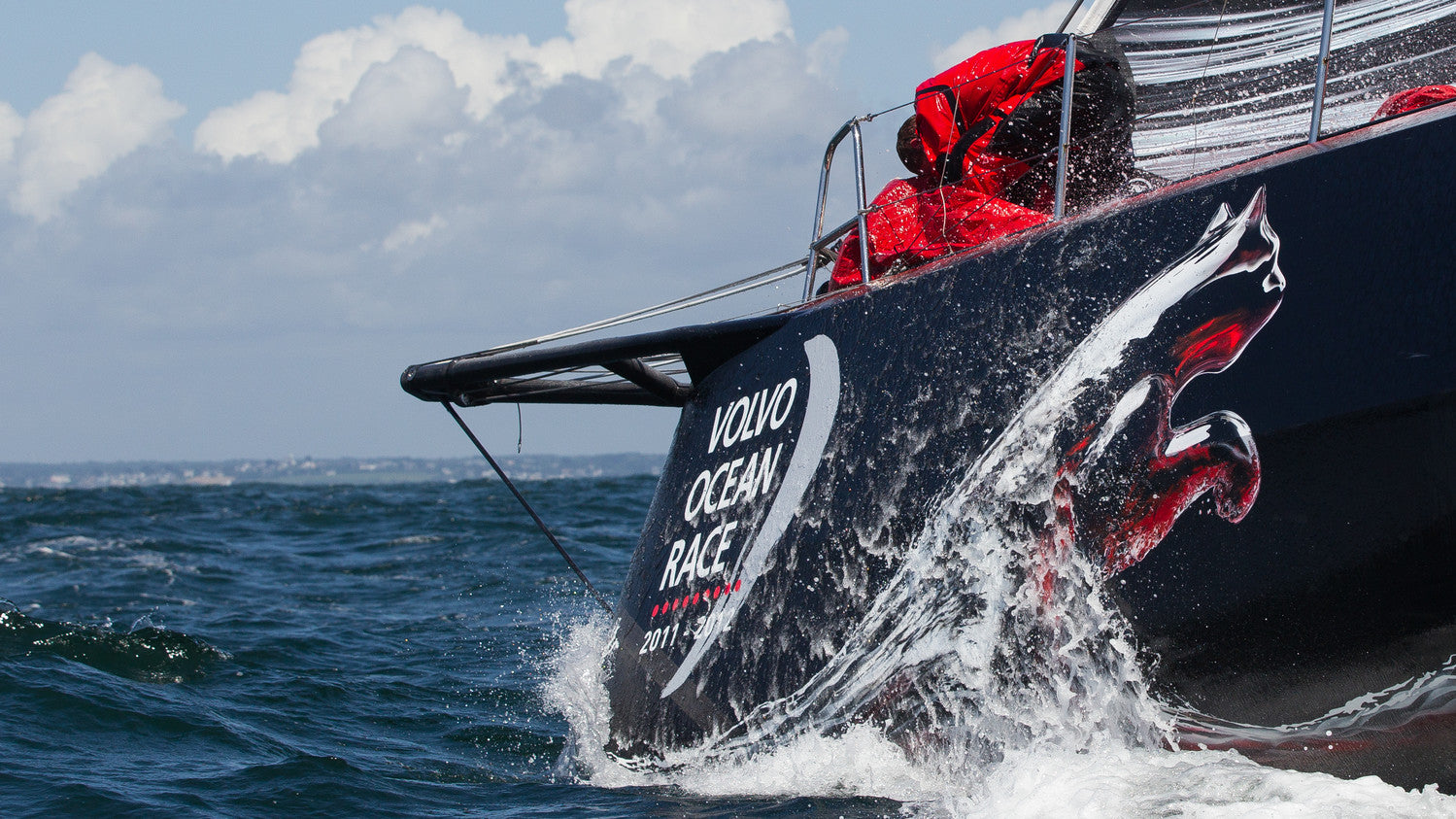
events
VOLVO OCEAN RACE: JUST ANOTHER YACHT RACE, ONLY LONGER
VOLVO OCEAN RACE: JUST ANOTHER YACHT RACE, ONLY LONGER
Around the World racing veterans from North Sails share their biggest lessons learned
What does an extreme event like the Volvo Ocean Race have in common with the distance racing most of us do? We asked race veterans (and North Sails employees) for lessons learned; read on for a few tips that just might help you on your next race.
The biggest screwups teach valuable lessons.
North Sails Vice President Kimo Worthington won the 1997-98 Volvo Ocean Race on EF Language
“On our first Southern Ocean leg from Cape Town to Australia, we didn’t have any idea what we were doing and we wiped out in a big squall, blew out our kite. We ended up in irons, and when I looked over the side the spinnaker pole had somehow wrapped itself around the front of the keel. Huge mess. Four hours of cleanup, and then we crashed another four times before the leg was over.
“As soon as we got into Fremantle, we had a very frank team meeting—not rah rah, but how did we screw up, how could we do it better? Instead of imploding, we decided to stack harder and farther back than anyone else. We also decided reefing was the key. Once we reefed, we could carry the kite in 40 knots of wind. By the time we passed Cape Horn, we were 500 miles ahead. That debrief was key to winning the race.”
Tune up with the fastest team before the start.
North Sails President Ken Read skippered PUMA Ocean Racing around the world in 2008-09 and 2011-12.
“MAPFRE and Dongfeng did something very interesting before this race. They both must’ve decided they were good enough to win a two boat race, so they trained with each other to create an even bigger speed advantage over the other teams. So now what you have is two arch rivals going out to play with each other. Tuning up beforehand is about three things: Time, money, and smarts. Time to do some serious training. Money to buy the best drivers. And then enough smarts to team up for pre-race training with the other top guys… that’s a pretty powerful combination.”
© Ian Roman / Volvo Ocean Race
Keep working with your sail designer to get faster.
North Sails Designer Mickey Ickert has worked with several Whitbread and Volvo Ocean Race teams, including 2005-06 winners ABN AMRO.
“Back when the Whitbread and Volvo were on the cusp of satellite communication, periodically I would get a call from the boat discussing the next sail or sail recuts to be made in port. In those days, the sails were consistently developed and updated by each team, with the aim to catch up or outperform the opposition. It’s a long race, with plenty of opportunity to learn and improve, so it was possible to outperform the early leader if everyone kept talking as a team with the designers.”
© Oskar Kihlborg Volvo Ocean Race
READ MORE
READ MORE
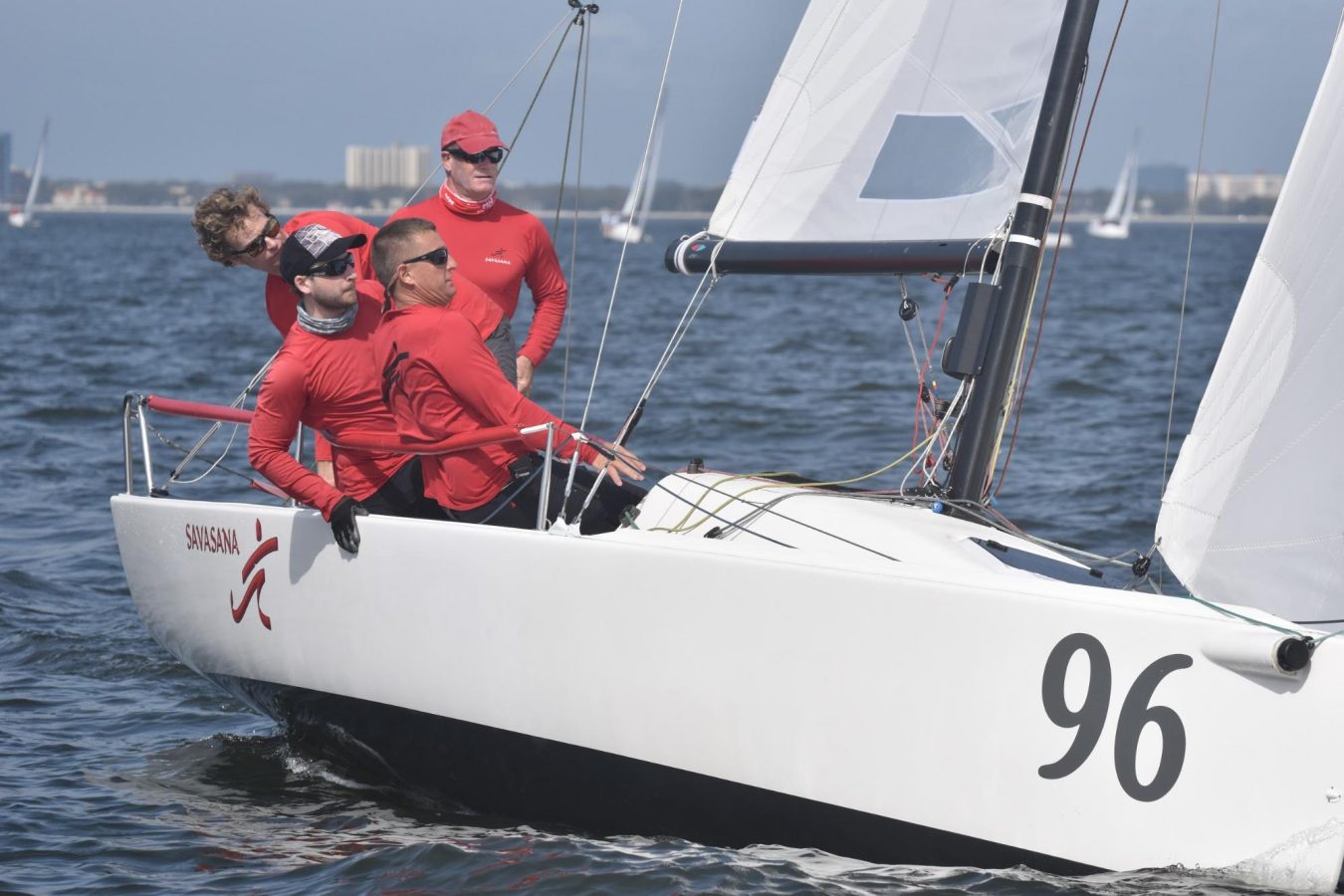
events
INTERVIEW WITH BRIAN KEANE, J/70 US WINTER SERIES CHAMPION
INTERVIEW WITH BRIAN KEANE, J/70 U.S. WINTER SERIES CHAMPION
North clients continue to succeed given the right tools for success
Team Savasana, US Winter Series champions powered by North Sails.
North Sails products are designed to be a tool for our clients to help them excel on the race course. North Sails has developed fast, user-friendly sails that give teams like Brian Keane’s a competitive advantage.
We caught with Brian after his race series win in Davis Island, FL where he sailed his way to success through a high level of competition in the US J/70 class. Each regatta result finish his team had totaled 7 points in the three-event series, and given one throw out he was left with only 4 points. Here’s what Brian had to say about his team, how they prepared for the winter series, and how they maintained consistency through three regattas, giving his team the overall series win.
NS: The entire series had all types of conditions. It was windy at the first event, shifty in the second, light air in the third. How did your team adjust to keep such great consistent results?
“We were pretty happy that we had a variety of conditions because it gave us a chance to test our tuning and boat handling across a wide spectrum. I think we felt pretty fast in all conditions, whether it was windy or whether it was light. I think the key thing is being smart and avoiding the costly errors. At the end of the day, we felt as fast as anybody, but the real key is not shooting yourself in the foot by making any major mistakes.”
NS: What are some things of most importance that you focus on going into each event given that you might have maybe a different crew every time?
“Yeah, we had slightly different teams, even in each of the three events. When you do that, it just reinforces the importance of being able to communicate effectively within the team, so if somebody’s out and somebody new is in, they can get up to speed very quickly.”
“Because we had a different trimmer in each of the three events, we made sure that we got there early >to practice. We spent about a day and a half practicing. And part of that practice is working on boat handling and our settings for different conditions, so everybody knows who’s doing what. The other part of that practice is then to make sure, from a speed standpoint, we are where we need to be.
As far as the actual racing is concerned, our goal was to get off the line in a clear lane. We had enough confidence in our speed that if we could get off the line sometime in the lower-density area and be able to hold for a few minutes that we’ll quickly be near the top of the fleet and we can just grind down from there.”
“Starts and minimizing risk I think are some of the key themes across all three events.”
North-powered boats finished 1,3,4*,5*,6,7 at the 2017-18 US Winter Series.
NS: Out of all three events, was there a race highlight, or a moment that stuck out that you remember?
“In event two on the windiest downwind leg- it was blowing like stink. We just killed it and extended dramatically on the entire fleet. That’s always fun. We won the race and won it by a lot. It was exhilarating. You know, I think back on it … I haven’t looked at all of our finishes, but I think one of the things I feel good about and was how consistent we were going into each event. I am not sure if we ever had a race out of the top ten, and that’s a sign that you’ve got speed and you’re not shooting yourself in the foot. You’re just always there and relentless.”
“That’s the kind of stuff that wins regattas, and wins a race series- it’s being consistent.”
NS: What advice would you give a new J/70 team?
“We sometimes call it “sail by the numbers.” We have a lot of data and we know exactly how we wanna set up for every condition. We’re not wasting time wondering what the right setup for the rig or for sail trim is as the conditions change. As the conditions change, we can look at our grid and we know what to do.
That takes a lot of the complexity out of it. So a new team should ask some of the other teams what they should be focusing on. “How do you think about rig setups, sail trim in different conditions?” Try and create your own map, your own grid, so you can sail by the numbers, so you can think about sailing and what you’re doing during the race, as opposed to trying to figure out how to make your boat go fast.”
NS: What were the biggest contributions to your team’s success this weekend?
“Smart decisions, tactics, strategy, where to start, and where to go.”
2017-18 U.S. J/70 Winter Series
Teams Powered by North Sails
Event 1
1, 3, 5, 6, 7, 8*, 9, 10 / Congratulations Brian Keane
Event 2
1, 3, 5*, 6, 7, 8*, 10 / Congratulations Joel Ronning
Event 3
1, 3, 4, 5, 6, 7, 8, 9, 10, 11, 12 / Congratulations Jack Franco
Series Overall
1, 3, 4*, 5*, 6, 7 / Congratulations Brian Keane and team Savasana!
* Denotes Partial North Sails Inventory
Max Nickbarg, Thomas Barrows, Brian Keane and Ron Weed.
READ MORE
READ MORE
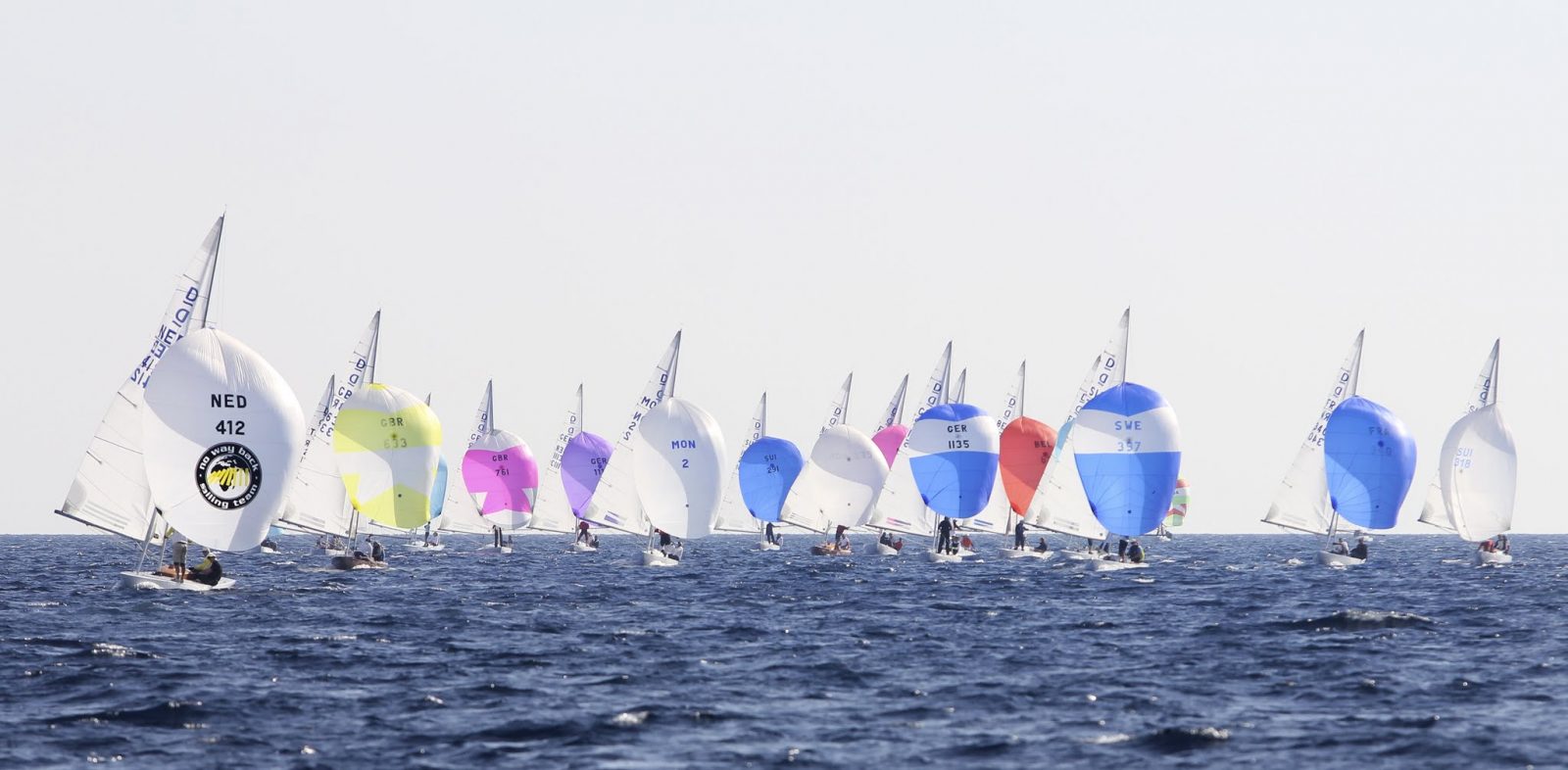
events
TIPS FROM DRAGON WORLD CHAMPION
TIPS FROM DRAGON WORLD CHAMPION
2017 World Champion Andy Beadsworth shares tips from his World Championship winning experience
© Jean-Louis Chaix
Andy Beadsworth is the reigning Dragon World Champion, and a well known name among the International Dragon Class fleet, he has multiple national and international titles under his belt. We spoke to Andy about his top tips for going around the race course and how he sets up his boat for a day on the water.
What are you looking for whilst setting up your mast on a race day?
The most important thing is to make sure the sail plan looks the same on both tacks. Although that sounds fairly obvious, it takes a massive amount of effort and work to achieve that and is one of the big things. We put a lot of time and effort into is making sure the rig is symmetrical on port and starboard tacks and basically every race day we go through the rig and check our base settings that we record. We are quite diligent in checking a length as well as a tension so that we have got a good record (of our settings) and that also something that we can check on the water.
What do you use to tune your boat on a race day?
On a daily basis we would look at the rig and the sails and adjust what we felt is necessary in order to achieve what we want on the day and to achieve the characteristic of the boat that we are experiencing. We constantly make the adjustments to achieve what we are looking for.
As you round the windward mark, what’s the most important adjustment to make?
The most important thing is to get the spinnaker up and set and the jib furled and then making sure all the sails are working as efficiently as possible, then getting the rig forward and remembering to let the ram off before the runners. Spinnaker up, sails set and pulling efficiently before all the small stuff. Generally we let the ram off down the offset leg to make sure it isn’t forgotten and make sure the mainsail tack go down the run.
And the same question for a leeward mark rounding, what are the important adjustments you make?
Make sure mainsail tack is on, the rig goes back and ram comes on preferably before rounding, so that for the exit of the mark you are sailing the boat as well as possible, especially as most people aren’t so there are big gains to be made. This is especially important when not doing as well as you should be, the leeward mark rounding is one are where you can make big gains just by being set-up precisely with the boat going as well as it can go.
With 2 more events left in the Cascais winter series, what advice can you give to the Dragon sailors competing at the event?
Set-up for waves, it’s a wavy venue! Have a set up that gives a powerful, twisted sail . It’s generally a windy, bumpy venue unlike some of the venues that we sail at in the Med so expect waves.
With a successful year last year under your belt, what are your goals for the team for the rest of 2018?
Personally, I would like to try and consolidate on the year and try and maintain our performance prior to speaking again at the worlds in 2019.
Thank you Andy for your time, we wish you the best of luck for 2018!
Looking to speak to an expert? Contact your local loft to find out more about our Dragon World Championship winning products.
READ MORE
READ MORE
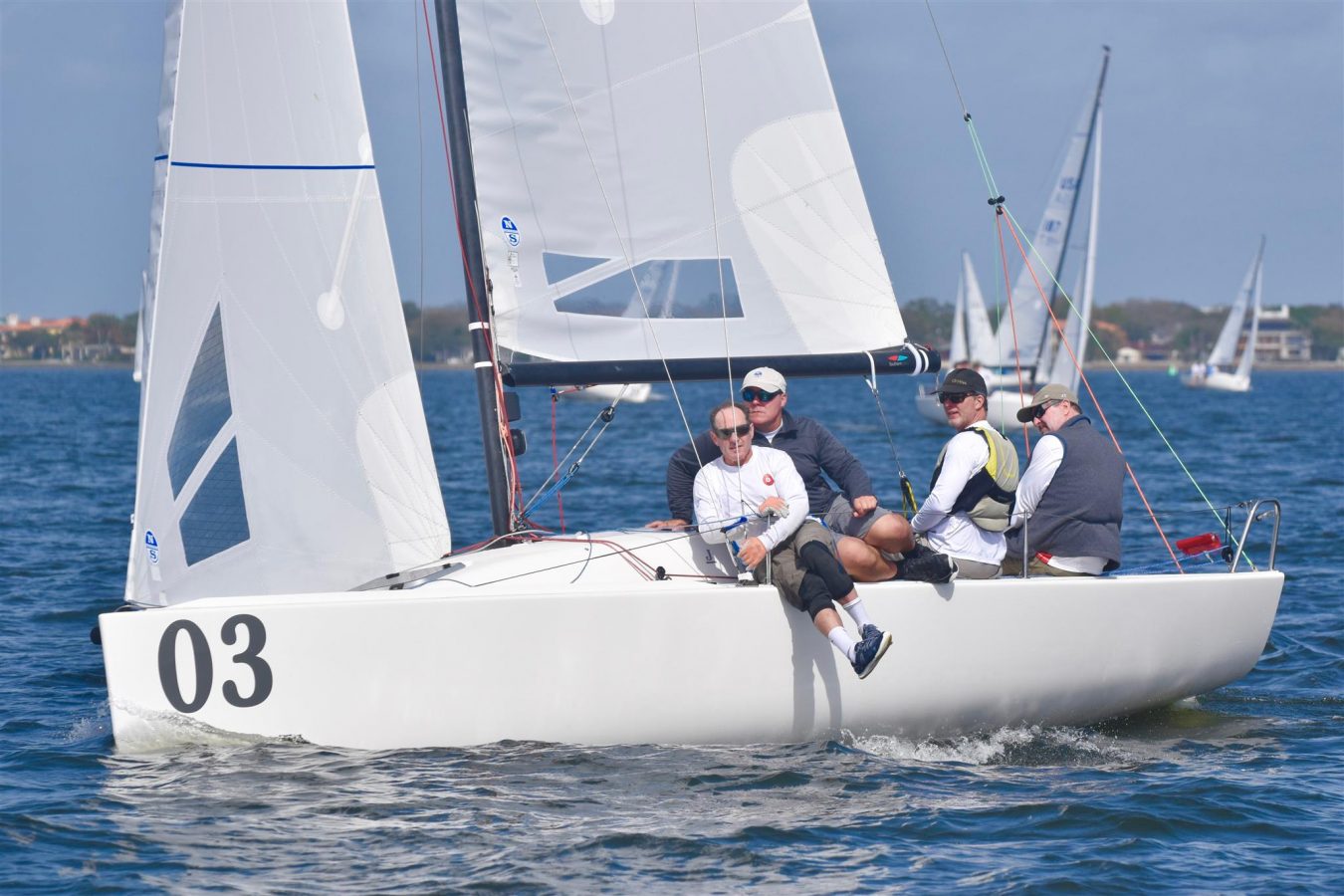
events
HOW TO SURVIVE LIGHT AIR IN A LARGE FLEET
HOW TO SURVIVE LIGHT AIR IN A LARGE FLEET
Challenging conditions, team Flojito 3JT had it figured out
The third event of the 2017-18 J/70 US Winter Series was sailed in light and shifty conditions. Even some of the best teams struggled with the unknown of when the next shift would happen, what would be the end result, and how they could set themselves up for the next puff without seeing it first. Some came out ahead, others had their worst finishes. Challenging conditions for all, but one team had it figured out and was confident in their strategy. Here are a few of the lessons learned by winning team, Jack Franco’s Flojito 3JT:
Crew Weight
The J/70 is very sensitive to weight placement and movement. Each upwind leg we work hard to get our crew weight as far forward, while sailing a lower angle and as maintaining as much balance as we could. The goal is to never let the boat heel too far either way. Ideally, it will have just a touch of leeward heel, which allows us the crew flatten hard, giving an acceleration, when each little puff comes down.
Going downwind, the goal is to use the weight to steer the boat as much as possible so that the rudder cannot create drag. This can be very effective. The spinnaker trimmer leads by talking to the driver and the rest of the team, orchestrating the movements to keep everyone on the same page and working the boat hard.
Starting – Critical in light air
We had to focus hard. At this event in particular, finding a spot on the line where there was the least amount of congestion as possible wasn’t easy, but it really paid off. Generally, you want to be on starboard at 1:15 and about 60 meters off the line. This will allow more control of your boatspeed, and allow you to manage your hole with more confidence. The goal in this case was to have space on our leebow, and to make sure that we are going full speed at the gun. Communication is very important during the final countdown. On our boat, the bow guy calls the time, the trimmer calls meters/ distance to the line, and the main trimmer/tactician is dictating the maneuver. The key is to make sure you are going full speed at go! If you get too close to the line, you have to slow down which is a killer in light air. If you are too far, you can’t get up to the line in time, which reinforces that 60 meters rule at 1:15 to 1:30, making it critical to be right on time.
Jib Trim
We sailed with the North J-6 this weekend. In the light air you want to make sure the halyard is soft to give the sail more depth and a little draft -aft. It is also critical to make sure there is enough inhauler-on so that there is enough shape in the foot, but not too much return on the leech. If we had too much return, the lead would be set further aft, or we just ease the inhauler a bit. From there, the adjustments are made with the leeward sheet to adjust the upper leech tension. Never let the leech telltales stall out. When a wave comes or if you feel a little slow, ease the leeward sheet, but not the inhauler. From our experience at the 3rd Winter Series, It seemed to work well.
Mainsail Trim
For light air, you want to set the main up with the traveler all the way up, and the sheet with enough tension to keep the telltales flowing. If you want to sheet harder to get more height, the traveler needs to be moved or dropped to leeward a car width so the lower leech doesn’t stall. The outhaul is not eased too much as we worry about the lower main getting too full and closing the slot with the jib since we were inhauling so much.
The big key is that light air is a finesse game
Little adjustments make a big difference and teams that move and communicate well together make large gains. The other thing to remember is that it is easy to get frustrated in light air. If you work hard at keeping the boat moving at full speed, the tactician has a much easier job putting your boat in the right place at the right time.
READ MORE
READ MORE
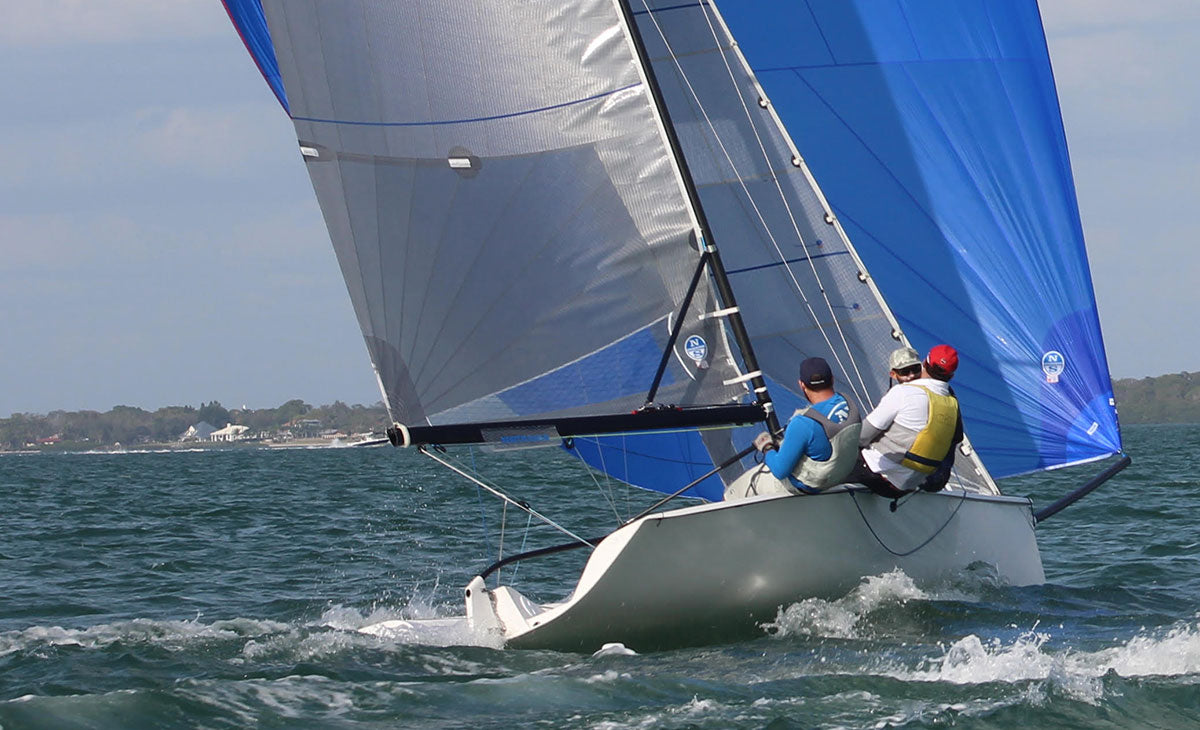
events
ZEKE HOROWITZ CLAIMS OVERALL VIPER 640 WINTER SERIES
NORTH SAILS’ ZEKE HOROWITZ CLAIMS OVERALL VIPER 640 WINTER SERIES WIN
Good starts and pure speed were keys to success in Sarasota
The final stop of the Sarasota Viper Winter Series finally delivered some beautiful conditions and 29 teams were able to complete eight races over the course of the weekend in 10-20 knots.
Physical stamina and technique were at a paramount as the big breeze punished any mistakes made by the teams. Without big wind shifts, starting and speed were key. North Sails clients finished strong, showing great consistency that allowed them to have spectacular overall finishes in the series.
We asked Winter Series champion, Zeke Horowitz, to share how he was able to sail upwind with great speed in the big breeze. Here is what helped him to the win the overall series.
“Make sure you know how many turns it takes to get to 40 on the uppers on your PT1 when you feel fully overpowered and set the lowers to show a hint of weather poke in the middle of the mast. Make sure to get at least 3.25″ of mast blocks in front of the mast. The name of the game is keeping the head stay as tight as possible and keeping a steady angle of heel. Playing the jib sheet along with the main sheet (using heavy vang) helps with both of those key elements. Keys for downwind sailing are conservative boat handling (sets, douces, and jibe) and active crew weight. Having the crew weight move out and back when you get the ‘knock down’ puffs helps keep the rudder in the water and the bow down. Don’t underestimate the power of good puff calls from the crew! If the team knows the puff is coming, they’ll be ready to react quickly.”
Learn more about the fastest Viper 640 sails. Contact our experts today for any additional questions you may have.
2017-18 Sarasota Viper Winter Series
Overall
1
Zeke Horowitz
3
Jay Rhame / Peter Beardsley
5*
Paul, Ken, and Karl Kleinschrodt
6
Jonathan Nye
7
Robert Harrison
8
Mike Dowd / Will Stocke
9
Geoff and Mary Ewenson
* Denotes Partial North Sails Inventory
Jake Doyle, Zeke Horowitz and Brendan Healy, overall winners of the 2017-18 Viper 640 Winter Series. Missing Ian Coleman who also sailed with Zeke in the first two events.
READ MORE
READ MORE
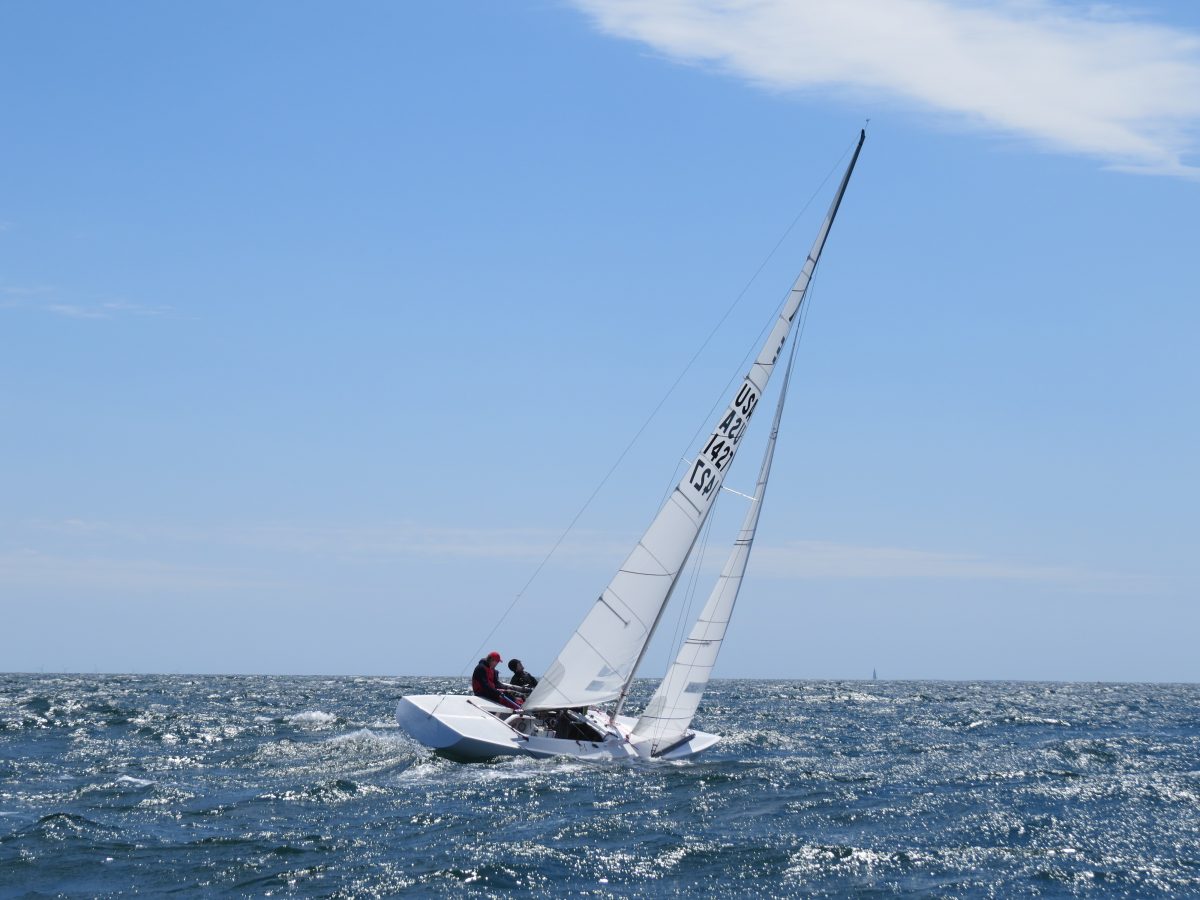
events
2018 ETCHELLS FLORIDA STATE CHAMPIONSHIP
2018 FLORIDA STATES DOMINATED BY NORTH CLIENTS
North Sails Powers Nine out of the Top Ten Finishers
The 2018 Etchells Florida State Championship was like an instant replay of prior Biscayne Bay Series events: big breeze, rain, and some serious wind chill. Although conditions were in the upper range, the upwind and downwind legs were exciting, but not as exciting as the mark roundings. Unfortunately for some, escaping without incident was nearly impossible. This stressed the importance of being in the front of the fleet.
We caught up with our Etchells expert, Skip Dieball, who raced onboard War Canoe. Here are some tips from his weekend experience:
“From my perspective with boat set up, I learned that you could get away with setting up the boat asymmetric based on the wave patterns. The main needed more twist to provide a nicer groove for the driver while going into the waves. Conversely, when sailing across the waves, you could get away with slightly harder main trim to give you more height without fear of slamming waves”.
Sunday was glamour sailing. 80 degrees, sunny and a more civilized 7-10 knots of breeze. Getting off the line was particularly difficult as the fleet bunched up towards the pin end. The current was pushing teams over the line, which forced the RC to start with the U-flag, which soon became the black flag in order to get races completed..
“Our team went for “low density” and this allowed us to remain consistent throughout an otherwise inconsistent day”.
Congratulations to Lawrie Smith and team Alfie and all teams powered by North Sails products. Contact our experts today.
2018 Florida State Championship
1
Alfie / Lawrie Smith
2
Scimitar / Steve Benjamin
3
Lifted / Jim Cunningham
4
America Jane II / Scott Kaufman
6
Gumption 3 / Kevin Grainger
7
KGB / Senet Bischoff *
8
War Canoe / Michael Goldfarb
9
Tiburon / Dirk Kneulman
10
Swedish Blue / Ante Razmilovic
* Denotes Partial North Sails Inventory
READ MORE
READ MORE
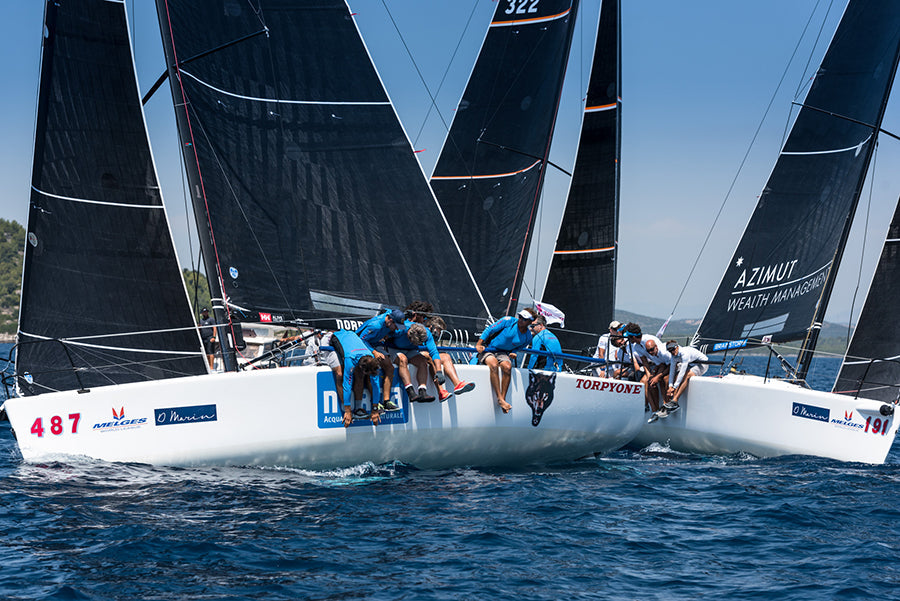
events
NORTH SAILS COMPLETES SHIFT FROM 3DL TO 3Di PRODUCT LINES
NORTH SAILS COMPLETES SHIFT FROM 3DL to 3Di PRODUCT LINES
Increased manufacturing capacity in Minden (Nevada, USA) and Sri Lanka focuses on 3Di sails output for small boats
The beginning of 2018 marks a milestone for North Sails as the company completes a 10-year transformation from 3DL string laminates to 3Di molded composite sail structures. North Sails was at the forefront of the mylar and yarn laminated construction wave with its groundbreaking 3DL sails. 3DL sails dominated performance sailmaking from the early 1990’s until the 2007 America’s Cup. With the shift to 3Di, the company ceased production of laminated sails reliant on mylar and is fully committed to the spread filament, prepreg, 3D composite structures. Three dimensional, full-scale shape molding remains a cornerstone of the North Sails approach.
3Di structures were first trialled by the defender syndicate, Alinghi in preparation for their defense in the 33rd America’s Cup. Since those early days, the 3Di concept has been developed and expanded for use across all types of sailing, from grand prix to one design and Superyachts to cruising. Today’s 3Di sails deliver greater shape-holding properties and vastly improved durability compared to any mylar and string, laminated sail construction. As the 3Di product line has gained acceptance, and in particular with the introduction of 3Di NORDAC for smaller cruising boats and 3Di RAW 760S for smaller race boats, North Sails has taken steps to increase production capacity.North Sails has systematically converted their manufacturing facilities in Minden, Nevada, and Sri Lanka as the product line has shifted from 3DL and paneled to 3Di. As of September 2017, the last 3DL production line was shut down and both factories are running exclusively 3Di product lines. Today North Sails has identical prepreg converting lines in both the Minden and Sri Lanka factories running 14 shifts per week, with seven Automated Tape Laying (ATL) lines running 24/7 in Minden and five lines running 24/7 in Sri Lanka. The prepreg converting and ATL lines feed a combined eight gantries and 10 full scale, adjustable 3D molds. North’s facility in Sri Lanka focuses on building 3Di sails for boats up to 50’, while Minden specializes in Grand Prix and Superyacht sails.
© Ben Zucker
Commenting on the evolution of the production strategy, North Sails CEO Dan Neri stated, “The expansion of the Sri Lanka factory is in response to the successful launch of 3Di RAW 760S sails for smaller race boats and 3Di NORDAC for smaller cruising boats. 3Di sails continue to meet the requirements of sailors in all classes from the 18′ Skiffs in Australia to the 100′ Ultime fleet in France. The technology is behind an unprecedented number of race victories and world records and we hope many more cruising adventures as 3Di NORDAC becomes more established within the cruising community.”
“The 3Di sails from North have been excellent. 35,000 NM usage. Give it a new paint job, and I bet if you would ask anyone, they would say this is a brand new main. It’s the same for the other sails. You can see they’ve been used but they are still in good shape. This mileage would be a lifetime for the average cruiser. I know what I would buy.”
-Bouwe Bekking, Team Brunel
3D Minden is the flagship center for materials research, engineering and manufacturing of 3-Dimensional products which are unique to North Sails. Sri Lanka Manufacturing is a wholly owned, state-of-the-art, facility employing close to 1,200 people across eight buildings. The products from Minden and Sri Lanka are sent to every port in the world.
North Sails proudly employs a 72-person strong global design and engineering team. The R&D team ensures North Sails uses the best processes and the best in raw materials. If the best does not exist, we create it.
© Amory Ross
READ MORE
READ MORE

events
WORLD CHAMPION SAILOR ALLAN TERHUNE, JR. RETURNS TO NORTH SAILS
WORLD CHAMPION SAILOR ALLAN TERHUNE, JR. RETURNS TO NORTH SAILS
Terhune to focus on customers in Annapolis and Chicago
(Annapolis, MD) February 1st 2018: Allan Terhune, Jr., who first joined North Sails in 2007, returns to the North sales team to provide world class expertise to customers. North’s head of One Design Vince Brun first recognized Terhune’s raw talent and originally recruited the young racer, who has notched up eleven North American Championships (in the Lightning, Flying Scot and Thistle Classes) and was crowned the 2013 J/22 World Champion. After six years with North honing his skills in the loft and on the water, Terhune subsequently joined Quantum in 2014, but the champion sailor is now returning to join the world’s leading sailmaker in what promises to be an exciting year for the respected One Design expert.
Commenting on his return to North Sails, Allan Terhune, Jr. said;
“It’s a huge opportunity to work with the amazing team at North Sails and grow in the sport, and I’m really excited to work with both Jonathan Bartlett and the Annapolis team, as well as with Perry Lewis and the Chicago team. When you want to sail at the top level of the sport and raise your game, you want to have the best gear and equipment, and there’s no denying that the North Sails network and product offering is the best in the industry. I’m looking forward to being able to offer my customers more opportunity for success and help them enjoy their time on the water with North Sails products.”
Allan will join the Annapolis and Chicago teams with special focus on Offshore One Design while still helping with traditional small boat One Design, which is Allan’s speciality. He will continue working with clients in J/111, J/70 and J/88 Classes, plus expanding into J/121 and other projects.
Terhune is a resident of Annapolis, MD and graduate of the US Merchant Marine Academy. In 2007, Terhune was awarded US Sailing’s One Design Leadership Award and named Rolex Yachtsman of the Year Finalist in 2008 and 2013.
READ MORE
READ MORE
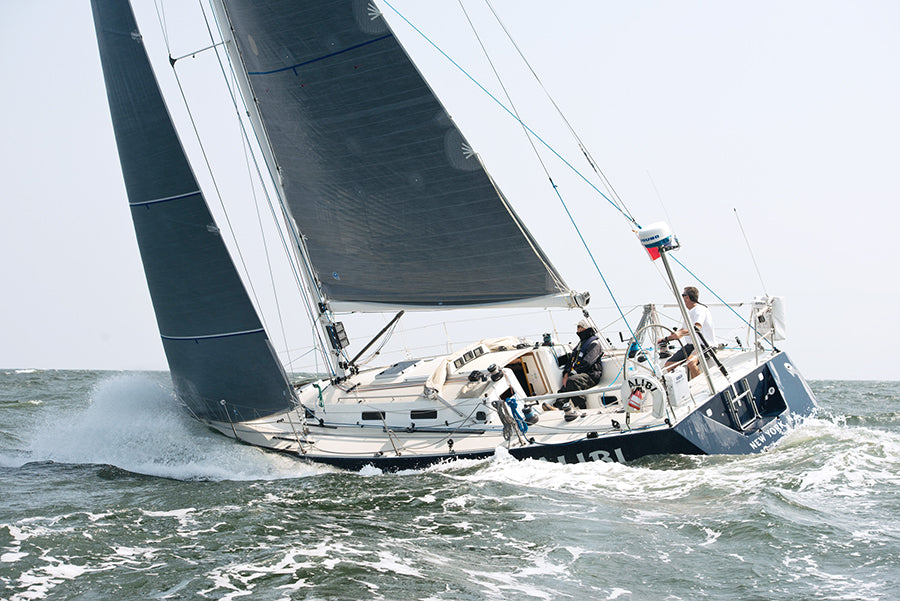
events
THE PERFECT ALIBI
THE PERFECT ALIBI
Powered by 3Di, Gary Grant takes on doublehanded sailing
© Photoboat
Gary Grant races his J/120 Alibi doublehanded and regularly beats fully crewed boats in major long distance races. Here’s what he had to say about his sails, his racing program, and his plans for the future with the help of his North Sails expert, Tom Castiglione.
When did it all start and what have you won recently?
I bought Alibi new in 2004 when I lived in London. My first boat was a 32-foot cruising boat, which didn’t allow me to race, so I got the J/120 which gives me great opportunities to compete.
In the 2015 Halifax Race, we were first in our division and in class against four fully crewed J/120s. We had a 2nd in the Block Island Race and the Vineyard Race, and we also won Stamford Yacht Club’s doublehanded racing trophy for that year.
Who’s your partner in crime?
Stephen Fisk is my primary crew. We started sailing together in 2005. Stephen was a member of my yacht club, and I heard he had a lot of experience in distance racing and on the J/120. Both of us really enjoy sailing together, and we both enjoy sailing doublehanded. We wanted to try something different, and we enjoy it so much we haven’t given up.
© Photoboat
What’s it like competing against fully crewed teams?
We do well in light air against the fully crewed boats, but when the moderate to heavy air conditions come up we lack weight on the rail. We use the autopilot when my help is needed up front, and as the sea-state picks up, it isn’t as effective either. So the light to medium wind range is our preference.
In the 2013 Block Island Race, we beat fully crewed J/120s. In 2017 we won the doublehanded PHRF award, even though we got third in our division on corrected time. My boat is a bit different from some of the other J/120 teams, as we have a carbon mast and they have aluminum masts.
When did you know you wanted to make the switch to 3Di?
In 2004 I had a suit of 3DL sails, but after about 3 years they started to deteriorate. I decided I wanted to go with something bulletproof, so I reached out to my local loft and got the details from Tom on 3Di and knew that would be the right choice for my program.
“After seeing the success of 3Di in the TP52 class and in the Volvo Ocean Race, I knew it was going to be the right move. I needed a set of sails that wouldn’t deteriorate on the shelf and was going to be reliable year after year. Doublehanded sailors need robust sails, as it’s hard to change sails without flogging or luffing, and we are often pushing our sails above their designated wind ranges.”
What are some advantages of 3Di for doublehanded sailing?
For sail changes, the sails get more wear and tear naturally since we are short on crew and it takes a little more time to make changes. They luff a bit longer than they would if we had a full crew to take them down. The J/120 is a stiff boat, and we often push the #1 pretty hard, especially in the reaching position just because it’s hard to make changes on that point of sail.
The greatest advantage of having 3Di is that when you get them set up they don’t stretch. It’s a major factor for doublehanding the boat. When you are alone on deck you are always thinking “would the boat be faster if I was steering or trimming?” You may spend less time trimming being alone on deck when your crew is sleeping or eating.
“The 3Di has been great for us, they are bulletproof and look just as good today as they did when I got them in 2014.”
Gary commented; “Doublehanded sailing has gotten more popular in distance racing. 3Di sails are perfect for distance racing in general, and especially in doublehanded or shorthanded sailing because they are durable and they hold their shape perfectly once the sheets are set. It really makes a big difference. They can handle the flogging and uncontrollable luffing that occurs when it takes a more time to execute a maneuver, especially when we only have only two sets of hands.”
If the sea state doesn’t allow you to leave the helm, how do you go about making sail changes?
If we have to do a sail change, we pick a point of sail that the autopilot can handle well, and go from there. Under the mainsail alone, the autopilot does the best. With an asymmetrical the angles become critical, so you end up oversteering with the autopilot.
“When we go offshore we take off the roller furler and use our 3Di hank-on sails. It is just easier for us. With the hank-on option, the sails practically flake themselves as they come down and it saves us time and manpower.”
Do you have any “memorable” moments sailing shorthanded?
We’ve had our fair share of wipeouts and spinnaker wraps. Fortunately, the boat is pretty well behaved so when it does go over, it happens slowly then comes right back up again, so it hasn’t been too bad.
A memorable moment was the 2013 Block Island Race, when we got the overall award for our division the year Rambler broke the course record. After the awards, I went up to the PRO and asked why they didn’t give it to Rambler. He replied,“Rambler doesn’t race against anyone, and you are in one of the most competitive fleets.”
In that particular race, the wind was perfect for us. We started out with the Jib-top reacher and came back in with the A3. The wind was around 18-22 knots. Around 2 AM we put the kite up to sail around Block Island, and the shackle on the sheet came off and all of a sudden we had the kite blowing all over the place. We were trying to get it down and it wrapped around the headstay. I set the autopilot and we barely got the sail down in time (5 miles later!) to put the jib up. We ended up not losing any ground at all, as it was perfect timing. When it’s windy and we both have to be on the foredeck, it can be a little crazy. We pick angles so if the boat gets caught we don’t roll into a jibe. We always set the autopilot so we would round up, as opposed to a crash jibe if she got pushed by a wave. The worst that could happen is we get a wave over us, that’s why we have our gear on and we are always clipped in.
© Photoboat
How did Alibi get her name?
I’m a lawyer by training so it’s a good name for the boat. It’s not an excuse, which most people think when they hear the term. It means you couldn’t have done what you are being accused of because you were not there.
“If I’m on my alibi, I can’t be doing anything wrong.”
What is different about preparing for a doublehanded distance race vs. a normal fully-crewed distance race?
It’s like tag-team sailing. When one crew is sailing the boat, the other is down below. I have a different way of setting things up on the boat from what Steve does. After criticizing each other and trying to improve each other’s trimming styles, we’ve optimized our techniques together and now we sail more consistently, which has resulted in more consistent results.
Do you have a plan if something goes wrong?
That’s one of the reasons I knew I had to get my 3Di sails to hank-on. In 2012 I was on deck sailing the boat alone and Steve was down below. I had the #1 up and all of a sudden the wind went from 12 knots to gusting over 30. I had to wake Steve up while driving and flogging the sails until he was up on deck. We both had to go forward and we got soaked. That’s when I decided I didn’t want to do that again.
In 2014, the wind came up and we had to change from a # 1 to a #3 quickly. Steve was down below. I said, “bring the #3 when you come up!” I opened the halyard for the #1 and easily brought it down on deck, It flaked on its own. We did the sail change in just three minutes and it worked really well. The hank-on 3Di sails were exactly what we needed.
What’s next?
This year we have the Block Island Race, then Bermuda. We may do the Vineyard Race. Longer term we want to bring the boat down south to do some winter racing. I’ll be doing the Caribbean 600 this year on a friend’s boat, and hopefully will be able to get my boat down there for next year. The J/120 I think would be a good boat to sail in the Caribbean circuit since there are more reaching opportunities with island sailing. In given wind conditions I think we would do quite well.
Out of all the events you’ve done so far, what is your favorite?
All the races are fun. They are all different. My favorite race is Newport to Bermuda because there is so much excitement and anticipation in Newport, and a very competitive fleet to race in. The top sailors are out there. The Bermuda Race is like three races in one. You start in Newport and it’s cold on the boat. Then you get into the Gulf Stream, and the only thing predictable is that the sea state is very confused. It’s an incredible climate change. When you get out you are close to Bermuda; the humidity drops, the water changes colors, it’s the perfect conditions for sailing.
How was your experience working with your local North Sails expert?
I knew what I wanted to do, and Tom is very familiar with the J/120 so he helped me create the best options. My first set came with the idea of doing Bermuda, so my first #1 is a bit beefier, with a slightly smaller LP, as we sometimes have to carry it above the stated wind range. It’s a little slow in Long Island Sound in light air, but for Bermuda it was right. I also have a lighter #1.
One of the great things about working with Tom is that we’ve done tweaks with the sails like the Code 0 to make things easy for the type of sailing I do. Tom really knows how the boat is sailed and understands that I have different configurations for each division I am competing in.
“Tom has optimized my sail options for the different races I do. It’s working out very well and I’m equally competitive with other boats. It takes a lot of understanding of how to sail the boat, conditions, and handicap systems to make it all work and he gets it.”
© Photoboat
Interested in North Sails 3Di? Contact your local expert today!
READ MORE
READ MORE
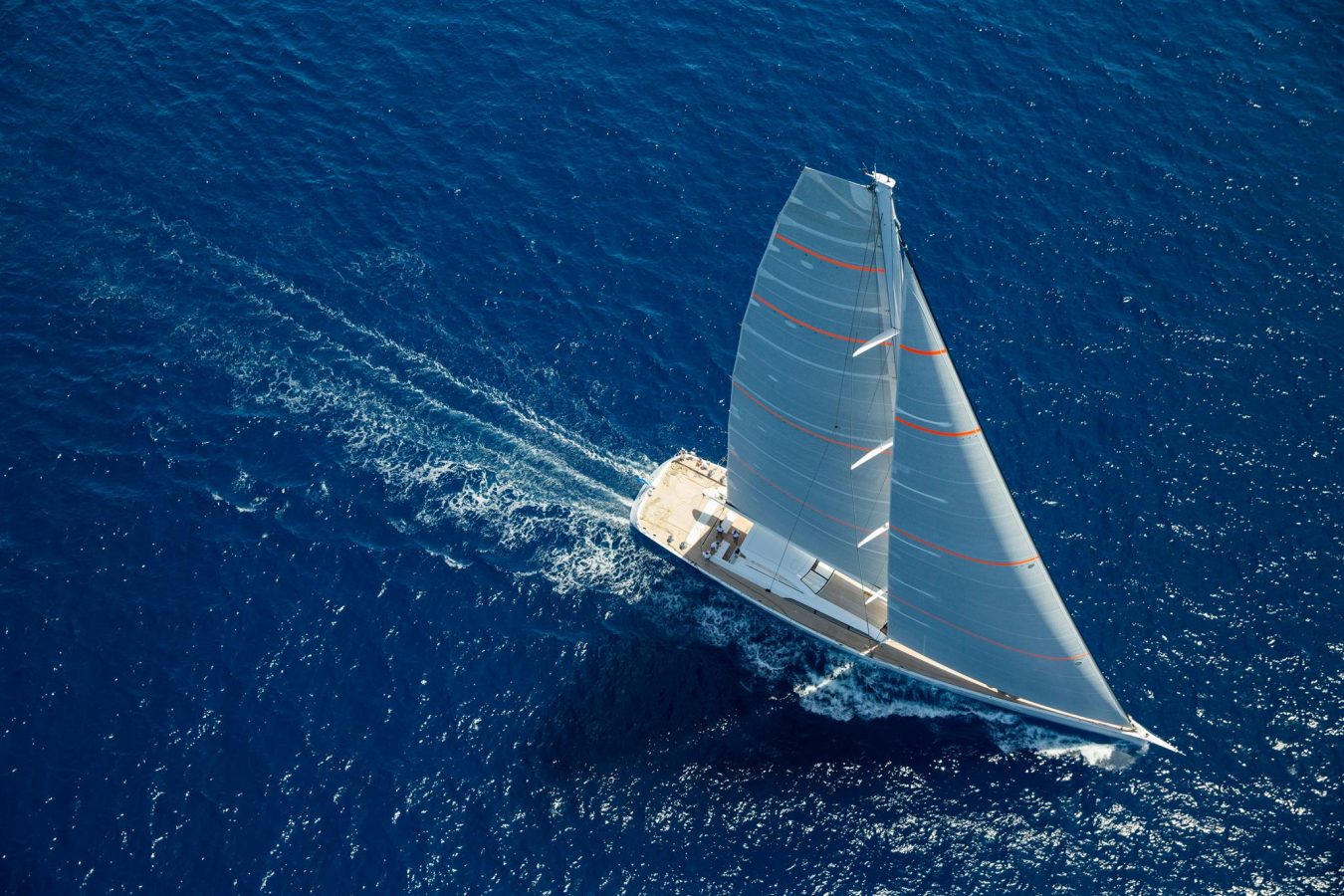
events
PALMA SUPERYACHT EXPERT JOINS NORTH SAILS
PALMA SUPERYACHT EXPERT JOINS NORTH SAILS
Quinten Houry joins North Sails in Palma to offer customers unrivaled products, technology, service, and expertise
North Sails today announced that Quinten (“Quinny”) Houry has resigned from Doyle Palma and has joined North Sails. Furthermore, Doyle Palma informed North Sails that they have given notice to Doyle Sails International LTD to terminate their license agreement. The former Doyle Palma business will become a wholly owned loft within the North Sails Group once the 90 days notice period has been completed.
Quinny is part of dynamic team of experts including Fiona Bruce and Russell Thom, all of whom are amongst the leaders in their fields within the Superyacht community. The consolidation of operations, personnel, and expertise in Palma strengthens North Sails presence in the heart of the European Superyacht community.
“Over the last seven years our loft and North Sails have competed on and off the water but with a common initiative of providing the best service to our customers” commented Quinny. “My thinking and approach to sailmaking are in line with the North brand, and I am proud to join a company who shares the same vision. Joining forces merges our wealth of experience and knowledge, and will strengthen our global Superyacht support and products. Beyond service, North is unique with their offering of 3Di. Their technology is innovative and intelligent, and I am looking forward to offering the industry-leading product to my clients.”
“Quinny joining North Sails adds another Superyacht expert with a wealth of experience to our team,” commented Scott Zebny, Superyacht Sales Manager based in Palma. “He is passionate, customer-focused and is highly respected in the Superyacht circuit. I admire what Quinny, Fiona, and Russell have achieved as our competitors and it’s a big win for North Sails to have them join our team.”
“We firmly believe that the thing that matters most in our business is the client,” said North Sails President Ken Read. “Quinny, Fiona, Russell and their entire team share our “customer first” mentality that is the bedrock of North Sails. Combine this ethos with the longevity, weight savings, strength and overall performance that our revolutionary 3Di product line gives all styles of sailing yachts, and you have an unbeatable package that our customers will love.”
Backed by over 60 years of experience, North Sails is the market leader in the Superyacht world. North’s team of Superyacht experts utilize design and product innovation to find solutions to outfit the world’s largest yachts. The North Sails network includes seven wholly owned manufacturing facilities and 110+ Certified Service Centers, including 16 dedicated Superyacht service lofts. Superyachts rely on this global network of North Sails experts to actively support their adventures and, the addition of Doyle Palma will deliver an enhanced service standard for even more clients.
© Stuart Pearce
READ MORE
READ MORE
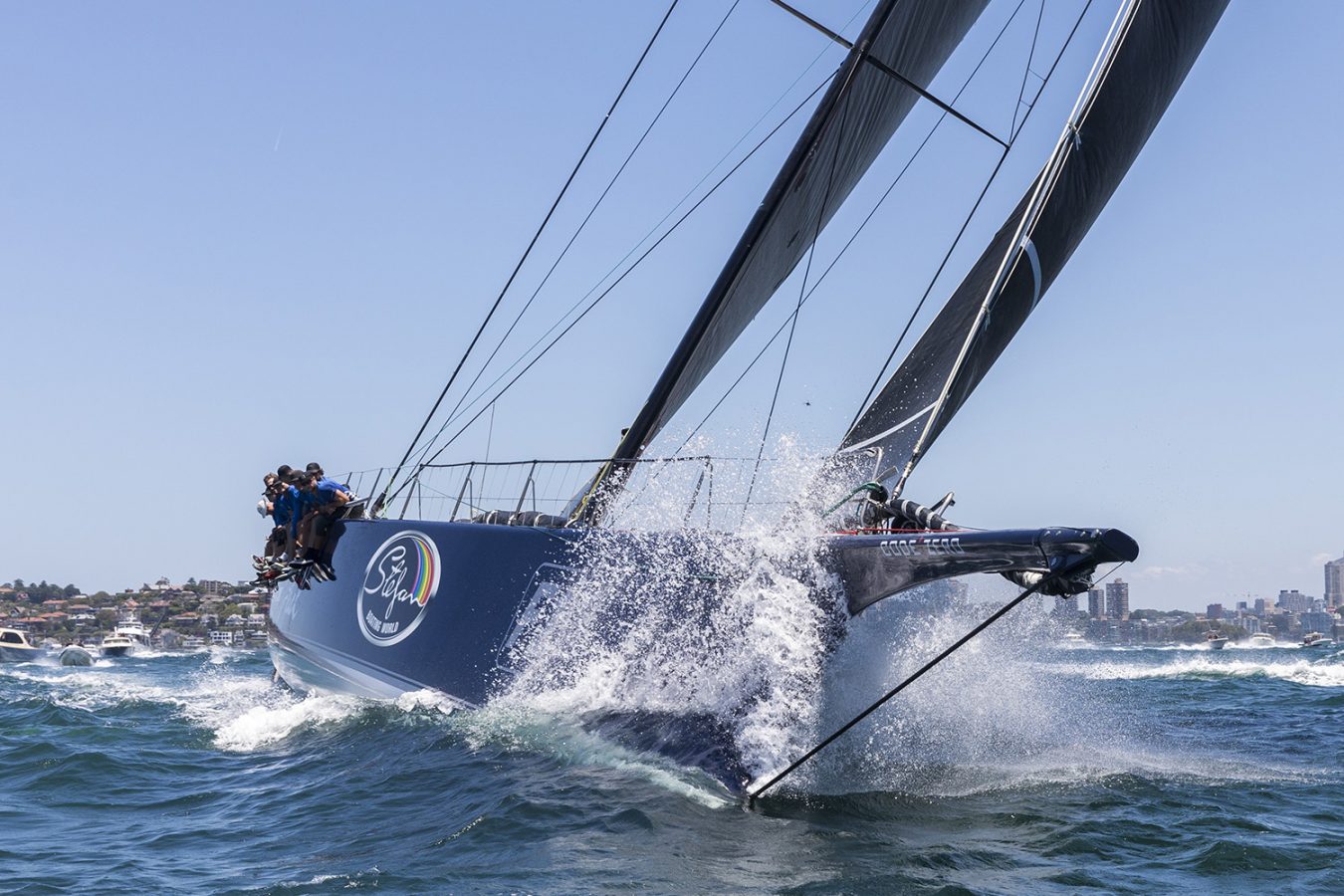
events
SYDNEY HOBART : REFLECTIONS
SYDNEY HOBART : REFLECTIONS
Clients share their experiences in the 628nm race to Hobart
Clients reflect on their 628 nm race to Hobart from Sydney Australia in one of the most grueling yacht races in the world. Here’s what they had to say about the race, their crew, and their sails.
Alby Pratt- Infotrack -Juan K-100-Christian Beck Supermaxi Infotrack, formerly Loyal, was the Sydney Hobart record holder in 2016. 2017 was the first Hobart for new owner Christian Beck. The heavy running conditions did not suit the boat as well as last year’s reaching did, but a great crew lead by Tom Slingsby pushed the boat hard and kept the big black bus right up there with downwind flyers such as Wild Oats, Comanche and Black Jack. Infotrack broke her record from last year, further proof of what incredible conditions we had for the race. Look out for this boat! © Andrea Francolini
Aaron Cole – Concubine – Mills 45 – Jason & Shevaun Ward The Concubine team enjoyed what was probably the fastest ever trip to Hobart on a 45 foot yacht: 1 day 23 hrs 19 mins for 630 miles! We had amazing conditions, three sail reaching that turned into fresh VMG running from late the first afternoon all the way to Tasman island, and then a fast reach across Storm Bay. Good sail management and some well-timed big eases on the kite sheet meant we never damaged any sails during the race, which was absolutely key to a great result. Going by the talk at the Customs House Hotel,. not many teams could say this! Thanks to Jason, Shevaun and the team for a great ride to Hobart. © Rolex / Studio Borlenghi
Billy Sykes -Ichi Ban TP52 -Matt Allen (cut from web article) Matt Allen, a long-time North Sails customer, first won the Rolex Sydney Hobart Race 34 years ago. In 2017, he finally repeated the achievement on Ichi Ban when they were named overall winner of the Rolex Sydney Hobart Race. It was a fitting honor for a boat whose name translates to “number one” in Japanese. The win this year was even sweeter considering that Matt’s new TP52 is only three months old, which always brings the opportunity for things to go wrong because gear has not been tried and tested. But we managed to put all those things behind us and come away with the win for Matt, which was a great thing. © Carlo Borlenghi / Rolex
Matiu Te Hau -Triton- LC60 – David Gotze The Triton crew had very little time on the water together, but we came together really well during the race. The new main came through some heavy air gybes at night. A couple highlights: doing the race in under two days, passing four boats on the run up the Derwent, and sending it in 25-30kts and flat water. @Rolex/ Borlenghi Studios
Ian Johnson- Extasea -Paul Buchholz It was a great ride south on the DK 46 Extasea. The downwind boats soon left us in their wakes, but we had plenty of company with a fleet of Clipper boats shadowing us all the way to the finish. On our last night we ended up with a 25 knot southerly, testing the new heavy 3Di jib designed for ocean conditions. When the cold front quickly faded, we were becalmed off Tasman Island for several hours. I love seeing Tasman Island and it is always a highlight, though I was wishing for it to go away! Thanks to all the team and owner Paul Buchholz for a great race south. © Rolex / Carlo Borlenghi
Nick Beaudoin -Patrice – Ker 46 -Tony Kirby This year’s edition of the annual Sydney to Hobart yacht race was one for the record books. Many could not believe that for a second year in a row, hard running would dominate the majority of the race. As we rounded the sea mark, the crew set our new 3Di cable-less Code Zero and triple-slotted our way south. The breeze eventually backed and we peeled to an A2, then promptly changed to the A4 as the pressure filled in and pushed hard down the south coast all night. Crossing the Strait the following day was champagne sailing, as we peeled back and forth between masthead and fractional spinnakers. Along the East Coast of Tasmania, the clouds and the sea mist rolled in and made for a stressful night of hard running. When we rounded Tasman Island at first light, we were ahead of many larger boats. The excitement soon faded along with the breeze as we slowly made our way across Storm Bay, and then up the Derwent to finish strong. Tony Kirby was overjoyed with a Division 2 win, 3rd place overall, and first in the prestigious Blue Water point score. © Andrea Francolini
Mark Bradford- Blackjack- RP100- Peter Harburg The 2017 Sydney to Hobart lived up to its nickname as “The Great Race.” Thanks to some slick crew work, boat speed and tactics, we had a fantastic start and led out of the heads. Unfortunately the first part of the race was stability sailing, giving the upper hand to Comanche and Wild Oats. A boat speed race decided the turning positions at Tasman Light. In the tricky last stages, we felt we were still close enough to the action to pull things back but fell just a bit short. A fantastic result for our team, posting the third fastest time ever and breaking the previous record. I highly recommend this race to anyone who has a keen interest in the sport of sailing and a sense of adventure….We will be back next year! © Andrea Francolini
READ MORE
READ MORE
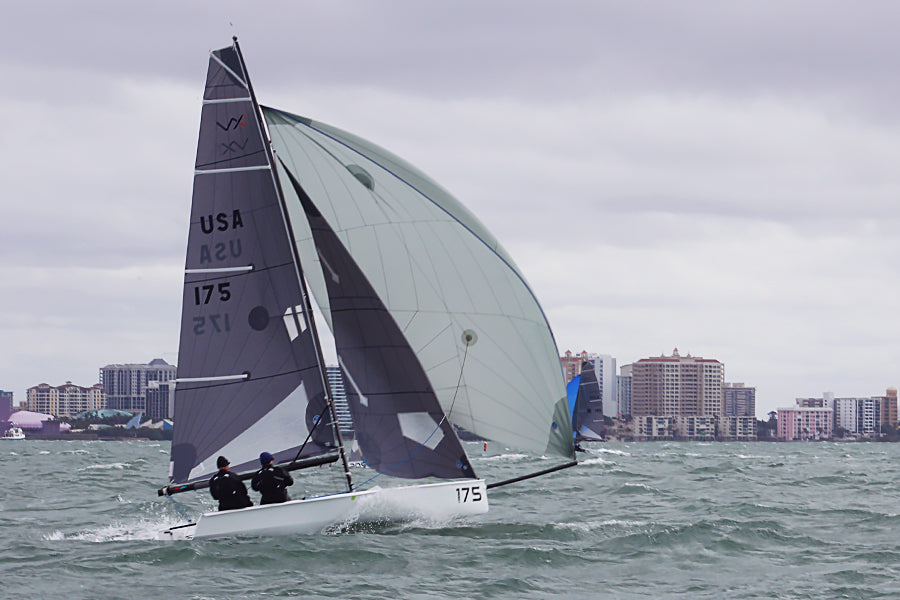
events
VX ONE MIDWINTERS CHAMPIONSHIP
VX ONE MIDWINTERS CHAMPIONSHIP
North Sails powers clients to the top in big breeze on Sarasota Bay
The VX One Midwinters, hosted by Sarasota Sailing Squadron, was a wet and wild one with strong breezes ranging between 15-18 knots giving sailors a thrill all weekend long. Sailors felt the need for speed in this fun and exciting one design class, hiking hard in the fight to be number one at the end of the day. North-powered clients deemed to be fastest, placing 1, 2, 3, 4, 5, 6*, 7, and 9th out of 23 teams. North Sails VX One expert, Jackson Benvenutti joined Richard Heausler’s team Second Line placing second overall, just two points away from first place finishers Jeff Eiber, on Calvin Ball. Jeff stated: “Going into this regatta I felt very fortunate to have my son sailing with me. So my primary goal was to keep the communication and psychology 100% positive and focus on enjoying our time together both in the boat and onshore. As the regatta progressed we noticed that the more time we spent thinking, looking around, and talking, the better we sailed or at least the easier it seemed to go the right way.
“We were very quick off the wind and having a blast too! Not capsizing in the jibes let us pass lots of boats downwind so we survived the windy day with 11 points. The next two days were in moderate wind so even though we were a little slower upwind with old sails and less weight we were still one of the fastest boats downwind. I was also happy with the performance of our 2 year old, very high mileage North sails. The VX is a very crew weight-wind speed sensitive boat. Of course it feels good to win but I feel an even bigger sense of satisfaction from sailing with my son and enjoying the warm camaraderie of my fellow VX sailors”, said Jeff.
To top off the podium in third place was Sam Padnos on TWD, also very close behind keeping the racing very close and exciting. Saturday was above all the windiest days and many teams experienced a little capsizing exercise during racing. Jackson’s team ended up in the drink a few times, but was still able to hang on to their positioning. Jackson stated,
“Flipping over three times in two races was certainly humbling and a bit of a reality check on our (lack of) weight in the big breeze. But we were in the mindset to live to fight another day and take advantage of the slightly lighter forecast for the next two days of the regatta. That common saying ‘you can’t win a regatta on the first day, but you can certainly lose it’ came to mind. We knew we had a bit of a hole to dig out of, but felt like we still had a chance to do well.”
After the weekend, Jackson reflected on some key points that contributed to his teams’ success over the weekend. Along with not giving up, here’s what he had to say about rig tuning, body placement, sail trim, and the true power of hiking hard.
Jackson’s 10 Takeaways:
1) Make sure the main halyard is all the way up! The mast bends a lot, which makes the mainsail fall down a little bit. Rig a halyard that is a bit thicker than the standard diameter spectra halyard where it goes around the cleat. To achieve this, we inserted a core inside the main halyard about 2 feet long where the halyard fit around the cleat when the mainsail was fully hoisted. This will also help with the line slipping over the cleat and gave us a bit of a better grip to pull it up those last few centimeters. In the breezier conditions, about 80% of the fleet had their halyards slipping below max hoist.
2) Batten tension is crucial and should be monitored to assure that you never have any vertical wrinkles along the batten pockets, especially the full-length battens! Using stiffer battens for the top battens in the main and jib will also help flatten out the top of both sails in the big breeze!
3) Cap shroud tension is important. We actually bottomed out our cap shrouds after 19.5 turns from the base setting, and would have liked to put about another 6 turns on if we could have! Ideally, the shrouds would be a little bit shorter, trimming a 1/2 inch off both studs will help achieve more cap shroud tension. However, you have to turn the lowers as well if you are cranking on the caps. If you don’t, you’ll end up with too much mast bend and over-bend wrinkles in your main, especially when you apply proper vang tension. Not having proper lower and checkstay tension will allow the mast to bend too much, and will actually decrease the headstay tension you are trying to achieve (indicated when the mainsail begins to show overbend wrinkles which extend from the middle of the luff near the spreaders and run towards the clew). Generally, the best ratio of cap shrouds to lower shrouds seemed to be 3:1. That means 1 turn on the lowers for every 3 turns on the caps.
4) In chop the boat sailed well flat with the bow down and the sheets eased, in particular, the mainsheet.
5) When executing the planing/bow down mode upwind with the mainsheet eased to keep the boat flat, the jib cannot be trimmed too hard or else the slot will be closed off. The best way to keep the top of the jib open was to move the sheet down on the clewboard of the jib. Our sheet lived in the bottom 3 holes of the clewboard and felt especially fast one hole up from the bottom in the 15-18 knot breeze. This allowed us to flatten the bottom of the jib, keep the top twisted open, and inhaul the jib properly to the sweet spot (around 6 degrees of sheeting angle).
6) Trimming and easing both sails together upwind proved to be very fast! Easing the jib and main together as a puff hits allowed the boat to transfer the extra wind velocity into forward boat speed without the boat heeling over too much. Plus, this keeps the keel deeper in the water. We found that allowing the boat to go fast forward through the water (instead of trying to ride a puff up with the sheets in and feathering) would make the keel become more efficient, which in turn provided height. In short, your pointing would come from speed.
7) Downwind the boat was very sensitive to weight movement. Being aggressive with your fore and aft movements really worked well. Move forward to initiate planing, slide aft while planing, and then move forward again to prolong planing. In marginal planing conditions, if the skipper has to turn up to keep planing, you should be moving forward. If he has to turn down to keep the boat at the proper angle of heel, you should be moving aft. Sometimes it was possible to get the bow up and over a wave that you might not have been able to get over with a short-lived slide forward.
8) Keep the gears changing! On the last day of the midwinters, the breeze was pretty puffy. This caused the boat to go from underpowered to overpowered very quickly, and vice versa. The key in those conditions is to constantly be looking at the wind that will be immediately affecting your sails and be proactive about the changes in velocity (not reactive)! The jib halyard tension and main cunningham are very easy to adjust and should be adjusted constantly in those conditions. Our boat is rigged up so that the jib halyard and main cunningham are actually the same continuous line. This makes it easy to keep track of where that line is, if I grab one, I have both of them. The adjustments on the luff on both of the sails would range from wrinkles in 50% to completely smooth, which will properly change the shape of your sails for the given wind condition. Basically, the boat will either be overpowered or underpowered, so you want a looser luff when you’re underpowered and a firmer, smooth luff when you’re overpowered.
9) Jib trim downwind is key. I think most people overlook it and focus more on the bigger sails, the kite, and mainsail. However, if the jib is under trimmed, then you are losing power and speed that you could easily have and you’re also dragging the sail through the air which is actually slowing you down! If the jib is over trimmed (which is worse than under trimmed) it completely closes off the slot which then essentially acts as a handbrake to your boat. An over-trimmed jib downwind will kill both the flow over the kite and the flow over the main. Not good! The best jib trim is with the car all the way down on the track, and then trim the sheet so that the top 1/5th of the jib is spilling open and slightly luffing. This trim technique will ensure a few things: the jib is trimmed in a way that keeps the groove wide open downwind so the driver can actively steer to the pressure changes, it will provide extra power in the sail plan to help sail slightly lower, and will keep the breeze flowing through the slots! The jib will need small adjustments every now and then as the boat goes through puffs and lulls. The main point is, don’t ignore the jib downwind!
10) There is no good substitute for hiking hard and good physical fitness. It’s simple, the harder you hike, the flatter you keep the boat, the less you slide sideways and the better the keel works! Hiking hard also means you can sail the boat with a little less weight, which can pay huge dividends on the downwind legs. Being physically unfit not only means you can’t sail the boat to its full potential, but it creates a snowball effect due to fatigue where you can’t make the boat go fast enough, your mind can’t process information as fast, and you make bad decisions. Body-weight workouts are worth their weight in gold in a class like the VX One. Staying well fed and properly hydrated also helps a ton in fighting fatigue. The VX One is a physically demanding boat!
Interested in our products? Contact your local VX expert today!
VX One Midwinter Championship
1
Calvin Ball / Jeff Eiber
2
Second Line / Richard Heausler
3
TWD / Sam Padnos
4
VX One / John Potter
5
Chuck Wagon / Phip Hallowell
6*
Isabelita Con Queso / Christopher Alexander
7
Character 3.0 / Justin Quigg
8
Wild Deuces / Paul Currie
9
GiddyUP / Kevin Gillman
* Denotes Partial North Sails Inventory
Interested in joining the VX One Class?
READ MORE
READ MORE
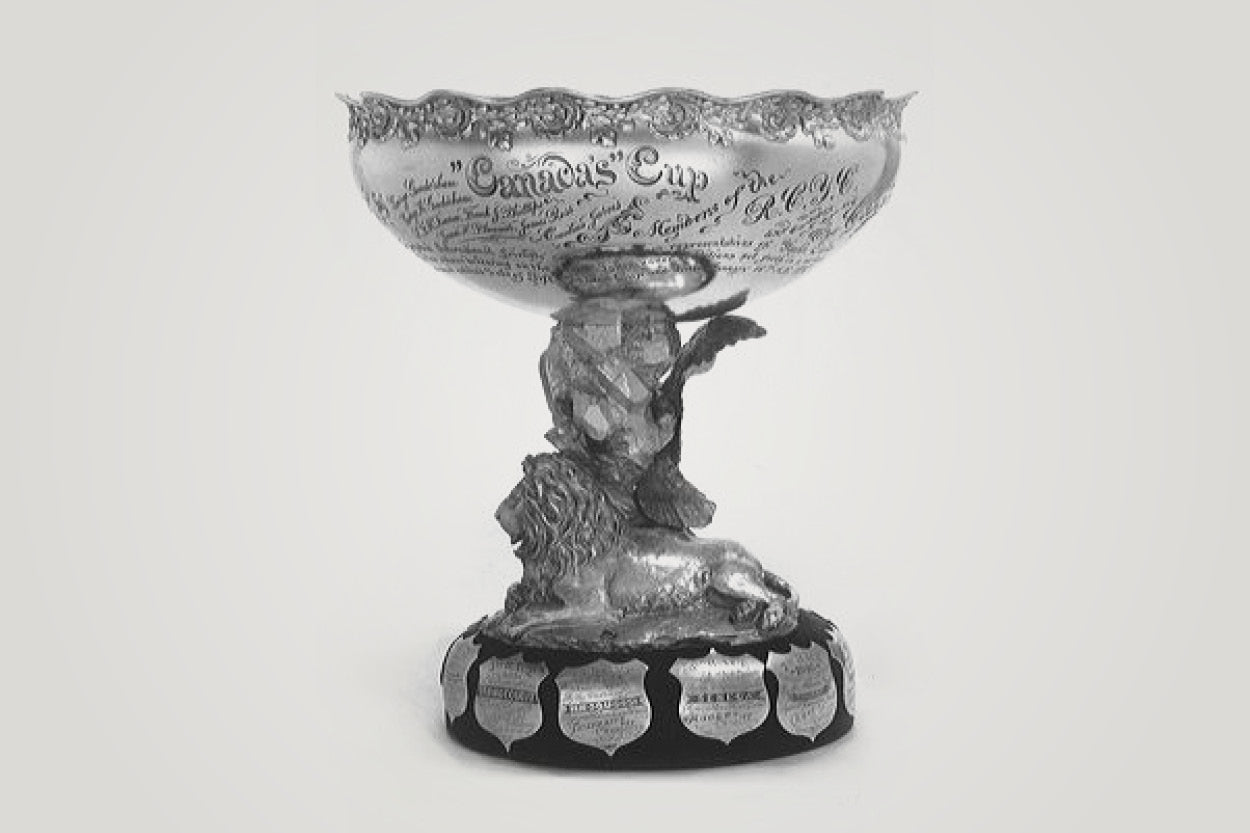
events
CANADA’S CUP TROPHY TO VISIT THE 2018 INTERNATIONAL TORONTO BOAT SHOW
THE CANADA’S CUP TROPHY AT THE 2018 TORONTO BOAT SHOW
The Canada’s Cup is the premier match racing trophy for the Great Lakes. The Cup was deeded in 1896 to be awarded in perpetuity to a winner of a series of match races between a yacht representing a Canadian yacht club and one representing an American club, both to be located on the Great Lakes. The prestigious event has been contested 24 times between the United States and Canada; USA holds the edge, 13 to 11.
WHAT:
Come and see the oldest and most prestigious Great Lakes sailing trophy, the Canada’s Cup, and learn about exciting changes for the Canada’s Cup Event. Be introduced to the Melges IC37, the new boat that has been selected for the event for 2020, 2022, 2024.
WHEN:
Friday, Jan 19th – 1600 – 1900 hours.
Saturday, Jan 20 – 1200 – 1600 hours.
Sunday, Jan 21 – 1200 – 1600 hours.
WHERE:
North Sails Booth #1623
READ MORE
READ MORE

events
MAGPIE DOMINATE ETCHELLS AUSTRALIAN CHAMPIONSHIP
MAGPIE DOMINATES ETCHELLS AUSTRALIAN CHAMPIONSHIP
North Sails Clients Sweep the podium, Graeme wins another National Title
The Swan River Etchells fleet in Fremantle, Western Australia put on a show with sunshine, crystal clear water, great racing conditions, and hospitality for the 2018 Etchells Australian Championships. This race track will be hosting the 2020 Worlds Championship and has proved it will make a wonderful venue for the competition in a few years time.
The teams experienced variable conditions, from 10 to 20+ knots, testing the local and visiting sailors. The winning team of Graeme Taylor, James Mayo and Richard Allanson sailing Magpie never found it hard to turn on the speed, leading the event from day one. They finished the 7-race event with a total of 15 points overall and a 9-point lead over the second place.
The team This Thing of Ours with David Turton, Josh Torpy and Klause Lorenz finished second overall, and local team, The Croc with Michael Manford, Dean McAullay and Nick Gray rounded off the podium finishes placing third overall. North Sails is proud to have powered all 3 top teams!
Three-time Australian National Champion Graeme Taylor will now focus on the next World Championships later this year in Queensland Australia, where he hopes to better his 2nd place from the recent Worlds in San Francisco. Graeme uses PC-FM Mainsail, GM Medium-Heavy Jib and LM-2L Jib.
North Sails is committed to the Etchells class working non-stop to provide the fastest sails and the best service to our clients worldwide.
For more information about our products contact your local North Sails Etchells expert.
Full Results
READ MORE
READ MORE
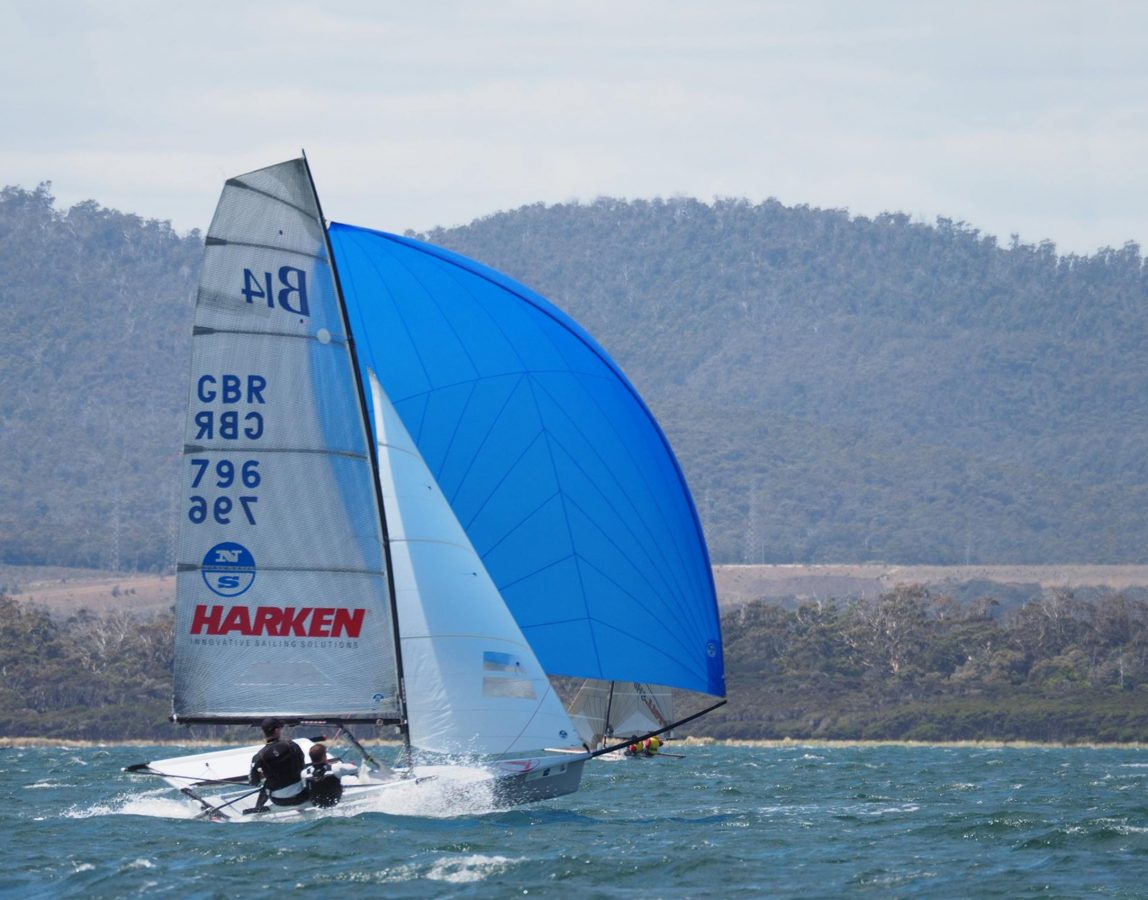
events
INTERVIEW WITH B14 WORLD CHAMPION NICK CRAIG
INTERVIEW WITH B14 WORLD CHAMPION NICK CRAIG
Seven bullets at the Worlds in Tasmania
After eight races, Nick Craig and Toby Lewis won the B14 World Championship with all bullets on the scoreboard. The event gave the 30 boat fleet a mixture of conditions, however in general on the breezy end of the forecast, which was ideal conditions for the skiff class.
Nick and Toby are familiar faces when it comes to the front end of the fleet in One Design racing, with victories in multiple national and international events in a variety of boats. They were also champions of the Endeavour Trophy in 2008 – the annual Champion of Champions event in the UK.
We caught up with Nick after the Worlds:
How long have you been sailing in the B14 Class?
I sailed the B14 for a few years around a decade ago and got back into the class a couple of years ago. I had missed the downwind buzz and great international racing and socials.
Which sail designs do you use and what is it that you like about them?
We use the North LGM-8 3DL mainsail, LJ-4D Dacron jib and the SS-04 kite. I think our rig setup is very powered up but controllable in breeze (with these sails), which gives great pace in every wind condition. The SS-04 kite is really quick downwind!
What was venue like to sail at and what would be your top tip for the venue?
It was an excellent venue – we had sunshine and great wind almost every day :-). Everyone at the sailing club was really friendly, the family made friends and had a good time and we had fun touring around seeing Penguins and amazing beaches!
It is quite tidal with some shallows in odd places at low water so it is worth gaining some local knowledge through racing there, looking at tidal charts and talking to people.
After a successful start to the year, what’s your goal for the rest of 2018?
Do some more great racing in competitive classes – we are lined up to sail in the Merlin Nationals, GP14 and D-One Worlds
What are your top tips for sailing a B14 upwind & downwind?
Upwind in light winds the B14 is quite similar to slow boats – take the shifts and pressure and she likes a surprising amount of leech tension. In breeze, the B14 is very different to anything else I sail upwind and a lot of fun! Pressure is king over shifts and tacks should be made sparingly as you come off the plane.
When going upwind, you are looking to stay on a “high plane”: bow down, touch of windward heel and ease sails to get the boat planing and then gradually sheet in to plane close to the wind. Constant trimming is needed unless the wind is very steady.
Downwind we try to steer the boat through sail trim and body movement to avoid rudder use. Toby is a fantastic kite trimmer which frees me up to look for pressure and try to map a path down the run to stay in the most pressure
You have had great success in multiple classes, what is your secret?
No great secret – outstanding crews, lots of hours on the water, sailing in competitive fleets and always trying new things and seeking to learn.
Thank you Nick and congratulations to yourself and Toby!
Find out about North fast B14 sails.
Full results
READ MORE
READ MORE
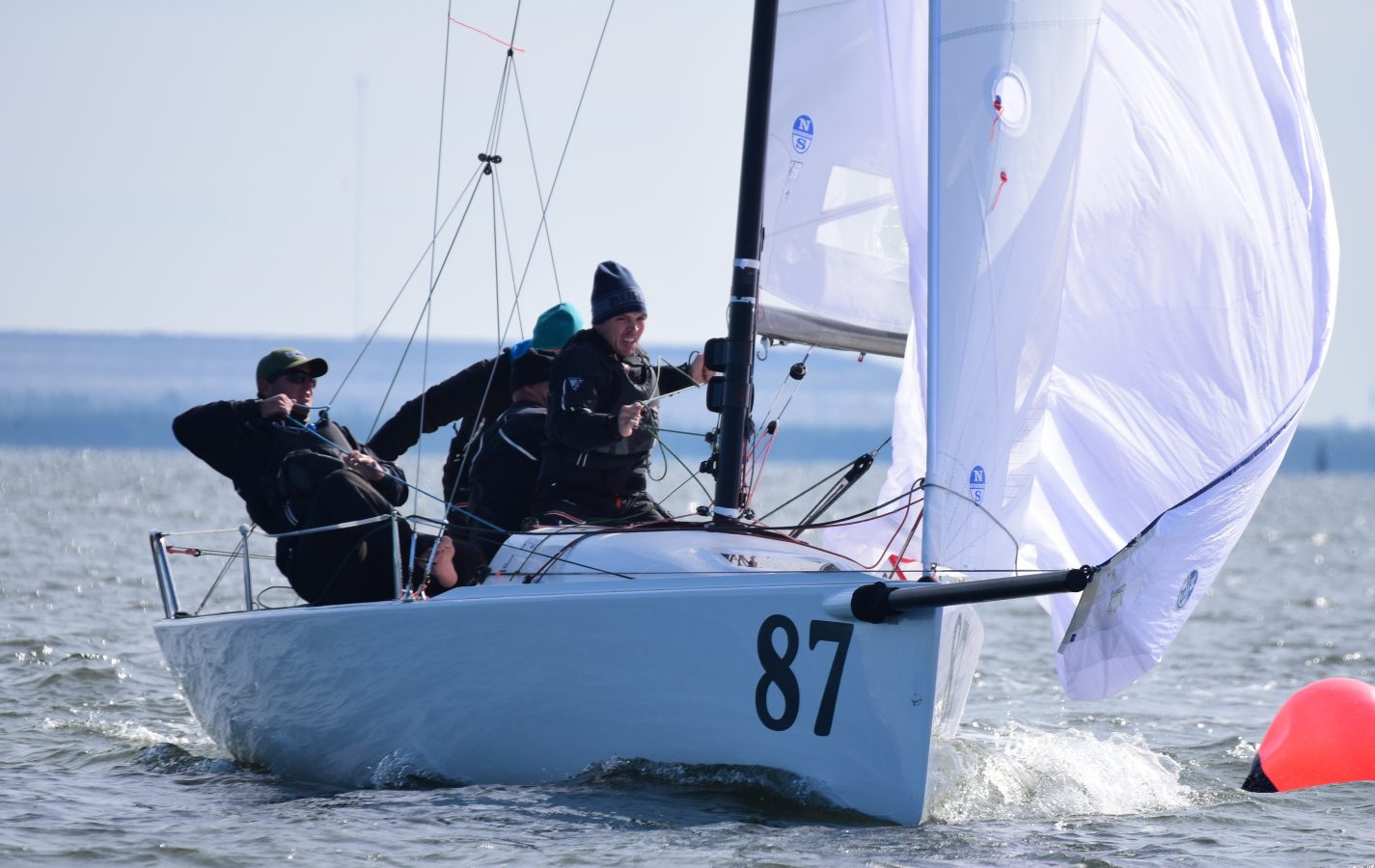
events
J/70 DOWNWIND TIPS - MARGINAL PLANING CONDITIONS
J/70 WINTER SERIES EVENT #2
Tips for Marginal Planing Conditions
Joel Ronning’s team Catapult, winner of the US Winter Series event #2. Photo Chris Howell
The J/70 Class came back for the action at event #2 of the Davis Island Winter Series in Tampa, Florida. Starting the event off with a bullet, Joel Ronning’s Catapult was ready to take on the 52-boat fleet. A cold front kept things on the chilly side, but with a nice 12-18 knot breeze out of the NE and flat seas, ideal conditions for all teams would be presented for the weekend. The competition was as high as usual. Sailors were eager to get off the line in a clear lane so they could choose their own destiny. After six races, Catapult lived up to their name and stayed clear of the fleet, scoring a total of nine points after one discard. Still having no races out of the top five the entire weekend, they were untouchable and had unbelievable speed. The XCS-1 mainsail, the J-6 jib and AP-1 spinnaker was a common weapon of choice for J/70 teams this weekend, with outstanding results.
North powered clients to 1,3, 5*, 6,7,8*,9 overall, sweeping the fleet full storm. Congratulations to our clients for these outstanding performances throughout the weekend in shifty-puffy conditions.
As always, teams had their share of tricks to get them around the race course. North Sails Tim Healy joined John Heaton’s team Empeiria for the weekend and shared some tips with us afterward. Here is what he had to say about maximizing crew technique in flat water marginal planing conditions.
Tips for Marginal Planing Conditions in 14-16 knots, flat water
At the top of the beat it is important to recognize what side of the course has best pressure.
Plan A: If no jibe is the call, then complete a normal set and quickly determine if you are in a planing puff or not, keeping in mind that you still have to protect your lane to weather.
Plan B: If you decide on a quick jibe, set up on the offset leg so you won’t get overlapped to windward with any boat. It is also important to sail higher, early in the offset leg, so the spinnaker can be set before the offset mark and fill as early as possible. This will allow a jibe at the offset mark to ensure no one will jibe inside you.
If you are in a planing puff, leave the jib out. Once you get planing get more vang on to maximize your power by keeping the main leech from spilling open. You should notice your leech telltales starting to stall then ease off a bit. This will give more power once you are up on a plane, allow you to sail lower while planing and will keep you planing longer as the wind fades off.
Things to keep in mind on crew weight placement:
In marginal or ”lazy” planing conditions, keep crew weight forward. The three forward crew should only move fore and aft in the cockpit section in front of the winch. Helmsman should be hip up to winch to-two feet behind it. The less wind the farther forward the entire crew needs to move.
As your planing puff dies, turn up gradually to maintain power and heel angle. If puff continues to die and you need to start searching up for pressure/power, look upwind and determine if there is another puff coming quickly that you can connect with. If a puff is not coming your way, then quickly go into displacement mode.
Furl jib
Bear away to max downwind angle
Ease main out and adjust vang for proper twist
Weight in for a flat boat and weight max forward
Make sure your backstay is fully eased
When your are in displacement mode, it might be a good time to think about going wing-on-wing. This will allow you to ride the 8-13 knot puff back down to the center of the course and away from the pack. It works well in these marginal planing conditions because it allows you to separate from other boats that may be searching too high to stay on a plane. You will be sailing close to DDW, while they are sailing high (on a reach) searching for the next planing puff. This is an opportunity to gain a lot of distance from your closest competitors.
Once the next puff is identified as a ‘planing puff’, wait until it hits then it’s time to take immediate action:
Unfurl jib (under trim till planing to keep it from disturbing the air flow around spinnaker).
Turn boat up to get planing at the same time all the crew weight is moved to the weather rail.
Find the correct heading based on heel angle. No more than 12 degrees of heel when puff hits then less than 10 degrees to get planing. Keep in mind that a planing boat should be flat and have no more than 10 degrees of heel.
Spin can be eased to see curl when puff first hits. When planing trim in to eliminate that curl. Only test curl from time to time. This keeps the spin leech from twisting too far open and depowering.
Once planing, trim vang on and trim in the jib, being careful not to overtrim.
See you at the next regatta! Please do not hesitate to contact Tim or the North Sails J/70 experts with go fast questions or product information.
J/70 2017-18 US Winter Series – Event 2
1
Catapult / Joel Ronning
3
Savasana / Brian Keane
5*
Powerplay Racing / Peter Cunningham
6
Stampede / Bruno Pasquinelli
7
Scamp / Will Welles
8*
Minor Threat / Jeff Janov
10
Building A / Josh Goldman
* Denotes Partial North Sails Inventory
Full Results
Sail22 Porch Series with North U – J/70 experts Tim Healy, Eric Doyle and Jackson Benvenutti
READ MORE
READ MORE
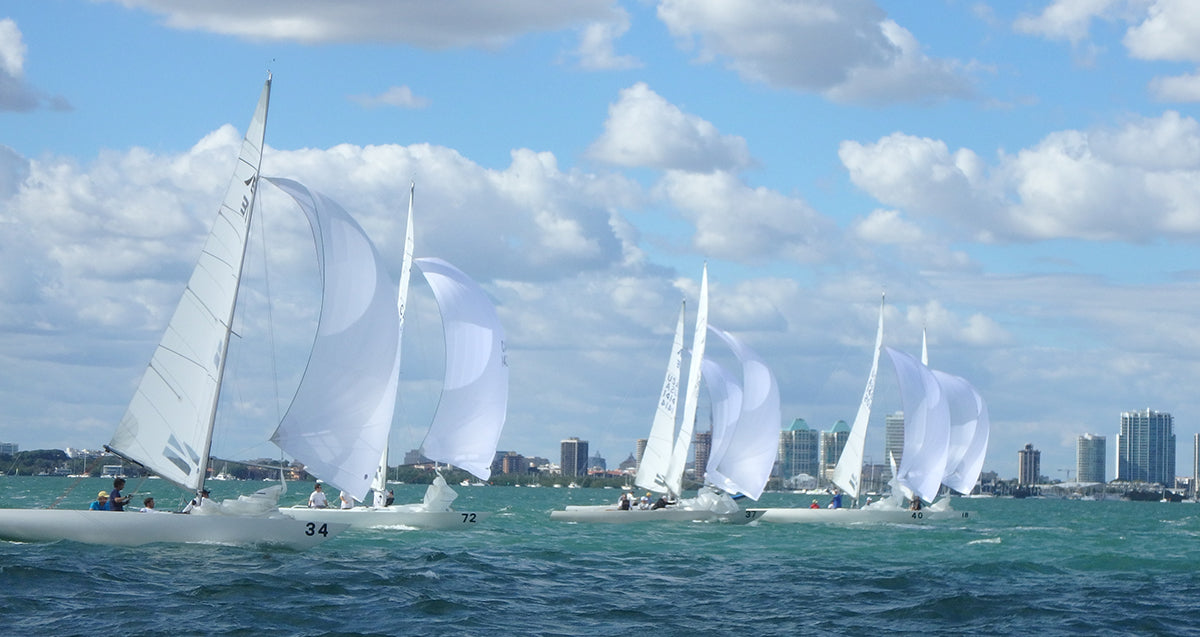
events
2018 ETCHELLS SID DOREN MEMORIAL REGATTA
NORTH ETCHELLS DESIGNS DOMINATE FLEET IN MIAMI
Jim Cunningham shows excellent performance at the 2018 Sid Doren
Thirty-eight teams made their way to Miami for the second event of the prestigious 2017-2018 Key Biscayne Series – the Sid Doren Memorial Regatta. There were Winter storms up and down the East Coast, some stretching as south as Miami, and big breeze and cooler temps were forecasted.
Team Lifted with skipper Jim Cunningham and crew of Jeff Madrigali, Mark Ivey and Serena Vilage repeated their win at the first event of the winter series, the Louis Piana Cup back in December, by sweeping the 38-boat fleet in five races using the North PC-FM mainsail, GM jib and Full Radial spinnaker.
“We are proud of the results North clients are achieving with our designs. Nine of the top ten boats used full North Sails inventories”, said North expert Skip Dieball. “For my team on War Canoe, we used a brand new PC-FM main. Our speed was noticeably better and we were happy with a third place finish. The radial head really allows for more control in the upper section”.
2018 Sid Doren Memorial Regatta
1
Lifted / Jim Cunningham
2
SCIMITAR / Steve Benjamin
3
War Canoe / Michael Goldfarb
4
Tiburon / Mark Watson
5
Skanky Gene / Jay Cross
6
Gumption3 / Kevin Grainger
8
Blacadder II / Andrew Cumming
9
America Jane II / Scott Kaufman
10
Freedom / Craig Mense
* Denotes Partial North Sails Inventory
Full Results
Find out more about our regatta-winning Etchells products
READ MORE
READ MORE
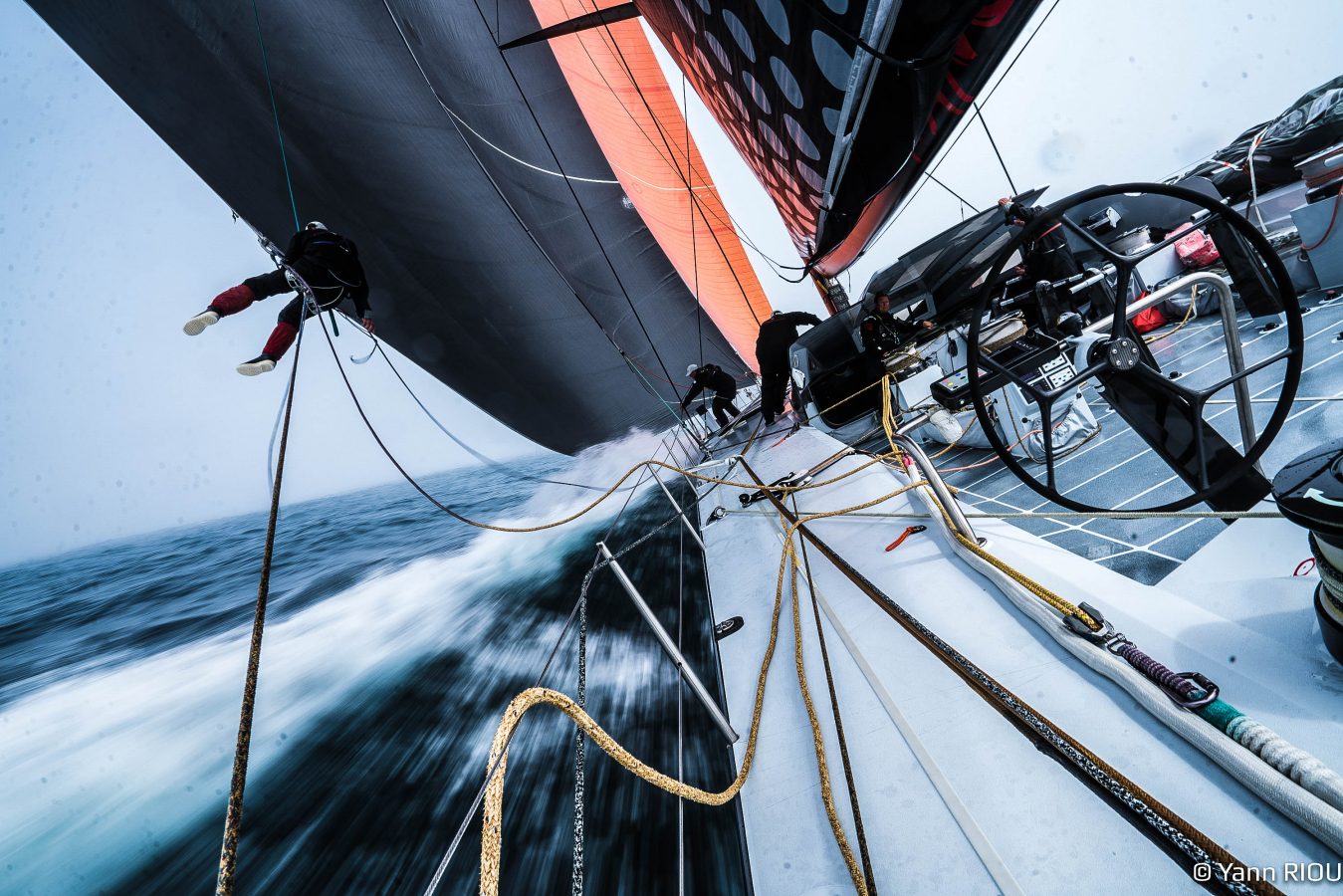
events
NORTH SAILS OFFICIAL PERFORMANCE PARTNER FOR 2018 NEWPORT - BERMUDA
NORTH SAILS OFFICIAL PERFORMANCE PARTNER FOR 2018 NEWPORT-BERMUDA
© Yann Riou
North Sails, the world’s leading sailmaker, today announced that it will join the prestigious Newport to Bermuda Race as Performance Partner for the 2018 edition. The event is a 635-mile biennial distance race that draws an international fleet and includes a range of yachts from Super Maxis to Corinthian cruisers. The race, that prides itself on accessibility for a wide variety of sailors, is a great test of blue-water seamanship from historic Newport to the beautiful shores of Bermuda.
As Performance Partner, North Sails will be working with participants to help them optimize their offshore sail inventories. North will be hosting three seminars where North Sails experts, and race veterans, will be on hand to answer questions and discuss sail choices and weather routing for the race. The seminars will be held in Annapolis, MD, Portsmouth, RI and Stamford, CT.
North Sails has a long history with the Newport Bermuda Race, powering a huge number of boats including many to race victories. Most recently, Comanche carried a full North Sails inventory when she set the current race record and Warrior Won was fully outfitted with North Sails when she captured the St David’s Lighthouse Division in 2016. North Sails has more offshore miles, around the world records and ocean racing victories than all other sailmakers combined and prides itself on having the best sail solutions for boats across the spectrum. Much of North Sails’ offshore success can be attributed to their unique 3Di technology that delivers speed, durability and reliability for all that use it.
“The Newport Bermuda Race a classic a race on par with the likes of the Fastnet, Sydney-Hobart and Transpac,” said North Sails President and race record holder Ken Read. “The East Coast can serve up a variety of weather conditions in mid-June and having a sail inventory that can take you through a variety of conditions is a game changer. With a range of 3Di upwind and recently introduced downwind sails, North offers a high performance yet incredibly durable choice that we believe can make the race enjoyable for all participants.”
Those interested in attending one of the Performance Seminars, click here.
READ MORE
READ MORE
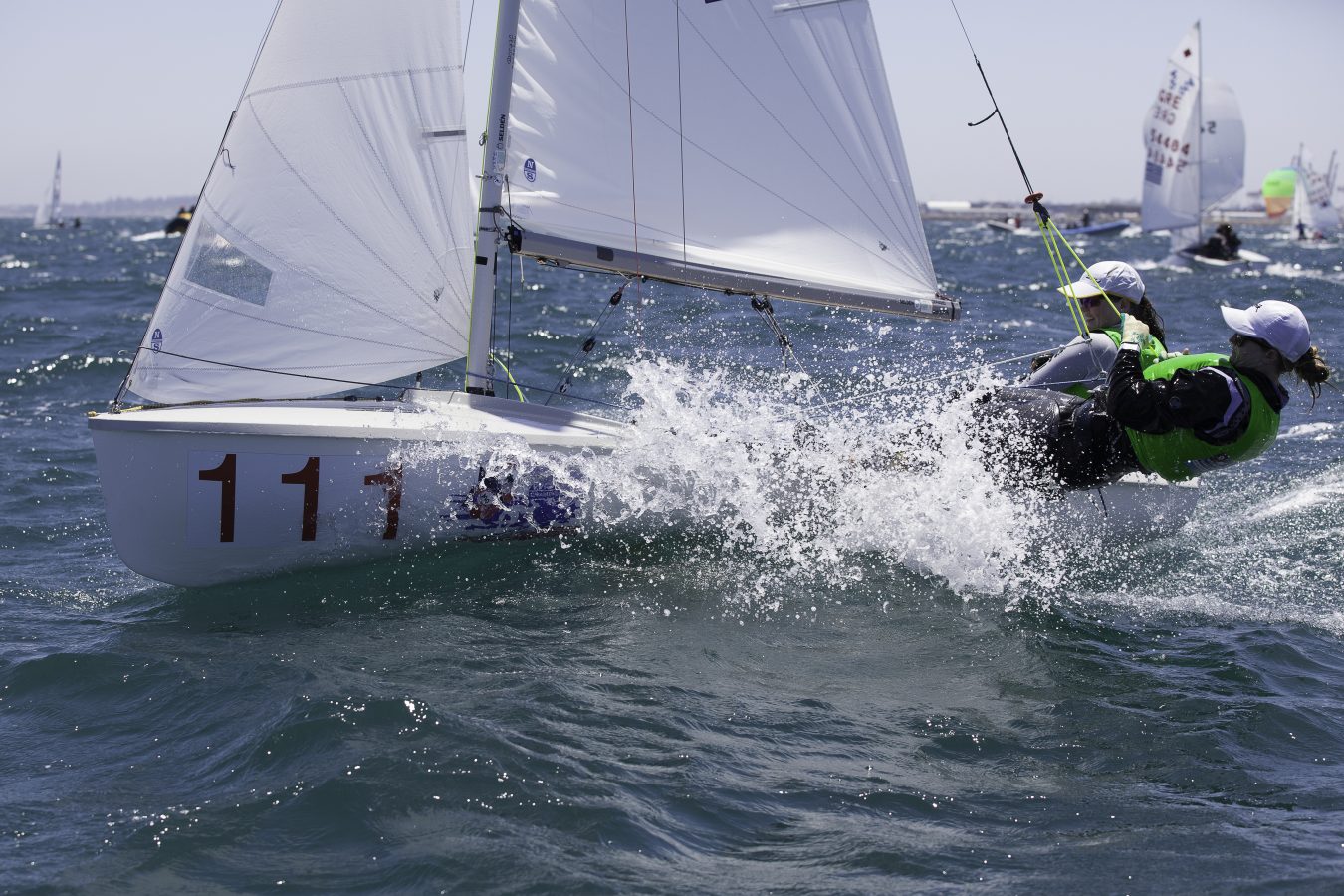
events
CLEAN SWEEP AT 420 WORLDS
CLEAN SWEEP AT 420 WORLDS
Teams powered by North Sails win all three divisions
Nia Jerwood & Monique DeVries © Bernie Kaaks
The 420 Worlds in Fremantle, Australia, kicked off the 2018 season for the 420 class. The big breeze event with big swell made for exciting sailing conditions for the fleets. The Spanish teams came out with fighting spirit, dominating the top three of the Open division and winning the U17 fleet. In the Open, a run of consistent top 10 results half of which in the podium position, ensured North Sails jockey’s Enrique Lujan & Pablo Lujan the win. In the U17 fleet another consistent event was raced by Martin Wizner & Pedro Ameneiro giving them a 3 point clearance securing the first place.
In the Women’s fleet Australians, Nia Jerwood & Monique DeVries had the home side advantage and used this to come away with the women’s title. Although they were tied on points with second placed boat, 6 bullets on their scoreboard ensured their victory.
Congratulations to all teams sailing with North Sails inventories and good luck for the rest of 2018, this was a fantastic start to the season.
North designs used by the World Champions:
Open: M-9 mainsail, J-13 jib, S-05 Spinnaker
Ladies: M-9 mainsail, J-12 jib, S-01 Spinnaker
U17: M-9 mainsail, J-12 jib, S-05 Spinnaker
If you are interested in any North Sails 420 products, contact your class expert.
Enrique Lujan & Pablo Lujan © Bernie Kaaks
Martin Wizner & Pedro Ameneiro © Bernie Kaaks
420 World Championship
Open
1
Enrique Lujan & Pablo Lujan
2*
Albert Torres & Francisco Mulet
4
Enzo Balanger & Gaultier Tallieu
5
Thomas Andre & Justin Baradat
9
Eduard Ferrer & Carlos De Maqua
10
Elias Aretz & Pablo Garcia
Ladies
1
Nia Jerwood & Monique DeVries
4
Sophie McIntosh & Orla Mulholland-Patterson
6
Sophie Jackson & Laura Thomson
7
María Caba & Pilar Caba
8
Solène Mariani & Maude Schmid
9
Clara Olive & Solenza Mariani
Under 17
1
Martin Wizner & Pedro Ameneiro
4
Pol Marsans & Alex Marsans
5
Jack Lewis & Charlie Bacon
7
Tommaso Salvette & Giovanni Sandrini
8
Ariadni-Paraskevi Spanaki & Myrto Papadopoulou
* Denotes Partial North Sails Inventory
READ MORE
READ MORE
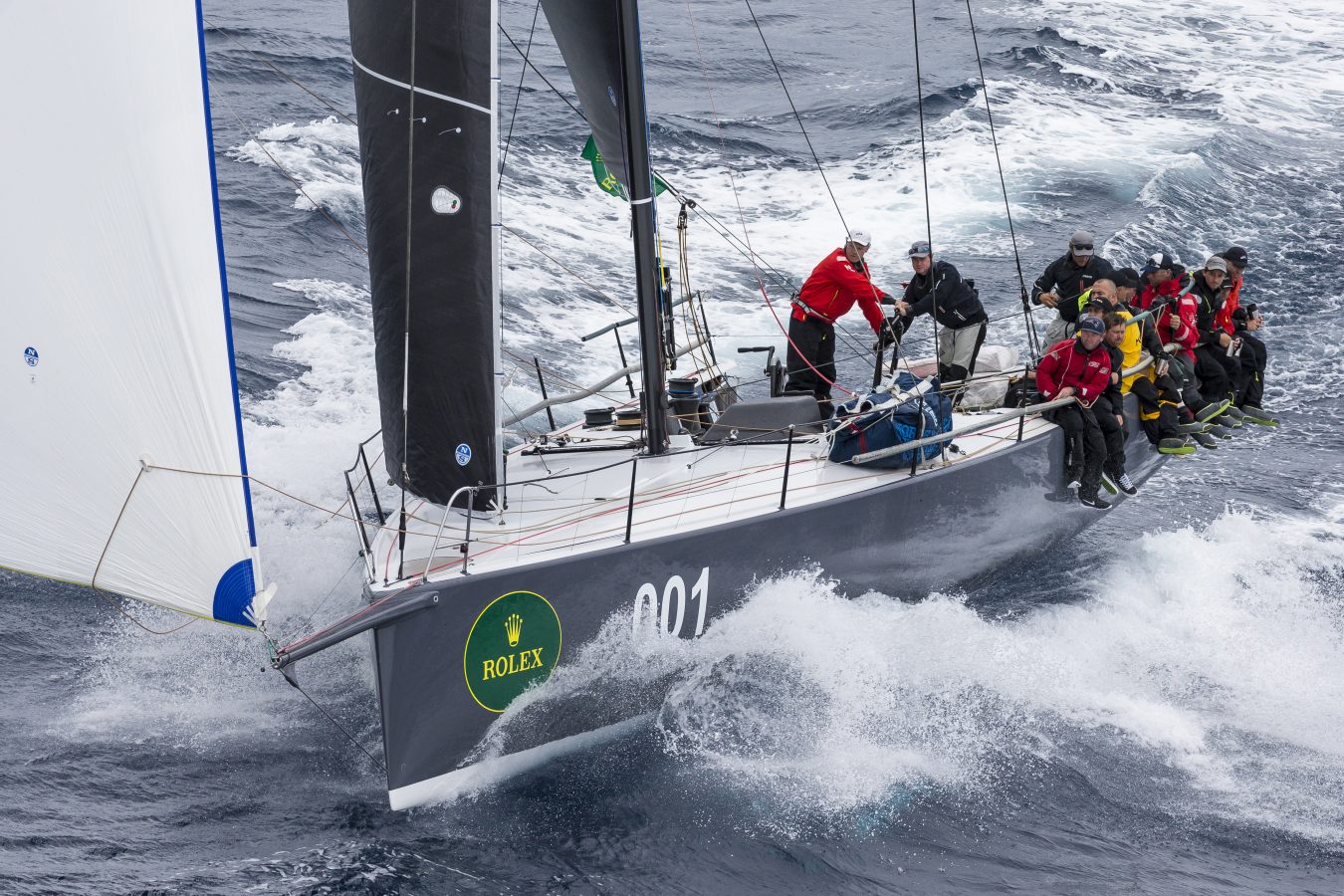
events
LONG TIME NORTH CUSTOMER WINS ROLEX SYDNEY HOBART
LONG TIME NORTH CUSTOMER WINS ROLEX SYDNEY HOBART
Winning the RSHYR takes determination, preparation, and a well thought-out sail inventory
Matt Allen, a long-time North Sails customer, first won the Rolex Sydney Hobart Race 34 years ago. In 2017, he finally repeated the achievement on Ichi Ban when they were named overall winner of the Rolex Sydney Hobart Race. It was a fitting honor for a boat whose name translates to “number one” in Japanese. The win this year was even sweeter considering that Matt’s new TP52 is only three months old.
Billy Sykes, a member of the North Sails team in Sydney (AUS), was part of Matt’s crew on the legendary race. We recently caught up with Billy to talk about what it takes to win the RSHYR on a brand-new boat.
“The boat was fresh out the packet, which always brings the opportunity for things to go wrong because gear has not been tried and tested. But we managed to put all those things behind us and come away with the win for Matt, which was a great thing.”
Can you take us through the race and any key decisions the team made?
“The RSHYR is 628 nautical miles and unlike inshore racing, the start isn’t everything. That was certainly good for us as we were well out the back door at the beginning. But we know Sydney Harbor well and we managed to wiggle through and get back into a competitive position by the time we got to the top mark. I think we were the first to actually put up our (new) 3Di RAW Code Zero.
Matt had ordered that sail for the race and there is no doubt it helped us get back to where we wanted to be – at the front. From there, we just kept consolidating the whole way. This race was quite unique for a number of reasons; firstly we got to the bottom of Green Cape at six AM the morning after the start, which is exceptional considering this is almost the halfway point. And secondly, we did the whole race in one weather system, which is pretty extraordinary for a 52 foot yacht.
The moment we got our break was when we put up our A4 spinnaker again, which is our largest masthead spinnaker. We had a reef in the main and putting the A4 up was quite a big move, but Quest was pushing us really hard down the coast, so we didn’t have a chance to back off, we had to keep pushing too. We were on the edge of our seats with it up, as the sea state was all over the place and it was blowing hard.
The other important moment was when sailing master Gordon McGuire and navigator Will Oxley made the decision to take us about 15 miles past the layline to set us up for a big shift. It was a great call that essentially got all of our time back on Quest. Then we got into Storm Bay and had our Code Zero and jib up around Cape Raoul up to the Iron Pot, and after we got past the Iron Pot we actually got becalmed in the Derwent for about 25 minutes which was really stressful for the whole team But we managed to get through that little transition back into the breeze and get through to the finish.”
How was the mood onboard after crossing the finish line in Hobart?
“There was a bit of a nervous wait because we guesstimated we owed Quest about 40-45 minutes on corrected time. So we dropped the mainsail and were all pretty keen to hang around for the final result, because we knew if we beat Quest we would have a real chance to get the Tattersalls Cup. We had no control over the corrected finish times but to have made sure that we had as much time as possible on Quest was a real big deal.”
What did you enjoy the most about the race, other than winning?
“The challenge of downwind running pretty much the whole way. This is my twelfth RSHYR and I’ve never seen two years in a row where you’ve been hard running down to Tasman Island. We actually broke two race records this year; the ballasted record set and held by Brindabella in 1999 and the under 18.5 metre yacht record set by Yendys in 2008. The last bit into Tasman Island, hard running in 24 – 30 knots with our biggest masthead spinnaker up, was very challenging but also made for some amazing sailing.”
In one article, Matt Allen attributed the win to the latest technology and design and the most amazing crew he’s ever sailed with. Can you explain what he meant about the latest technology and design?
“Matt had a plan long before Ichi Ban came out of the shed. He bought the old Shogun and made quite a few changes to make it really ready for offshore sailing. Then after last year’s race Matt decided to build a new yacht and took all the things he’d learnt from the previous boats into the new Ichi Ban. It is a Botin design, Adolfo Carrau specifically who was behind it, and they did an exceptional job. The other part of the design would be the Southern Spars mast and working so closely with us on sails. All these things together made a huge difference in how hard we were able to push. In all the development, you’d have to also mention also Tim Sellers the boat captain. He did a great job getting the boat race ready in just three months. But the planning, thought and research that Matt and the team did before the build even started made Ichi Ban the race winning boat it is.”
Can you give us a run through of the sail inventory and how it was matched to the conditions that you had?
“Obviously we had the offshore main (North 3Di RAW 870), which already had one RSHYR on it. And the offshore A4 (NPL Downwind), which is a serious downwind sail we designed specifically for the RSHYR.
The entire North Sails team worked hand-in-hand with Matt on his sail inventory; the mainsail, headsail, and spinnakers. Especially on what DPI we were going to use for each upwind sail. Matt was instrumental in making sure we constructed the headsails and spinnakers out of stronger materials, to give the sails a wider wind range offshore.”
“The mainsail was bulletproof. We never really question the durability when suggesting a 3Di sail. An offshore race like the RSHYR is unforgiving on sails; chafe, high loads, etc. This main also did the 2016 race where it took an absolute beating. But we could go sailing with it tomorrow and there’d be no problem. Holding up in that type of pressure is proof what an exceptional product 3Di is.”
READ MORE
READ MORE

events
73RD SYDNEY TO HOBART: A YEAR LIKE NO OTHER
73rd SYDNEY TO HOBART: A YEAR LIKE NO OTHER
North-powered clients raise the stakes higher than ever in 2017 with new records
© Rolex / Carlo Borlenghi
Months of preparation and weeks of anticipation culminated on Boxing Day for 102 yachts racing in the 2017 Sydney to Hobart Yacht Race. With wind speeds of 25-50 knots, sailors have to mentally prepare for a race as tough as this one from Sydney to Hobart, never forgetting the possibilities and unknown outcomes of their own fate. A legendary offshore race, the RSHYR puts sailors and their equipment to the ultimate test. The 73rd edition of the Rolex Sydney Hobart is one for the history (and record) books.
This year the meteorologist outlook provided a forecast that favored the big boats. A race of broad reaching and downwind sailing with a high probability for records to fall; a forecast suited for yachts built to sail off the wind. Competition was tough for boats in the 45-55 foot range, an “easy race” by historical standard, but by no means is the RSHYR ever easy. Starting out light around 10 knots then building to 25 in the Bass Strait and coast of Tasman, clients put 3Di to the test.
The top five boats and many in the fleet trusted North Sails 3Di to power their 628-mile adventure to Hobart. Being mostly a downwind race, 3Di launched the super-Maxis down the race track towards the finish line in Tasmania. LDV Comanche found her sweet spot using a full inventory of 3Di downwind, while Wild Oats XI and Black Jack have combined inventories of 3Di downwind and NPL gennakers.
Five boats finished within the race record of 1 day, 13 hours, and 31 minutes set by Perpetual Loyal in 2016. A controversial protest saw LDV Comanche replace the on the water winner Wild Oats XI as line honors winner and new record honor. A tough race win, and for all, a race by the rule book. The new race record is 1 day, 9 hours, 15 minutes, and 24 seconds.
Congratulations to Botin 52 Ichi Ban’s Matt Allen and crew for winning the overall corrected time Tattersall Trophy and having one of the fastest records for a boat their size in the history of the race.
© Rolex / Carlo Borlenghi
READ MORE
READ MORE
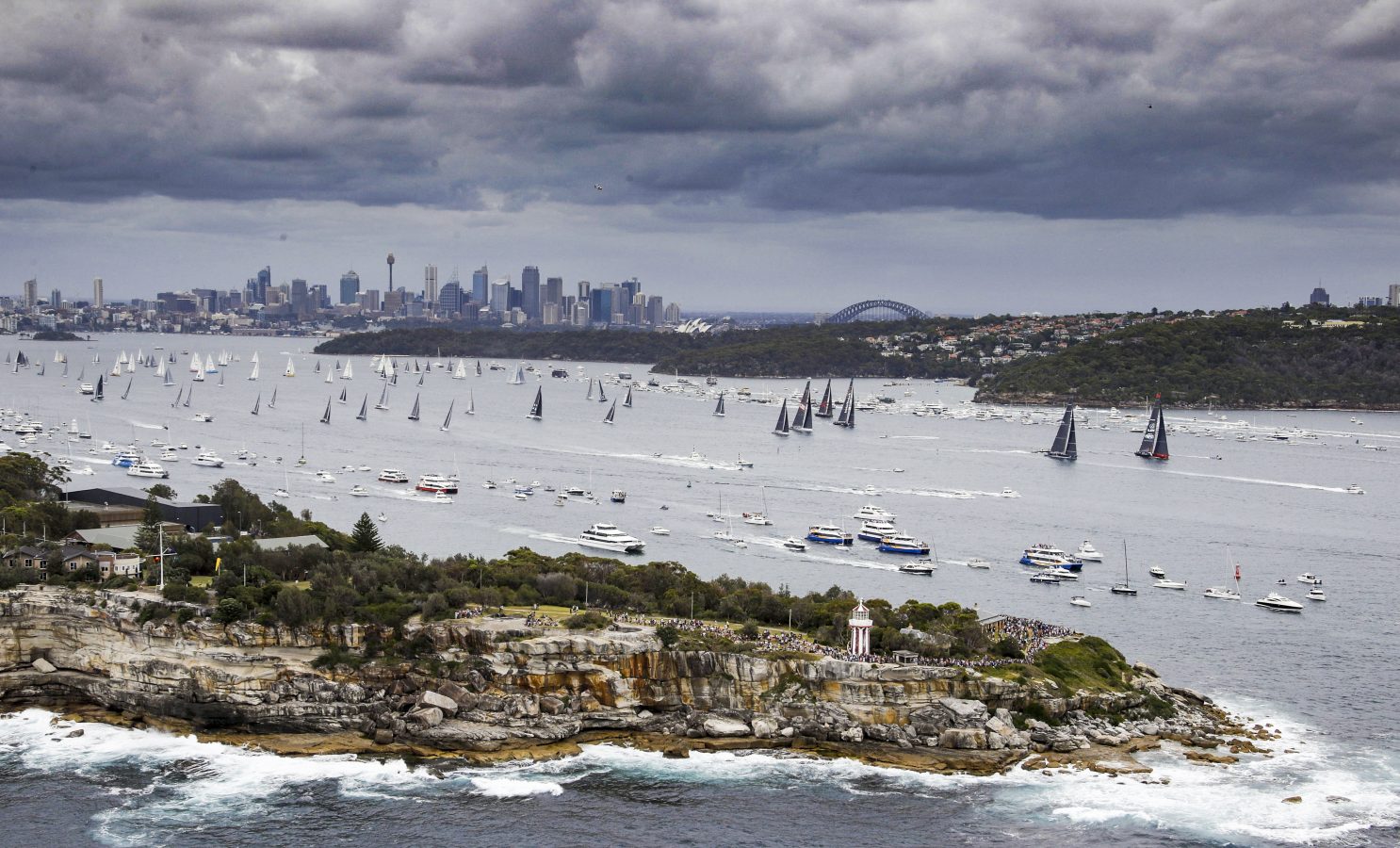
events
AND THEY'RE OFF
AND THEY’RE OFF!
A 102 boat fleet sets off in the 2017 Rolex Sydney Hobart Yacht Race
The forecast at the start of the 73rd Rolex Sydney Hobart Yacht Race was cloudy with a chance of rain and potential to break race records. This Boxing Day tradition in Sydney drew a spectator crowd on land and lining the shore to see the 102 boat fleet off on their 628-mile slug to Hobart. While the big boats get the media coverage, the RSHYR draws a range of yachts sizes, yacht ages, and crew experience. There is something for everyone, and while the goal is to be first to finish, you first have to finish; not always easy in this famous race.
We at North Sails wish all competitors good luck a safe journey. We’ll be on race and record watch in the meantime…
Enjoy this selection of our favorite images from the start line in Sydney Harbour.
The 102 boat fleets charges up Sydney Harbour before heading offshore. Our North Sails team in Australia says every sailor should have this race on their bucket list. We say the everyday sailing fan should have spectating in Sydney on their list! ©Rolex/Studio Borlenghi
Peter Hamburg’s Black Jack and Jim Cooney’s LDV Comanche were locked together at the start. The Maxis are expected to take two-three days to finish, while the smaller boats in the fleet can take four, five, or six days. ©Rolex/Studio Borlenghi
The RSHYR has three start lines. Wind and water are quite disturbed after the Maxis and the spectators following them. It makes for choppy conditions for the rest of the fleet. Seasick remedies anyone? ©Andrea Francolini
Wild Oats XI was struck by lightning last Sunday, damaging many of her electronics. It was a full team effort to get her race ready. ©Andrea Francolini
628 miles. We hear the welcome in Hobart is unreal. ©Rolex
READ MORE
READ MORE
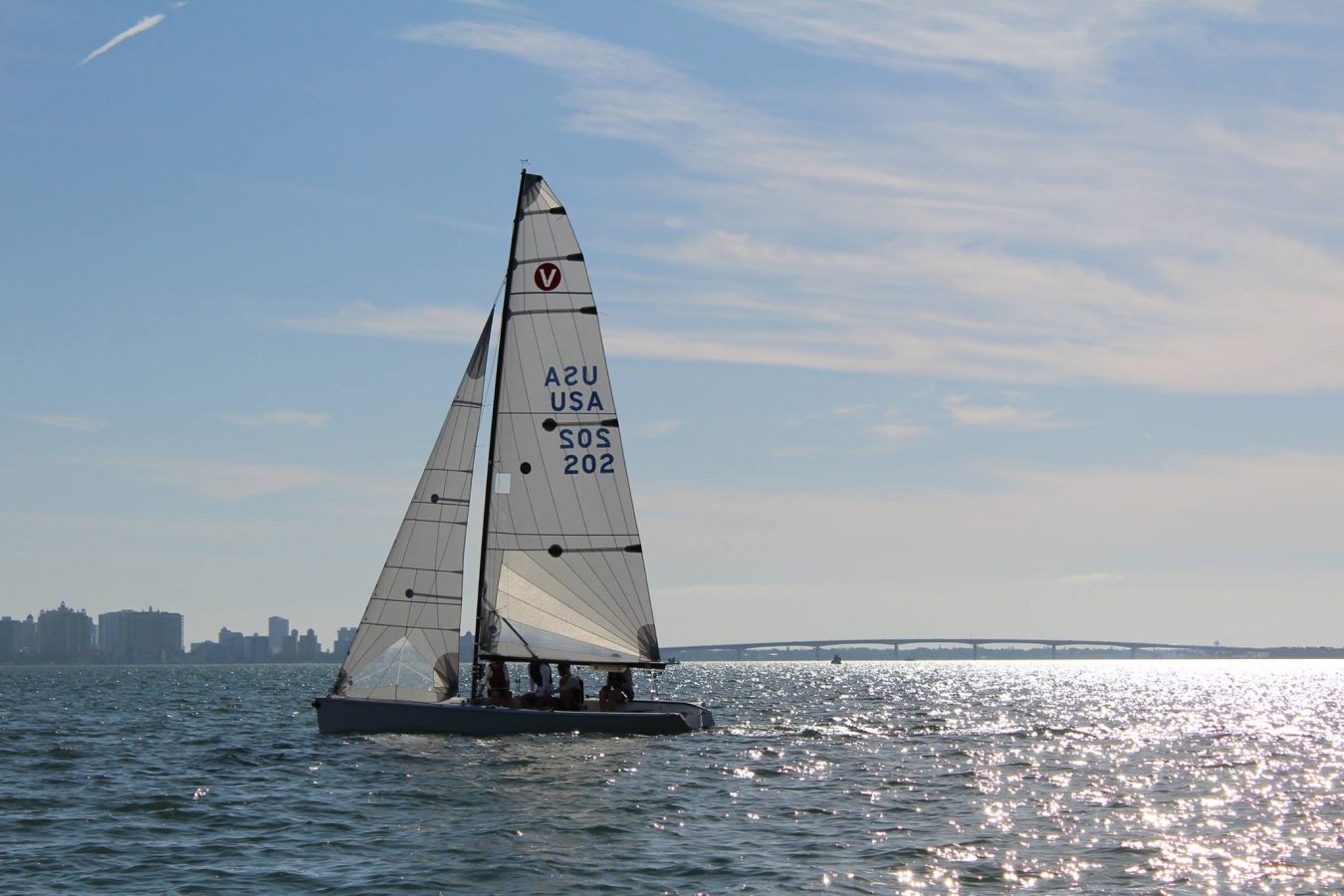
events
VIPER 640 LIGHT AIR TIPS
LIGHT AIR TIPS FROM THE 2018 WINTER SERIES OPENER
North-powered clients, Jay Rhame and Peter Beardsley, dominate Viper 640 fleet in Sarasota
Light winds challenged twenty-one teams for the first event for the Viper 640 Sarasota Winter Series. Saturday’s racing was cancelled due to the lack of wind, but four races were achieved in 2-7 knots on Sunday. Jay Rhame with crew Rachel and Peter Beardsley from Larchmont Yacht Club on Great Scott! dominated the event, winning all four races.
North Sails Viper expert, Zeke Horowitz, caught up with Peter and Rachel Beardsley after racing to hear about their day on the water and what they did to win all four races.
Peter, what was the key to your setup and why you were going so fast in the light air, both upwind and downwind?
It was really light. We were at 22 on the uppers. I was sitting in the boat a lot more towards the middle. I was playing the fine tune on the jib a lot. We were able to windward sheet the jib as long as we had at least five knots, which was something that Zeke told us to do a long time ago that we didn’t have much success with it until today. It allowed us to lift off people. I felt like a puppeteer for a while there when I was playing the windward sheet, leeward sheet, and fine tuning simultaneously. We were able to really open our gage on people at the right time. We tried not to do too many maneuvers because it was so light, and every time you made a big move, it affected your boat speed drastically. We tried to only tack once or twice a beat to keep our speed up.
Rachel, you were in the front of the boat. Tell us what you were looking for on the upwinds and the downwinds so you could avoid maneuvers but still get the overall strategy good enough so you can focus on speed?
“Our goal was to minimize the numbers of maneuvers, so we talked about the wind and where we thought the pressure was, making sure that whatever the strategy that we stayed on our goal to minimize number of tacks and jibe.”
I look at almost nothing else other than the kite when sailing downwind, but if we feel a little bit light the first thing we do, Jay and I, is to sit on the floor of the boat. Rachel, as our forward crew and tactician downwind, stands up on the foredeck with the best view. If we want to head up,we will all lean into leeward and try to use very little rudder. One of the weird things about today is that we usually have a mode where we lean to weather if we are going to fall off, and today we were never able to do that. It felt like it got half a knot lighter each race and we were almost never able to rock to weather to get it down. We were just trying to heat it up, heat it up and we kept our momentum on which was key.
Give us the 3 biggest tips for light air Viper sailing for someone new to the boat:
Don’t pinch upwind if you are under 6 knots. The boat likes to sail low and fast, we tack into 100 degrees in these conditions.
Downwind: Allow at least 3-5 degrees of leeward heel. Place yourselves on centerline so the boat is more sensitive to the puffs.
Pressure is key. Stay in the pressure and be cognisant of where the next puff is.
You guys were the fastest boat on the water. Anything you might change for next time?
The class changed the rule to allow a more vertical rudder bracket and we are going to install that before the January event and see how that goes. We are also going to move positions around the boat a little bit. Jay and I usually alternate driving in local events and we will do that in January and February. Rachel can do a lot more kite trimming with me up forward looking downwind. If all of us can do every job really well we know we are going to be faster as a team.
Congratulations Peter, Jay and Rachel!
Learn more about our products or contact your local expert
2018 Sarasota Winter Series – Event 1
1
Great Scott! / Jay Rhame / Peter Beardsley
3
Moxie / Zeke Horowitz
4
Merica / Paul Kleinschrodt
5
Coming In Hot / Michelle Lee
6
USA 264 / Jonathan Nye
7
Caterpillar / Peter Ill
8
USA 105 / William Stocke
9*
Entourage / Nick Amendola
* Denotes Partial North Sails Inventory
Full results
First Place
Third place
More photos
READ MORE
READ MORE
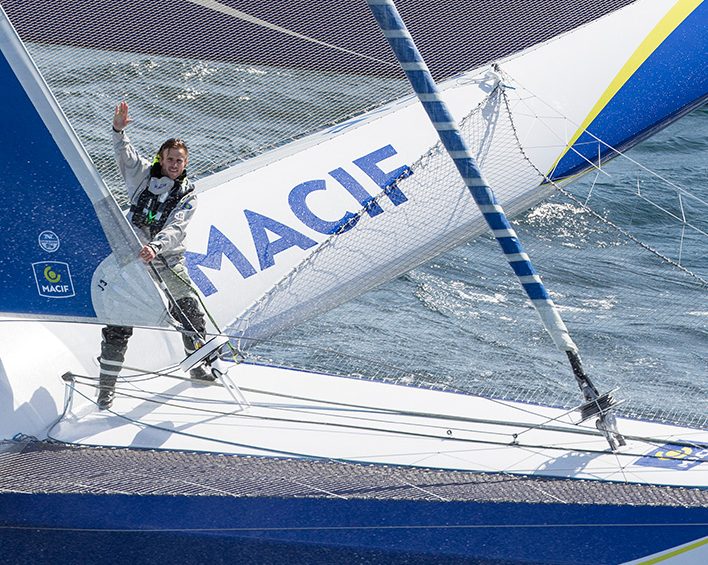
events
HOME FOR THE HOLIDAYS...RECORD IN HAND
HOME FOR THE HOLIDAYS…RECORD IN HAND
42 days. 16 hours. 40 minutes. 35 seconds. 3Di sails.
© Vincent Curutchet
François Gabart now owns a mind-blowing solo record pace. Gabart has broken the Around the World, Singlehanded record a few days shy of one year from Thomas Coville’s 2016 record of 49 days last December. Gabart’s accomplishment is most impressive, considering that Coville smashed eight days off a record previously set in 2008 by Francis Joyon, and this latest attempt falls only two days off the fully crewed around-the-world record.
Gabart’s full inventory of North 3Di sails powered Macif around the world at an average of 27 knots. The mainsail on Macif had 47,000 miles on it before the start of this record attempt. This latest record is further proof that 3Di technology produces sails are the highest performance and most durable.
2017 saw many records broken, smashed and shattered. Congratulations to François Gabart and the entire Macif support crew, who we’re sure are already planning their next adventure.
© Jean Marie Liot
READ MORE
READ MORE
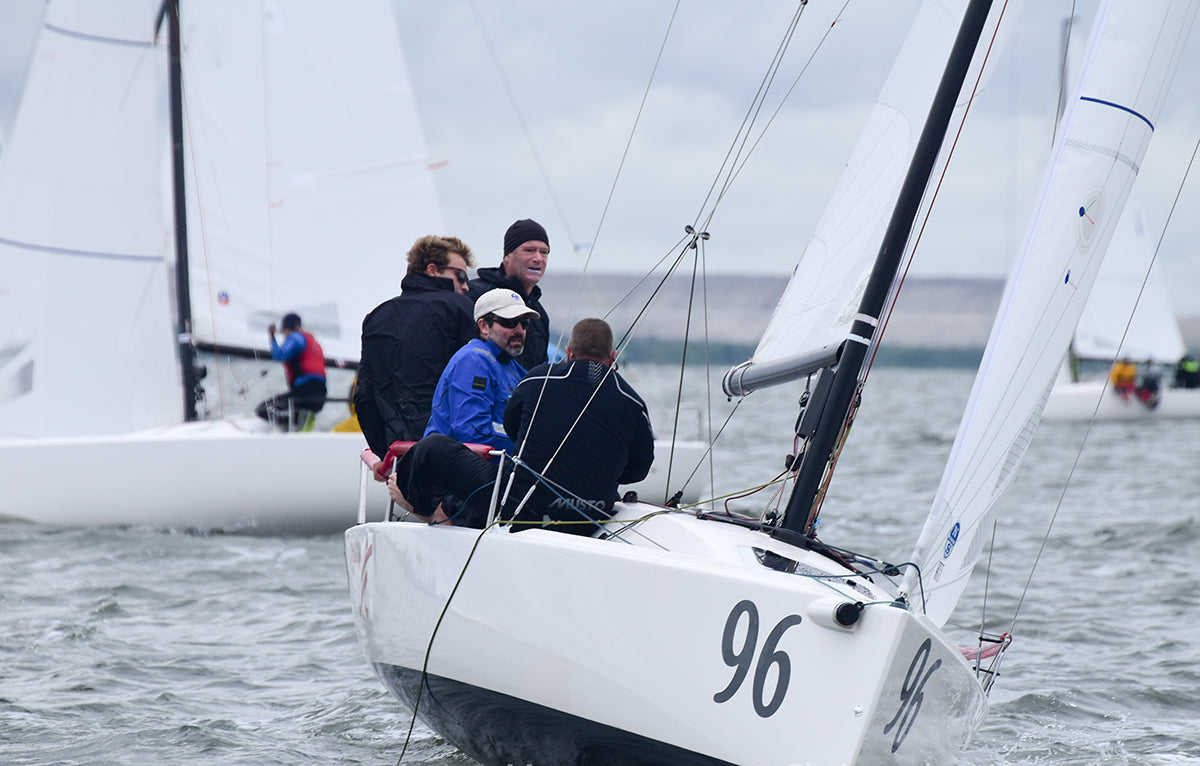
events
J/70 US WINTER SERIES OPENER: BIG BREEZE TIPS
J/70 US WINTER SERIES OPENER
Key Tuning and Trimming Points from Savasana’s Trimmer Tim Healy
Event one of the J/70 Winter Series at Davis Island was a great success for North Sails clients. With an approaching frontal system, teams were psyched to sail in big breeze that was forecasted. Seven races were completed in the highly competitive 53-boat fleet. It was tight racing throughout of the fleet but Brian Keane’s Savasana deemed to be the fastest of them all, taking first place with a 22-point lead from the rest of the pack. Two bullets and only one race out of the top five was an impressive way to end the regatta.
We caught up with Savasana’s trimmer, Tim Healy, to see what he had to say about tuning and trimming points that helped them win the regatta. Tim provided the team’s top three tips that kept their boat sailing fast.
Congratulations to our clients on starting the series off with a bang, sailing very well with outstanding results in some unpredictable frontal conditions. The North XCS-1 main, J-6 jib and AP-1 spinnaker were the most popular sails in the top 10. Boats powered by North finished 1,3,5,6,7,8*,9,10 and won 6 out the 7 races.
Tim’s Top Tips for sailing in big breeze:
Get the rig tune tight enough.
We ended up at 28 on the uppers and 30 on the lowers. This allowed us to use a lot of backstay before we would get inversion wrinkles in the main. A lot of backstay tension, with a tight rig, translates into a tight headstay. A tight headstay keeps the jib from getting too deep which can overpower easily and drag the bow down in the puffs making the boat hard to control.
If the rig is not tight enough, the mast will bend too easily when the backstay is applied resulting in inversion wrinkles in the main too early and the headstay never getting tight enough.
Move jib leads back 1-2 holes and play/ease weather sheet in puffs.
Moving the leads aft make the bottom of the jib flatter and the top twist off easier. When the top of the jib can twist in the big puffs, it dumps some of the excess power and allows the boat to be sailed flatter. The weather sheet should also be eased in the big puffs to open the slot, flattening the bottom of the jib more and adding more twist to the upper leech. In these big puffs it proved to be very fast, as the skipper would feather slightly in the sharp increase of pressure. If the jib had too much weather sheet or if the lead was too far forward, the boat would heel over too much. The main would need to be eased/luffed and the bow would be dragged down because the balance of the boat is thrown off. When the puff is over, the weather sheet can be pulled back on adding upper leech tension as well as depth to the bottom of the sail. Playing the weather sheet can all be done from the crew hiking on the weather rail without much movement. A steady crew that is sitting still and hiking is important for the mainsheet trimmer and helmsman to get in sync to balance out the helm and trim.
Downwind – Leave backstay on if in overpowering windy conditions.
This will not only keep the main flatter, but it will pull the luff of the spinnaker tighter as well. A tighter luff will flatten the overall shape of the spinnaker by moving the draft forward, making the leech of the spinnaker twist. Easing the traveler down all the way will make pumping more effective, and give the main trimmer more control of the main leech. When the traveler is all the way to leeward and the trimmer pumps the main, the boom not only comes in to weather but it also is being trimmed more effectively down. This acts like pulling the mainsheet and vang on at the same time. When the big puff hits, a quick ease of the main will open up the leech allowing the boat to stay under control and ripping with very little vang tension.
Need to step up your game? Contact your local North Sails expert today for the latest products to get you up to speed for the winter sailing circuit.
J/70 2017-18 US Winter Series – Event 1
1
Savasana / Brian Keane
3
Stampede / Bruno Pasquinelli
5
NINE / Oivind Lorentzen
6
Tea Dance Snake / Todd Jenner
7
Scamp / Will Welles
8*
Flojito 3 JT / Jack Franco
9
Rimmette / John Brim
10
Polar / Doug Clark
* Denotes Partial North Sails Inventory
Full Results
READ MORE
READ MORE
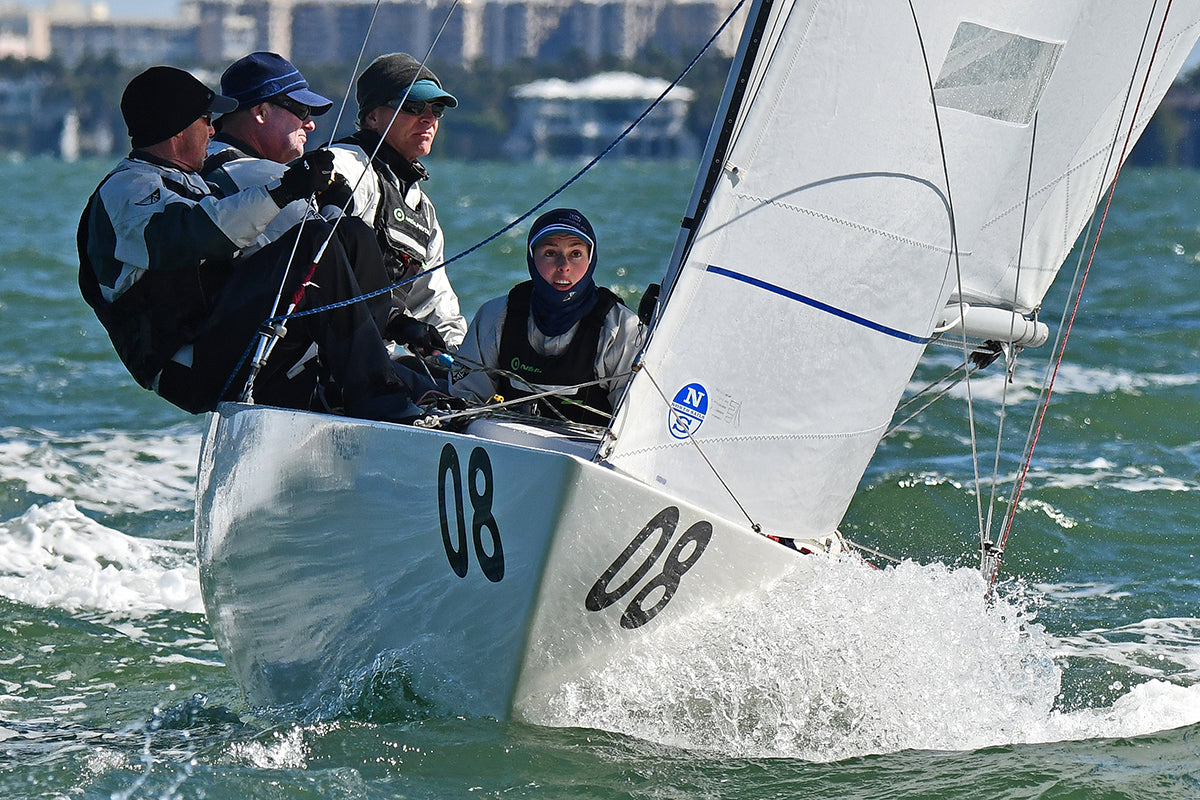
events
NORTH CLIENTS DOMINATE 2017-18 ETCHELLS BISCAYNE BAY SERIES OPENER
NORTH CLIENTS DOMINATE 2017-18 ETCHELLS BISCAYNE BAY SERIES OPENER
Congratulations Jim Cunningham and team Lifted! North Sails 9 of top 10!
The Louis Piana Cup, first stop of the 2017-18 Biscayne Bay Etchells Series, started out with a bang for Jim Cunningham and his team of Jeff Madrigali, Mark Ivey and Serena Vilage who took the regatta by one point over visiting Brit Lawrie Smith and his 3 amigo team of Richard Parslow, Goncalo Ribeiro and Graham Sutherland.
Tight rigs and warm clothes were the call as five races were expertly run by former world Champion Stuart Childerly and his great team from Biscayne Bay Yacht Club. A very strong cold front delayed racing on Saturday by a couple of hours as the race committee wisely held the fleet on shore as dangerous thunderstorms with 50 knot gusts and tornadoes were moving down the state. Two races were completed with Jim and Lawrie atop the standings after the first day.
Sunday brought an early start, unseasonably cool temperatures, and blustery strong winds. Steve Benjamin and his team showed some of his World Champion form to take the first race in 18-22 knot winds while the rest of the day was owned by Jose Fuentes with his crew of Luke Lawrence and Ian Liberty. In a dying and very shifty north westerly breeze they took control and won both of the final two races and pulled themselves into 3rd place overall—very impressive. Equally impressive was the fourth place all Corinthian team of Peter Vessella, Tracy Usher and Mark Callahan.
The North Sails PC-Fm Radial Head mainsail used by the top teams continues delivering impressive performance. Most teams opted for either the GM 6.5 heavy air jib or the LM-2H radial head jib for the strong winds of the weekend. It wasn’t until the final run of the last race that teams choose to put up the VMG spinnaker instead of the Full Runner.
2017-18 Luis Piana Cup
1
Lifted / Jim Cunningham
2
Alfie / Lawrie Smith
3
Caramba / Jose Fuentes
4
Peter Vessella / Mahalaga
5
Lion Heart / Adrian Owles
6
SCIMITAR / Steve Benjamin
8
Blackadder II / Andrew Cumming
9
Freedom / Craig Mense
10
America Jane II / Scott Kaufman
Full results
READ MORE
READ MORE
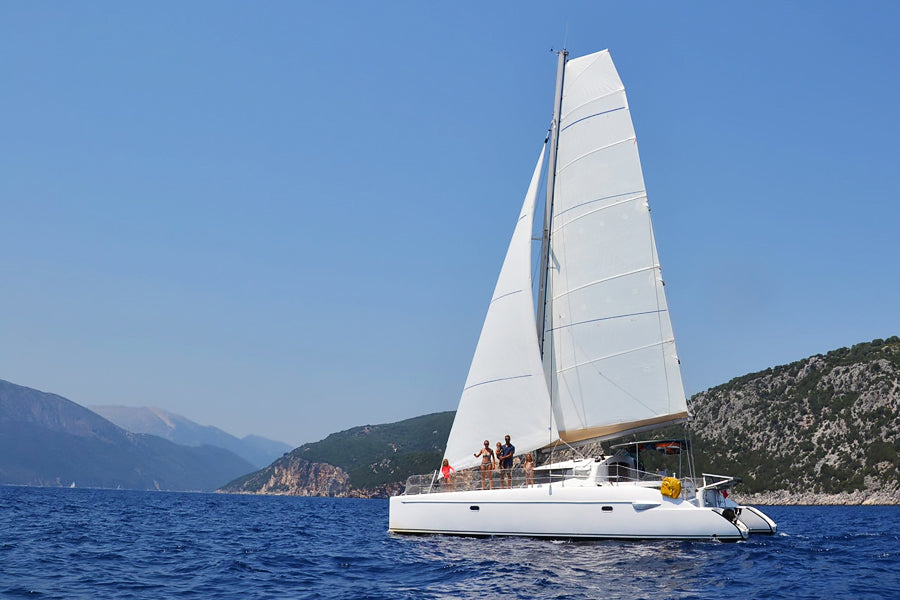
events
GUSTAVE'S ADVENTURES IN THE MEDITERRANEAN
Gustave’s Adventures in the Mediterranean
The Aubert family indulges on their Mediterranean adventure aboard their Lavezzi “Gustave”, powered by 3Di NORDAC
One couple, three young children, a catamaran, and six months sabbatical to make the most of the Mediterranean. That was the project in 2017 for Jérôme Aubert, 40, and his wife Hélène, 35. The couple have three children: Jeanne, Louise and Arthur, who are seven, five and two respectively. At the same time, Jérôme quickly became interested in a catamaran, for him the ideal platform to travel across the water with young children. Not necessarily an obvious choice for this sailing professional as he has been working at Harken for eight years where he is more accustomed to the rigors of monohull racing.
Jérôme has in fact the perfect CV of a pure sailor: Optimist, Europe, Melges 24, Figaro – he took part in the Figaro Solitaire Race in 2006 and the Tour de France à la Voile. This long summer journey will therefore be a voyage of double discovery: the catamaran and cruising! He settled on a second hand Lavezzi 40 (built by Fountaine-Pajot): the boat was in great shape but the sails not so much. It was for this reason that the relationship with North Sails started. The sailmaker, at the time going through a test phase for its 3Di NORDAC, proposed a special price for a totally new sail plan, a square top mainsail with full battens and a furling solent. The sails were delivered to Saint Nazaire two days before taking the boat down to the Mediterranean. This wasn’t due to a late delivery, but thanks to a good weather window! The expected downwind breeze arrived in the Bay of Biscay, but a little punchy all the same:
“We had 45 knots twice, on the nose” recalls Jérôme. “At times more than 15 knots surfing, an initiation of fire for new sails!”
After 2 stopovers and 10 days sailing, Gustave arrived in Ibiza. It was from here that the family cruise started. On the agenda, the Balearic Islands of course, Sardinia, Sicily, Southern Italy, Montenegro, Albania, the Ionian Islands, the Peloponnese, the Amalfi Coast, Capri and Ischia, and Corsica. Hélène’s summary “167 days, 165 those were sunny, 4,800 miles sailed, seven countries, 15 pairs of sunglasses, 10 bottles of sun lotion, four tuna caught, five wasp stings, two stitches, 25 kilos of bananas.” Jérôme strived to sail in manageable conditions and with the wind from behind. By the end of the journey, Gustave had not used her engine and had practically never tacked. And even though the basis of sailing in the Mediterranean consists of little leaps from mooring to mooring, the Aubert family journey still counted some beautiful crossing, up to 310 miles. It was the perfect opportunity to test the new 3Di NORDAC sailing on a catamaran on an intensive cruise.
“After 6,000 miles of sailing, they haven’t changed shape and handled the UV exposure very well,” noted Jérôme, “The same for the material around the forced slats, which held very well.” And with the sale of Gustave, to return to another cruise, presenting the beautiful North Sails 3Di NORDAC onboard is most definitely a plus.”
READ MORE
READ MORE
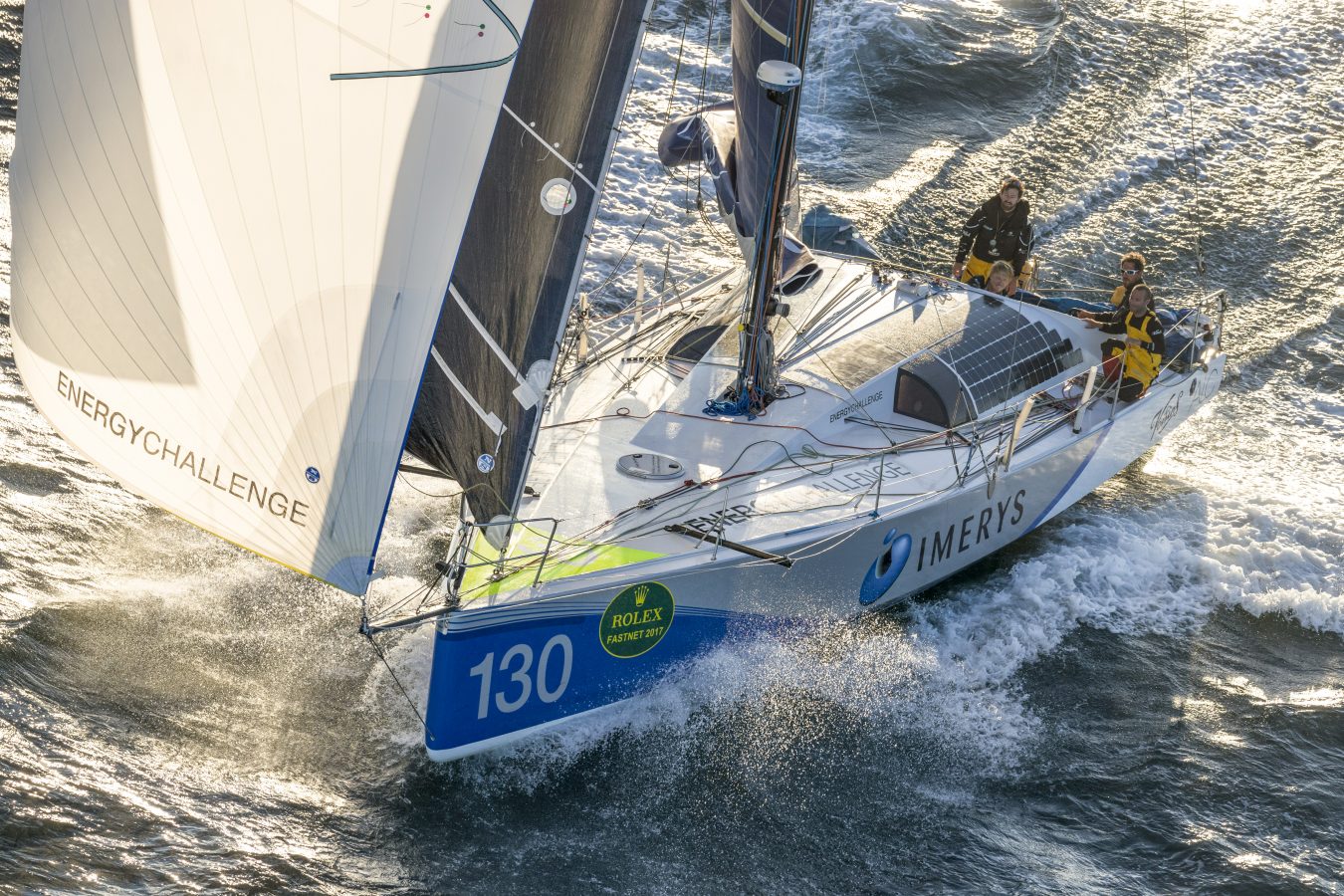
events
INTERVIEW WITH CLASS 40 CHAMPION PHIL SHARP
INTERVIEW WITH CLASS 40 CHAMPION PHIL SHARP
Imerys Clean Energy skipper Phil Sharp wins Class 40 Championship in the finale Transat Jacques Vabre
© PhilSharpRacing.com
We caught up with the skipper of Imerys Clean Energy, Phil Sharp, on his Class 40 win after completing the Transat Jacques Vabre, the final race of the 2017 Class 40 season. Powered by North Sails 3Di, Phil has been competing in Class 40 division for just two seasons now, and winning this year is quite the feat! Placing 1st overall, with a lead of 247 points after five events: Trophée Guyader, Normandy Channel Race, Les Sables Horta, Rolex Fastnet Race and the Transat Jacques Vabre, Phil looks forward to his next opportunity to shine.
You are relatively new to Class 40. What does this achievement and quick rise to success mean to you?
This is my second full season sailing in Class 40 which is now a very established and competitive offshore Class. I would say that it takes one full season to achieve that all-important reliability, and to really learn how to maximize the boats potential. It has been a lot of work over the last 18 months, so what we have achieved this year is really satisfying for everyone involved and it is really great to reap the rewards.
What do you think enabled you to get the level of consistency you needed to win this series (preparation, hardware (including sails), decisions, weather etc) and with such a huge margin?
If I compare this season against last, I think this year we really had the time to meticulously prepare the boat, particularly towards the end of the season. This meant that it was possible to spend the vast majority of the race focusing on strategy and speed, rather than fixing things, which is absolutely key.
“The sails are fundamental in this equation – in order that you can race with real confidence you have to have sails you can rely on, that are well-tested and that you can push hard with.”
What did North Sails do to support you in making an impact in Class 40?
Where North Sails have been particularly supportive and professional to work with, is in the development process. It is virtually impossible to create the perfect sail out of the box, so they have given us some great support in listening and understanding to what we wanted, what we needed to improve, and optimizing the sails to meet our objectives. This has definitely given us important performance gains throughout the season.
When did you take delivery of your sail inventory? Have you added or replaced any sails for the 2017 season, and your ultimate victory?
We started building up an inventory from July 2016, when we started working with North Sails. This has been a gradual process replacing the sails that came with the boat, according to our budget. We have also worked with North Sails on developing and modifying new sails by tweaking the shape and looking at the effects on the water.
“This was a real eye-opener and a great learning experience for me – to really see what a difference the sails could make to performance.”
How did you feel about your sail inventory, how did it fare over the series and are there any changes you would like to make to it (and why)?
I was actually really pleased with how everything performed in the TJV. In particular, two fractional sails that worked really well were our A6 and A5, which enabled us to push the boat hard during windy conditions. If anything, I would work on developing our reaching setup and perhaps refine the Code 0 for reaching, rather than upwind.
What was your greatest memory of the TJV?
Escaping the doldrums. We had had a pretty awful time to the west with seriously light airs, which pushed us back from 1st to 4th, with the boats to the east of us getting slightly more pressure for two days. The last night was particularly dreadful with lots of wind shifts and we were sure we had lost out. However, when we downloaded the positions the next morning it was a very nice surprise to see that we had pulled back into the lead with a 10 mile advantage, and had managed to break into the southeast trades before the others. We rewarded ourselves with a large portion of porridge that morning!
Other than winning, what was your greatest achievement of the series?
“Leading 12 of the 17 days of the TJV was a nice statistic to finish with. As well as being able to report zero sail damage at the end of an Atlantic race! Although that is largely North Sails achievement as well as ours!”
So Phil, what’s up next for you?
After a great season in Class 40 we feel it is a good time to move up to IMOCA 60 so we are working on attracting further support for a highly competitive entry towards the 2019 Barcelona World Race and the Vendee Globe 2020.
© Carlo Borlenghi
© Jean-Marie Liot / ALeA / TJV2017
READ MORE
READ MORE
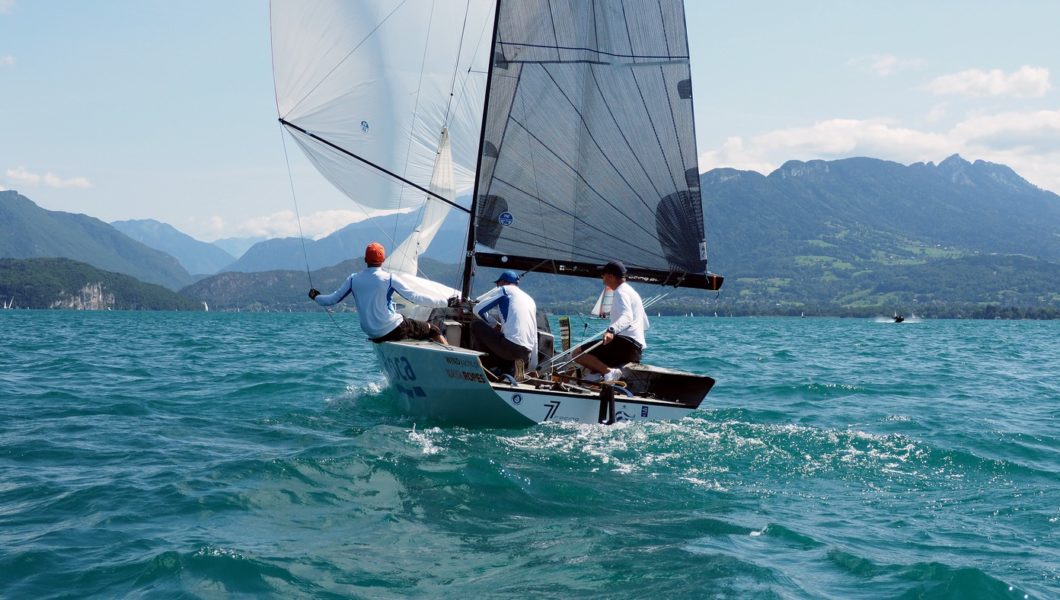
events
TARNACKI DOMINATES MICRO CLASS WITH ALL NEW NORTH INVENTORY
TARNACKI DOMINATES MICRO CLASS WITH ALL NEW NORTH INVENTORY
With the support of 6-time World Champion Piotr Tarnacki, North Sails came into Micro class in 2017 with an all new prototype sail inventory which included:
– MK-1 Mainsail
– JK-1 and JK-1 Light Jibs
– SS-1 Spinnaker
Tarnacki with his team, 77 Racing dominated season with a stunning 23 out of 26 race wins in Polish Cup regattas, which included the Polish Nationals. The Polish fleet is the toughest Micro fleet in the world. The main test took place at the World Championship in France.
Sixty-eight crews were fighting for the 2017 Micro class World Championship title in French Annency. The competition was very tough with very light conditions for the event, making sailing a big tactical challenge. Due the lack of wind there were only 4 races, of which one was a long-distance race.
A championship battle took place between the two Polish crews, Piotr Tarnacki and Piotr Ogrodnik. Combined the skippers have won 10 World Championships since 2004 (6 times Tarnacki, 4 times Ogrodnik) so there was true duel of the Micro class giants. However Tarnacki took the overall win, giving him his 7th World title.
Piotr Tarnacki said :
“We were very pleased that we could use North Sails for this regatta. The Jk1-L Jib let us sail fast up to windward mark, but our biggest weapon was SS-1 Spinnaker which make us the fastest boat on a downwind course. We are very happy with our sails performance. This is first step for North Sails in Micro class, and we have already won everything this season. We are very happy, but now we will start preparing for the next worlds in our home waters in Poland. Together with North Sails we will keep developing these sail design to be even faster next year!”
If you are interested in any Micro class products, visit the One Design Class page to find an Expert.
READ MORE
READ MORE
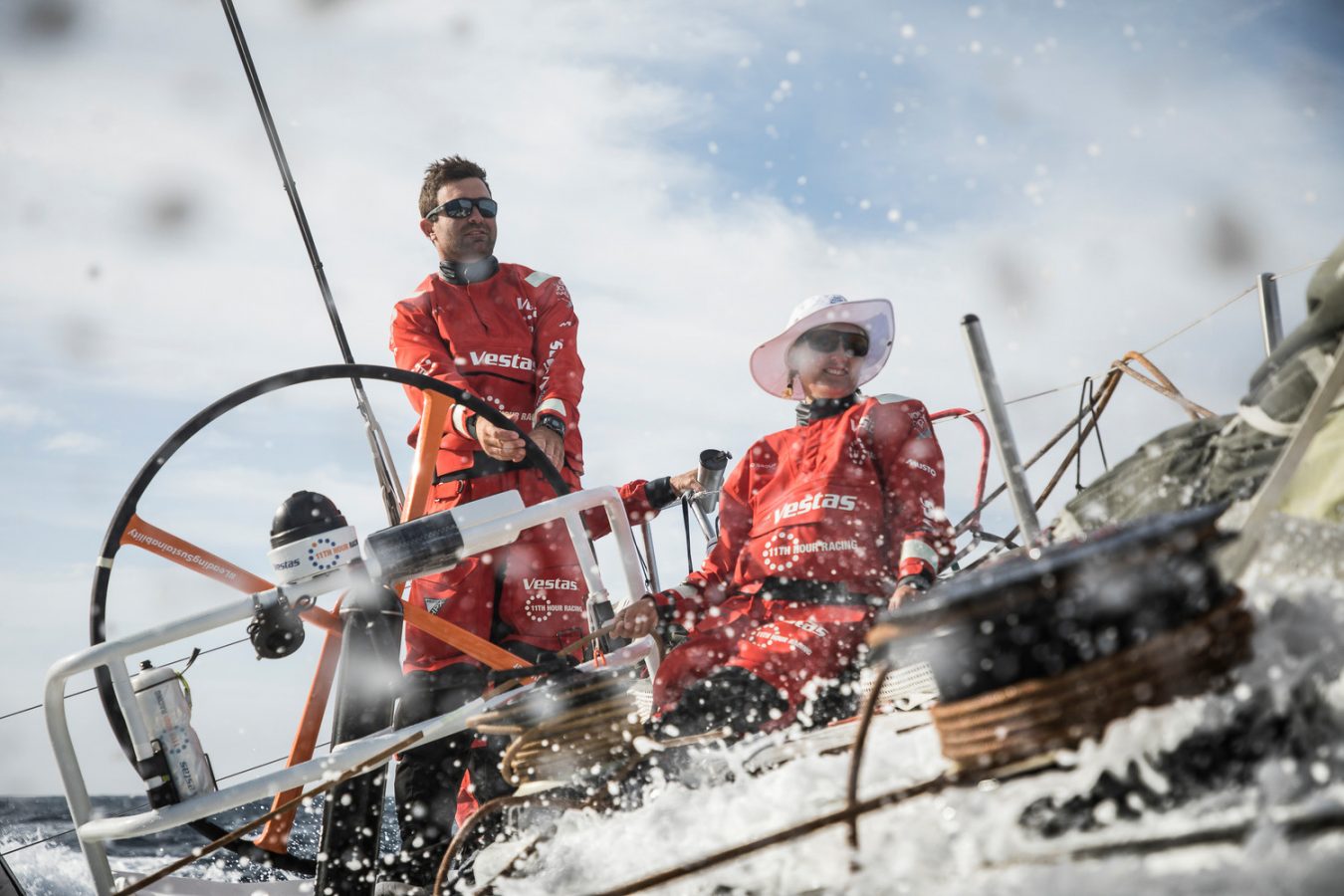
events
VOLVO LEG 3 PREVIEW WITH CHARLIE ENRIGHT
VOLVO LEG 3 PREVIEW
Charlie Enright, skipper of Vestas 11th Hour, shares his insights of what is to come next in life at the extreme
©Martin Keruzore / Volvo Ocean Race
Vestas 11th Hour’s skipper (and North Sails expert) Charlie Enright stopped by our Newport office on his brief trip home before the start of Leg 3 from Cape Town. We were able to sit down with him for a few minutes to chat about the race so far and check in before the fleet makes the deep Southern Ocean dive in Leg 3.
Two legs of the Volvo Ocean Race 2017-18 down. Your first big offshore leg complete. What is your first impression of the race so far?
My first impression is the racing is closer than ever, which I guess you’d come to expect given how close it was in the 2014-15 edition. Things are the same but different. The weather’s the same, the polars are the same, and now there’s overlap in the sailors. Difference is all players have been shaken up; same faces, different teams, different mix of knowledge within the teams.
You have a new team with a lot of experienced race veterans. How is it this time around? Since you’ve done this race before – what’s the difference in the team this time?
Mark and I inherently are experienced by having done one before. But, there’s a lot of people that have done this race for a long time and never won. So in addition to adding experience, we’ve tried to add winning experience. I think it’s important to differentiate between the two.
“I think that’s healthy to have a crew that brings different things to the table. We have a variety of ages and nationalities. We’ve got the ladies onboard. Keeping that whole thing running is fun, and vital to the success of the team.”
© Martin Keruzore / Volvo Ocean Race
Are your expectations higher or are they more realistic because you know more this time around as well?
Yes, higher. But it’s tough. I struggle with that question because there’s something great about being naïve. You know?
It can be great not knowing what will happen in the end…
And going for it. We didn’t know what we didn’t know last time, but at least we knew that. We didn’t go into it under any pretenses last time, by any means. But it’s nice to have a little experience to rely on.
“We didn’t have any expectations before because we didn’t know what to expect. Now we feel like we’re contenders in this race, and I think that the winner is going be the boat that improves the most between now and the finish. I feel Vestas 11th Hour Racing has every opportunity to be that boat.”
What would you say is the most difficult part of this race so far?
Trying to find boat speed, but that’s always the case. The fastest boat is going to win this race, and that’s what everybody’s yearning to be. We’ve got a little work to do in some very specific areas, but at least now, after this leg, we know what those areas are and where to focus our efforts.
© Ainhoa Sanchez
You’re heading to Melbourne on Sunday. What are you looking forward to (or not looking forward to…)?
Anyone that tells you that they like the cold of the Southern Ocean is probably lying. Having said that, I much prefer cold to the Equator because you can always put on another article of clothing. Conversely, once you’re baking in the sun, you can’t get any cooler.
But you know, I look forward to going downwind. That’s one of the greatest feelings in sailing. I look forward to the double points, I guess, but I don’t know why, because it doesn’t change how you approach the legs. You’re always trying to win. You just happen to be double points.
Do double points put more pressure on you guys?
It can’t. Or better said you can’t let it. I mean you can’t operate differently based on the fact that it’s double points. Some would say they are disproportionately happy or disproportionately angry after the fact, but it can’t affect the way you approach the leg.
How are the sails holding up?
Good. We had some sail damage in the last leg. We had a batten pocket come off our J1. It was one tack in the pre-start, in the river in Lisbon. But I think the damage might’ve occurred the day before, during the in-port race when it was a blunt 40 when we were sailing in a squall.
“Our 3Di sails continue to be a very robust product and the right one for the job Just like last race; the sails aren’t going to be something that you think twice about.”
Follow your favorite team at VolvoOceanRace.com for updates, latest news, routes, and results.
© Martin Keruzore / Volvo Ocean Race
© Ainhoa Sanchez
READ MORE
READ MORE
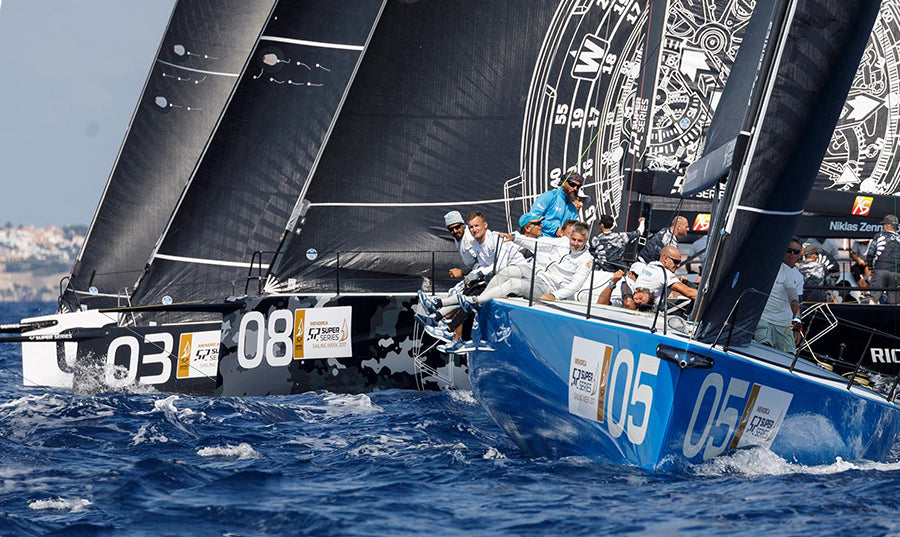
events
GRAND PRIX TREND REPORT
NORTH SAILS DESIGN TEAM HOSTS 2017 GRAND PRIX RACING DEBRIEF
Experts collaborate in two-day design meeting at North’s 3D headquarters in Minden, NV
© Nico Martinez / Martinez Studio
Earlier this month the North Sails Design Team hosted a collaborative Grand Prix racing debrief at the company’s 3D sailmaking headquarters in Minden, NV. Attendees brought a range of expertise to the discussion, including the TP52, RC44 and Maxi 72, as well as emerging classes such as the Melges 40 and ClubSwan 50. The two day agenda also covered discussion in complementary fields of software development and product engineering, led by North Sails Lead Programmer, Michael Richelsen.
Strength in design has kept North Sails ahead of the curve in providing the fastest sail shapes for clients throughout the sailing world. The design brief is an example of how the North Sails global team works together to secure a common foundation and commitment to technical excellence. As a result of the meeting, North Designers and stakeholders worldwide will receive a “Trend Report” for key classes and sail types with reflection on how these can affect designs for the wider market.
Per Andersson was recently appointed as head of North Sails 3D. His experience as a sail designer will ensure he has a hands-on role in the merging the processes of sail design and production. Beyond Per’s valuable contribution to the design discussions, he also hosted the group at his “home”, North’s largest 3D loft in Minden Nevada.
Paul Westlake, VP and North’s Grand Prix sales leader who together with Per Andersson hosted the group in Minden. In addition to his sales responsibilities, Paul provides first-hand feedback from the field through his various sailing commitments.
JB Braun inspects finishing details on a 3Di sail. JB provided the group with lessons learned in 2017 and updates to the North Design Suite as well as development news on everything from small boat one design through the 37th America’s Cup. As Head of Sail Design to a team of 80+ experts, JB is responsible for turning the meeting ideas into projects and providing focus to North’s design team.
Steve Calder, the lead designer for downwind, ran the debrief on Grand Prix downwind development and looking ahead to new concepts for 2018.
Magnus Doole led the group in a discussion on “Engine Above The Deck; ” a term coined by Terry Kohler, former owner of North Sails. Engine Above The Deck is used to describe integrated sail, rig and hull analysis and design.
Grant “Fuzz” Spanhake is the coach for Alegre and provides an “outside view” of North Sails performance during the 2017 season. Feedback from coaches and sailors is imperative to continued development and innovation within the Grand Prix design team.
Casually referred to as “the smartest people in North Sails,” Burns Fallow and Michael Richelsen are user and developer of North Design Suite. Burns, a lead designer for Superyachts and Grand Prix programs, has most recently been helping ETNZ with the AC75 rule. Michael is North Sails Lead Programmer who writes the proprietary software that runs North Design Suite. In addition to sail design; NDS makes the “Engine Above The Deck” concept possible.
Mickey Ickert provided a design debrief on the TP52, RC44 and Maxi 72. His debrief included design analysis of all teams, in all classes. The analysis gives North’s design team insight on what designs are delivering results and areas for improvement.
Juan Garay is a sail designer for TP52 Azzurra and oversees the continued development of North’s Virtual Wind Tunnel, a tool within the North Design Suite. VWT models air flow on downwind sails and the sail designer to visualize and analyze sail shape, sail forces, shape stability and ease of trim in the computer at 100% scale. Juan briefed the group on VWT updates and developments planned for 2018.
Shane Elliott, designer for TP52 Phoenix 2 and Grant Spanhake, watch as 3Di tapes are loaded into a tape head. The use of spread filament tapes used in conjunction with full-size 3Di molds is what give North 3Di its unprecedented combination of performance and durability.
READ MORE
READ MORE
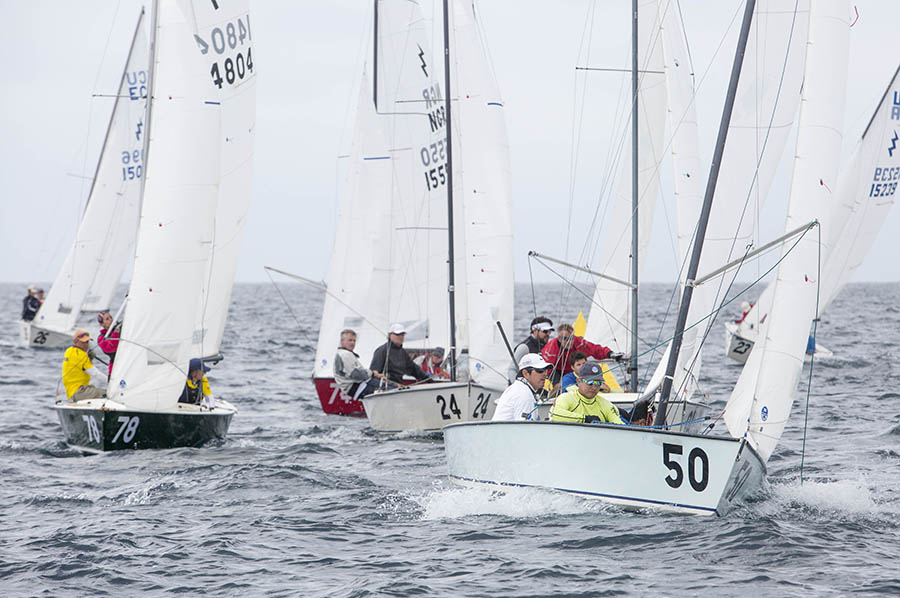
events
LIGHTNING WORLD CHAMPIONSHIP
2017 LIGHTNING WORLD CHAMPIONSHIP
North clients sail for speed in Ecuador taking the fleet by storm claiming World title, sweeping the podium
©Manuel Medir / Salinas Yacht Club
Fifty-six Lightning teams from 13 countries gathered in Salinas, Ecuador for the 2017 World Championship. Javier Conte and his teammates, Julio Alsogaray and Paula Salerno of team Argentina captured the 9 race championship in dominating fashion. Using North Sails M-5 main, 5A+ jib and R-2 spinnaker , Argentina scored six race wins and an overall total of 12 points on the scoresheet to cap an impressive 28-point margin of victory over the young runner-up team from the USA of Nick Sertl, Dylan Farrell and John Mastrandrea.
Salinas provided great breeze for sailing every day. As the breeze built every afternoon, the shifty conditions and variable wind patterns required skippers to concentrate on boat speed. A large hill located on Salinas Point caused confused wind patterns as it funneled down to the bay. Some teams found success extending out to the right as the shifts on the edges of the course were often game changers. Pressure lanes combined with significant shifts, including a distinct shift on the port lay line kept things interesting at the top mark and made finishes just as hard for competitors as it did the race committee scoring team.
Ched Proctor, sailing his aptly named Veggie Sub with son Charlie and Meredith Killion had excellent speed throughout the week. Coming off his win at the International Masters, Proctor, using the North M5 main, new V-17 jib and R2 spinnaker credited his team’s’ ability to focus on their jobs, allowing Ched to focus on driving which became a key sailing upwind in wavy conditions.
“We relied heavily on our middle crew member to make tactical decisions and the forward crew would call the puffs and lulls,” said Ched.
Congratulations to our clients on outstanding results! Seven countries including Argentina, Ecuador, Puerto Rico, Brazil, Chile, Canada, and the United States rounded out the top ten spots. Junior team Freak Gasoline Fight Accident placed 2nd overall, with five race finishes in the top ten. Way to go Nick Sertl and team! Raul Rios and his team Black Beauty representing Puerto Rico, topping the podium off at 3rd place with five top-five race finishes.
Special congrats to team Argentina’s Javier Conte, Julio Alsogaray, and Paula Salerno, who not only won the North Americans earlier this year but took the South American title earlier in the week and finished off by claiming the 2017 Lightning World Champion title!
Team Argentina was powered by North Sails M5 mainsail, 5-A+ jib, and R2 spinnaker.
Impressive sailing by our clients, and great memories for all to take home. Thank you, Salinas Yacht Club for running three fantastic events International Masters, South Americans, Worlds> over the course of nine days, giving sailors an experience of a lifetime.
“It’s hard to think of a better place to hold a Championship Lightning event. The organizers did a fantastic job, and I look forward to returning to Salinas soon”, said Jackson Benvenutti, tactician on Hard Asset.
Click here for more information on our products, or to speak with your local expert
Visit our tuning guide to get the winning numbers for your next event!
2017 World Championship
Lightning
1
Argentina / Javier Conte
2
Freak Gasoline Fight Accident / Nick Sertl
3
Black Beauty / Raul Rios
4
Veggie Sub / Ched Proctor
5
Team PatStrong / David Starck
6
The Cat / Marvin Beckmann
7*
Money for Nothing / Mark Sertl
8
Ojo de Lince / Alberto Gonzalez
9
No DesesPerez / Cristobal Perez
10
Layline / Claudio Biekarck
11
Hard Asset / Josh Goldman
12
15590 / Jeff Linton
13
Fly Volatore / Juan Santos
14
15412 / Tim Scanlon
15
El Doctorado / Felipe Robles
* Denotes Partial North Sails Inventory
Full Results
©Manuel Medir / Salinas Yacht Club
©Manuel Medir / Salinas Yacht Club
©Manuel Medir / Salinas Yacht Club
©Manuel Medir / Salinas Yacht Club
©Manuel Medir / Salinas Yacht Club
Congrats Team Argentina, 2017 Lightning South American & World Champions!
READ MORE
READ MORE
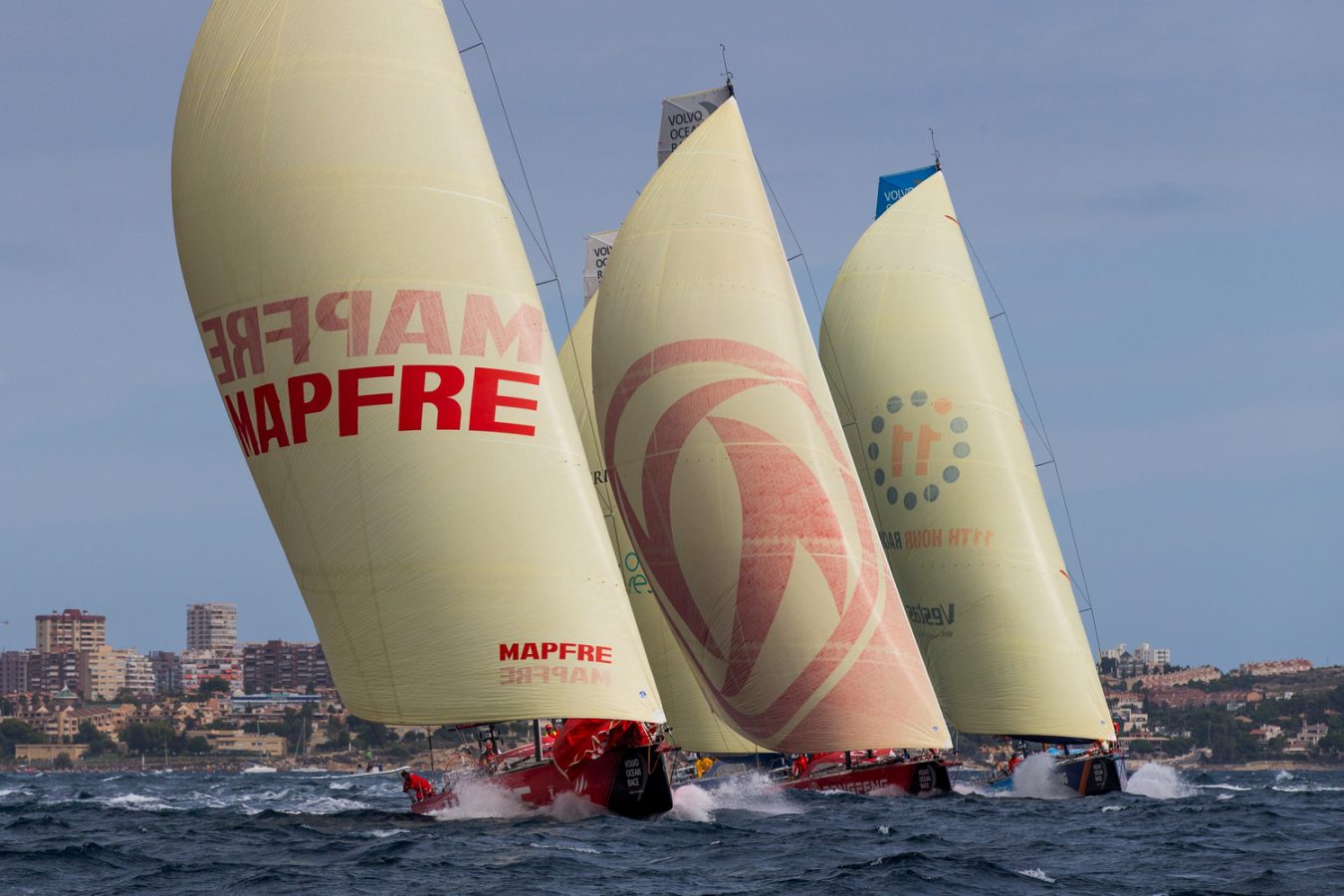
events
SAIL PROFILE: VOLVO OCEAN RACE A3
SAIL PROFILE: VOLVO OCEAN RACE A3
What are those yellow sails on the Volvo Ocean Race boats? North Sails CEO, Dan Neri, explains what’s so unique about the Volvo Ocean 65 A3
© Pedro Martinez / Volvo Ocean Race
The Volvo Ocean 65 A3 is unique because it is shaped like an Asymmetric Spinnaker, built like an upwind sail and furls like a genoa. The sail structure is 3Di Force, the lightest application of the 3Di composite sail product line.
3Di Force sails are made using prepreg tapes with a very high concentration of UltraPE material, co-mingled with Aramid filaments. The UltraPE provides high modulus and incredible toughness while the Aramid component resists compression and shrink. Like all 3Di sails, Force products are free of Mylar films which is one reason why the 3Di structures have extremely high strength to weight ratios. The newly developed 3Di Force product is so strong, and so reliable, that the Super-Maxi Comanche brought a single downwind Force sail for its recent Transpac record-setting run to Hawaii.
The yellow hue of the Force sails comes from the combination of UltraPE filaments (which are translucent, white) and Aramid filaments (which are gold). To keep the weight as low as possible, the A3 sails have very little branding so they show their true colors. All of the other sails in the Volvo Ocean Race 65 inventory are fully branded which masks the color of the sail structure. We are especially proud of the work done by the North Graphics team for this edition of the VOR. Our team painted 130 VOR sails over the course of just 6 months. We think the sails all look fantastic with the teams’ colors and logos.
All 3Di sails, including 3Di Force sails, are made on North Sails proprietary, full scale adjustable molds. However, a careful look at the photos will reveal a number of seams in the Force sails. The seams are required because these sails have very high camber ratios (remember, they are essentially spinnakers) and our molds are engineered for camber ratios found on upwind sails.* So the engineers at the 3D factories break each Force sail into sections for molding. Each section of the sail has camber in the range of an upwind sail, and when the sections are assembled the sail reaches the downwind camber dictated by the sail designer, with every square meter molded into a smooth 3-D surface. The seams are joined with a 2-part, ballistics grade Urethane adhesive. The width of each section joining seam is calculated to achieve a bond strength that is equal to the tensile of the 3Di composite in the area of the seam. The whole structure is in balance.
© Jen Edney/Volvo Ocean Race
3Di Force sails are proving to be downwind game changers for ocean racing boats that sail at high enough speeds to pull the apparent wind forward of the beam. The sails are too inelastic, and marginally too heavy to be used on boats that sail with wider apparent wind angles and less pressure on the sail. That might change in the next few years as we move further down the path of learning what is possible with 3Di composite sail construction.
*A good question is, “Why don’t you make deeper molds to allow one piece downwind sails?” The answer has more to do with real estate than engineering or economics. Our 3Di molds position the sail structure in space. The mold space has X,Y and Z dimensions. The tools we use to construct the sail structure on the mold hang from a gantry which is positioned over the mold. The gantry has to fit inside the building. Our current molds have a Z-throw limited by the height of the gantry (if the mold is adjusted to a camber exceeding the Z-limit, the gantry tools will crash into it). The gantries just clear the roof. To get more Z-throw we either have to raise the roof or lower the floor. Both of those options are ruled out by nature and government. The floor of the factory cannot be lowered because in the high desert of Nevada, the water table is just below the surface of the ground. If we dig down, we will make a swimming pool. The height of the factory building is restricted by local zoning ordinances because we are located adjacent to an airport. If we built higher, the local glider pilots might have trouble clearing our roof!
© Jesus Renedo/Volvo Ocean Race
READ MORE
READ MORE
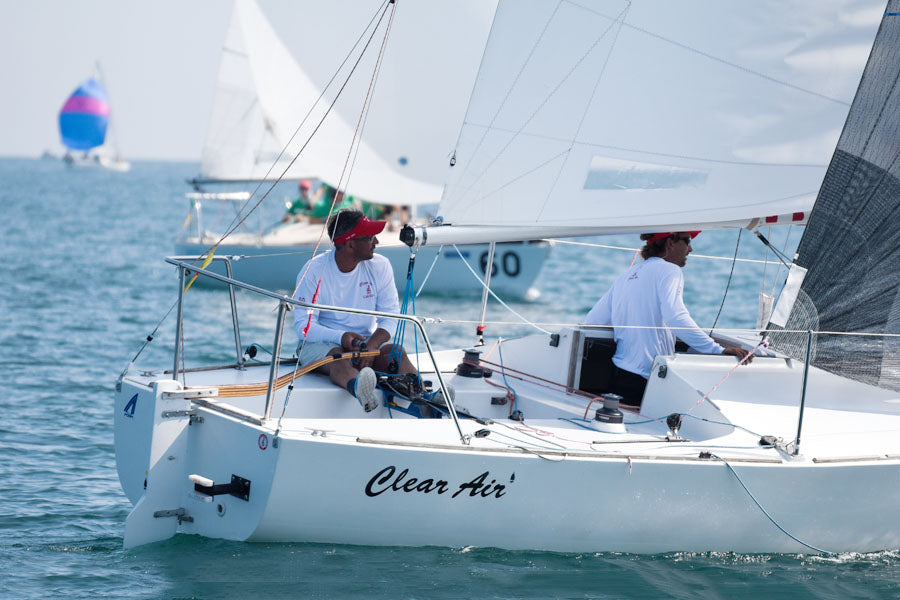
events
A WEEK OF CLEAR AIR
A WEEK OF CLEAR AIR
Interview with Rossi Milev, 2017 J/24 World Champion
Rossi Milev sailed his first J/24 Worlds in 2000 in Newport. He didn’t win, but really enjoyed the class and the boat, so like a lot of J/24 sailors, he kept coming back for more. Seventeen years later, he finally sailed to victory at his home yacht club in Port Credit, Ontario. He set his sights on the Worlds, which happened in September of this year. Boats began to collect in the parking lot days before the event with sailors who were eager to get their boats measured in and race-ready. Port Credit Yacht Club was so “on-point” for the World Championship, they were able to get all 63 boats registered and measured one day ahead of time. From a racer’s perspective, this speedy inspection was ideal, as sailors wanted to start focusing on racing and put in some practice time. Given the conditions that happened this year, and keeping in mind that weather is unpredictable, Rossi worked hard to get this regatta to his home yacht club, as he knew they would do a great job running a World Championship for the J/24 Class. Once they won the bid for hosting the event, Rossi set his sights on taking home the trophy.
Before the first race came to an end, the fleet knew this was going to be a very tough regatta. Rossi’s team Clear Air came across the finish line not quite where they expected.
“Looking at our results from the first race, local knowledge did not pay off. The fog was thick. Halfway through the beat we had committed to the left, which was normal, but it didn’t pay off at all.” Team Clear Air was disappointed, but before the second race they put their heads together and shared a prediction. “Everybody can have a 46th place. This is the World’s. It’s going to come down the last leg of the last race.”
“We had pretty good starts, and some not so good ones. When we had bad ones we flipped on port and made the best of it. It was the perfect opportunity to crack off the sails and get the boat going as fast as we could. We would take some sterns, and even duck, which wasn’t necessarily bad. Boat speed was so important.”
All the teams found their own challenges during 8 light air races, including current. Rossi stated; “The current here was going east to west, it wasn’t really normal. We usually see more in windier weather.” This unexpected adverse current became an obstacle when coming in on the starboard lay line and at mark roundings.
“Winning the J/24 Worlds is as hard as winning the Worlds in any other class. It may actually be harder, because the boats are all even. There are a lot of great sailors in the class who had deep results. Up until the last race it was still not determined who would win.”
Rossi’s team sailed the 2016 North Americans (minus 1 crew member) as well as many local races, so they knew each other; they just hadn’t been sailing the J/24 together leading up to the Worlds. Rossi only sailed one J/24 event a couple weeks before the Worlds at his home club, with a different team. “Everyone has families, work, growing businesses. We all kind of parted ways for a while.”
For the Worlds, he said, “Each day our communication got better.” He was very confident in his crew. Although they hadn’t been sailing much together, they were able to pick up where they left off. By the end of the week, they were right where they wanted to be. Rossi was also very familiar with his boat, which had won a previous J/24 Worlds. He claims she has unbelievable speed, especially in light air.
Rossi worked with Will Welles when he won the 2014 J/24 Worlds, and he says he learned a lot from his experiences sailing with and against Will about technique and boat setup during their tuning sessions. “I keep my rig just a bit looser than what the tuning guide says. I can feel the boat better, and I feel quicker and have more options and can settle into the groove.” He uses the tuning guide as a tool. He knows he is in a “safe” range, then goes by feel. He has a great feel for the boat and knows when changes need to be made for overall boat speed improvement. Rossi had trained on Lake Ontario in light air ahead of the Pan Am Games a few years ago. He said that contributed to his loose rig setting at this years’ Worlds; in the same conditions, he felt very confident in his settings.
“The steps I would move to on the rig were in increments, at a half-turn rate. Small adjustments are key in lighter air, and I never go the next full step unless the wind picks up more significantly. I have a great feel for the boat and helm, and can tell when changes need to be made.”
We asked Rossi what he thought about moving the mast butt. “I did move it a couple of times when I was training with Will and Tony Parker in the days prior to racing. I found a sweet spot that I liked and the boat felt great. I ended up leaving it there for the whole regatta, as it was the right balance between my sails, foils, and helm.” As for moving the mastbutt, he says, “just gives you a piece of mind.”
We asked Rossi what his number one tip would be to all J/24 sailors. He replied;
“Always look at your leeward shrouds. You want to see them dangle a bit. That’s how I decide how much I need to come on or off the rig.”
Rossi is focusing on work again, but he’d like to sail with other teams in 2018. He already has his sights set on the 2019 Worlds in Miami, and the upcoming winter circuit is of interest to him spending time sailing with good friends.
“Miami will be awesome. It will be another hard Worlds to win again. The stronger more prominent current, bigger breeze, and waves will have more effect on overall performance. It will be very different from this year.”
We asked Rossi what he likes about the J/24 Class and what keeps him coming back for more. He was humble as he replied;
“I like the J/24 Class because it is affordable and the sailors are very good. We wouldn’t have as many youth and women’s teams out there if it was expensive like a lot of other more high-performance classes. The J/24 is a great boat to learn from and race, and the events are a lot of fun. There is a reason why nothing has replaced it. How many young people have learned how to sail on a J/24? A lot of them. Because it is fun. It’s a good Class to be a part of.”
For the 2017 Worlds, Rossi’s inventory consisted of North Sails Fat Head Mainsail, DX-7TT Genoa, and FR-2 Spinnaker. Click here for more information on our products, or to speak with your local expert.
North Sails J/24 Tuning Guide
READ MORE
READ MORE
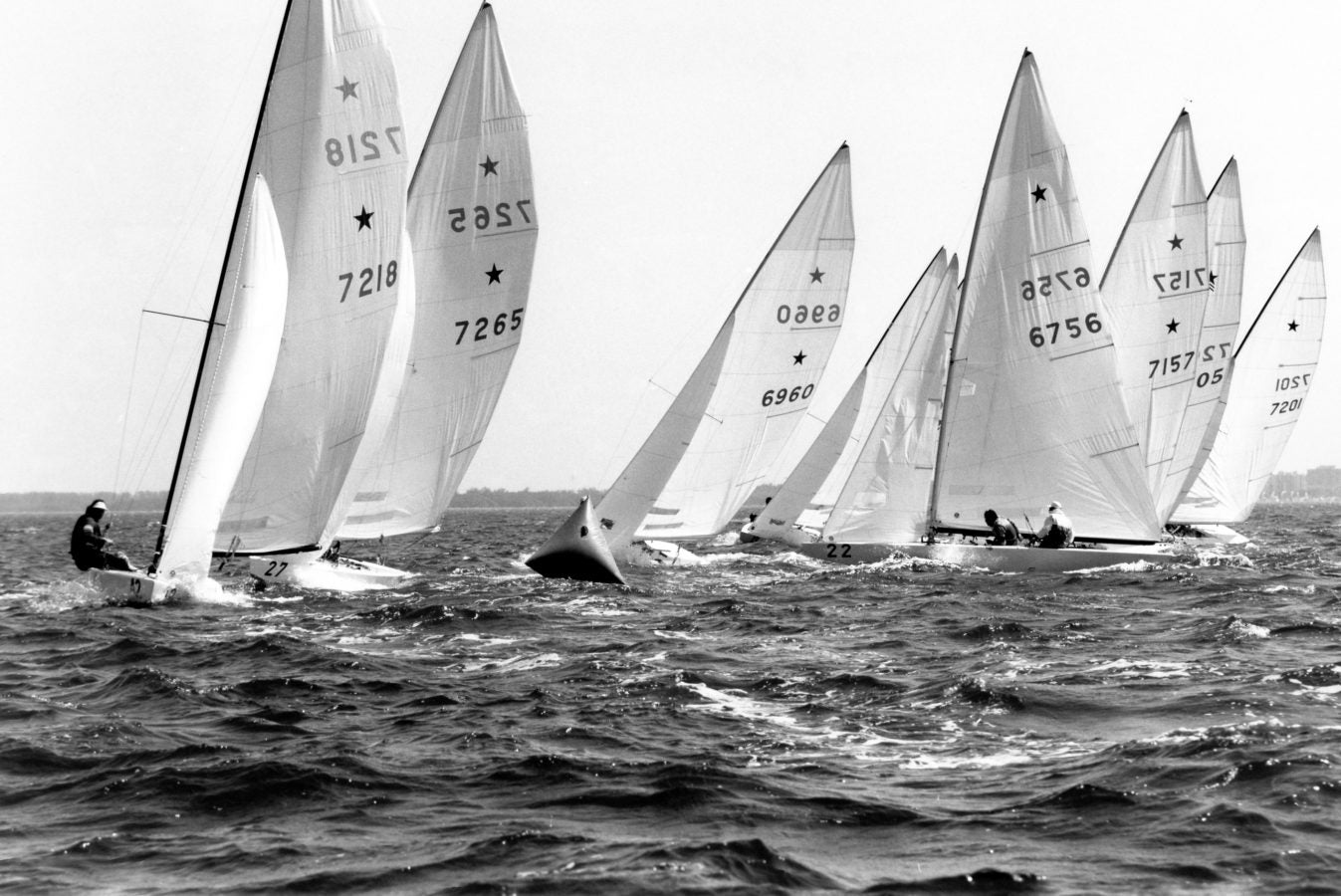
events
1968 - OLYMPIC SAILING SUCCESS
1968 – Olympic Sailing Success
In the original North Sails loft in San Diego, Lowell North initiated in-house testing of sail cloth and design shape. With a focus on the Star class, it was in this loft that he developed the sails he would win Olympic Gold with in 1968 in Mexico City. Olympic success has run strong throughout North Sails history, with numerous medal-winning staff members and a wide-reaching commitment to providing the best one design products across different classes. Recent examples include the Finn, Women’s 470, and Women’s 49er FX, in which North sailmakers work closely with Olympic sailors to achieve performance gains through cutting edge design and complementary trim and tuning.
In this video we hear from one design expert and Olympic sailor, Vince Brun, who’s leadership guided North Sails One Design for 35 years. In addition, Olympic medalist Caleb Paine (Finn, USA) shares how North influenced his winning performance at the Rio Games, and European President of North Sails One Design, Paul Hobson, gives a sailmakers’ perspective by drawing from his 20 years of working with the Finn class.
READ MORE
READ MORE
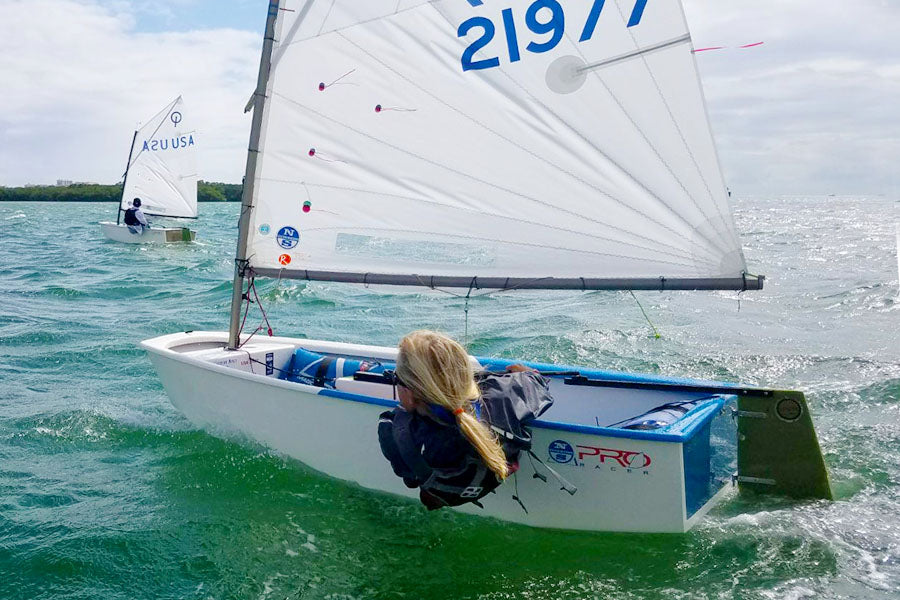
events
NORTH U LEADING EDGE OPTIMIST CLINIC
NORTH U LEADING EDGE OPTIMIST CLINIC
Optimist sailors in Miami, FL define their need for speed in two-day clinic with North Sails Experts and Coaches
In conjunction with the Southeast Dinghy Championships, North U hosted their inaugural Leading Edge Optimist Clinic at Key Biscayne Yacht Club to get sailors ready to take on the winter sailing season. Thirty-three Opti sailors from throughout the US, Puerto Rico, and the Virgin Islands participated in this first edition, which featured a curriculum spanning two days of on the water training and classroom sessions.
The sailors were challenged by a number of drills and races during the clinic, where boat handling, speed, and tactics all came into play. Miami delivered fresh conditions of sunshine and 10-15 knots of wind, a great platform for fun competition with new friends. North Sails Head Coach, Juan Carlos Romero, and Optimist expert Zeke Horowitz kept a close eye on the fleet to encourage participation and foster new experiences. Emphasis was placed on asking the sailors to think independently, as Juan explains,
“On the second day of the clinic, our main focus was to work with the sailors on their ability to develop a good strategy (game plan) and to help them make good tactical decisions. We incorporated two drills that forced our fleet to go through this thinking process, and then implement their tactical knowledge at its best to be able to execute their game plan.”
North Sails coaches reported the most effective drills were “Pick a Side” and “Long Line Starts”. In the Pick a Side drill, sailors learn to come up with a game plan and execute their decision to see how they end up at the top mark. The Long Line Starts drill gives sailors great practice in being able to tell how close they are to the start line by avoiding any potential line-sag.
North Sails designer, Mike Marshall was also on site, offering a fresh perspective on sail mechanics. Two seminars on “How Sails Work” gave sailors a deeper look at how the wind fills their sail to propel the boat forward, and how they can move the center of effort by fine-tuning their rigs with controls like sprit tension, boom vang, outhaul, and body movements to keep the boat flat. Lucas, who attended the clinic from Texas said:
“I usually sail on a lake. The chop and the breeze has been a nice challenge for me. The clinic has been great with all the help from the coaches. I learned a lot over the last two days.”
Sailors had the opportunity to try different sails over the two days, including the North Sails R1, R2, R4, and our latest design for the Optimist, the R5. Introduced this Summer, the R5 is made for specific weight ranges to increase point-ability. All sails in the R Series feature a radial cut.
Laura “Lulu,” who sails for Lauderdale Yacht Club tried the R2 product for the day. After three races in building breeze, she noticed when she put the bow down she was able to get speed while slowly pulling in her main to full trim.
“I was able to hold my lane, even when it was thin, and could get the extra point while my overall boat speed got faster.”
“The R1 has the right amount of power,” said Samara from New York. “It is super easy to get the extra point off the line at the start, where it’s really important to be fast.”
North Optimist sails are designed to produce the most power for their sailor, keeping them fast and able to maintain even the thinnest lanes. As sailors at the clinic tried out the R Series, we asked Mike about the benefits of radial vs. cross cut Opti sails.
“Radial sails have a more forgiving shape than conventional cross cut sails. They hold their shape better under different wind velocities. North’s cross-cut sails are not all that different from the R Series, but over time the cross cut will definitely break down more than the radial will. Are radials more sensitive to trim? Potentially, but that is the result of a design shape, not necessarily a sail’s construction.”
Amongst the many things addressed over the course of the two-day clinic, Juan wanted to make sure the sailors came away with something that would motivate them and help further their sailing careers,
“Put in time on the water. Don’t be lazy. Just get out there and spend as much time as you can on the water, in your boat. The clinic was an eyeopener for a lot of the kids who joined us, and it was nice to see the North designs bring success to those who used them over the course of the two days.”
Mike continued this sentiment from Juan,
“I encouraged them to try things on their own, don’t just do what you are told to do. Go out there and try to come up with solutions to your own questions you may have, or why you might not be going as well as someone next to you. Compare your sailing to someone else’s by finding the things they are doing that maybe you aren’t, and then try those things to see if it helps your performance.”
Special thanks to Agustin ‘Argy’ Resano, Brian Halloway, and Kristoffer Sarmiento who helped North Sails make this great event a success!
For more information on sails for the Optimist, or to speak with your local expert, visit our product page.
North Sails Optimist Tuning Guide
READ MORE
READ MORE
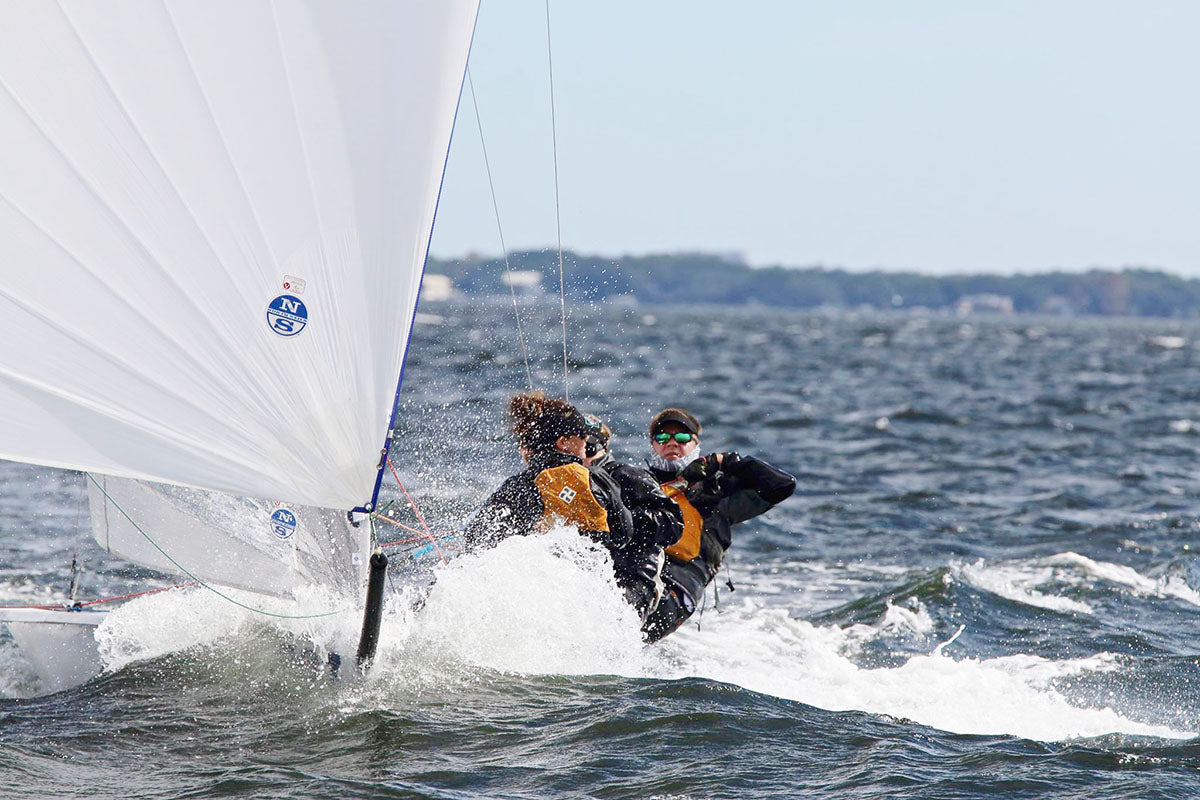
events
VIPER 640 NORTH AMERICANS
2017 VIPER 640 NORTH AMERICAN CHAMPIONSHIP
North Clients represent at North Americans, proving consistency and fine tuning really pay off
The 2017 Viper North American Championship was hosted by Fort Walton Beach Yacht Club in Florida, where 55 teams competed in one of the biggest and most competitive Viper regattas in the history of the class. On Monday, North Sails experts Ched Proctor, Zeke Horowitz, and Jackson Benvenutti led a clinic for competitors who were interested to practice straight line speed and starting techniques. A video debrief concluded the day, with tons of great questions from sailors trying to sort out any last minute fine-tuning before the big event began. On Tuesday teams went out for a final shakedown to practice boat handling and crew work before the regatta started on Wednesday.
Day one was a long day but successful as the race committee was able to get four great races off. North clients sailed fast on the first day, putting them at the top of the scoreboard and ahead of the game early. Very shifty conditions gave the fleet challenges throughout the remainder of the week with eleven races completed by Saturday. The racing was very close, with little points separating boats in the top half of the fleet.
What we learned:
Making sure you were ready for the shift and positioned to be in phase when the time came was key in this competitive fleet. Rig tension was a big topic, many teams setting their lowers tight enough to keep the mast straight and the headstay tight. Finding the right balance of mainsail trim to keep the boat flat enough did not allow too much headstay sag. The headstay tension on the Viper is key to maintain speed and point when boats are powered up in breeze and flat water.
Rocket tensioners are quite popular in this fleet, but careful attention to the tension of your battens is important and something that all competitors seemed to note. When your battens are too soft, you will see vertical wrinkles along the batten pockets. When they are set correctly, the sail is smooth.
Winning rig tune in big breeze was around 8 full turns on the uppers and 4 full turns on the lowers, when sailing with 3 ⅛” blocks. Flat sail, tight headstay, and windward sheeting was fast.
Vang-on hard the second the main has to be eased, while pulling on more cunningham to take the overbend wrinkles out of the sail, also produced great results. The vang and cunningham needed to be released at the same time, as soon as there is need for the vang to be eased.
Starting in the front row, as always, was the game changer. You had the first chance to be in pressure and get the first shift.
Having one person find the wind and make that their main job was also a plus. Even when you were sailing downwind, keeping an eye on what was happening behind you not only to stay in the puffs, but to be ready with a plan when it came time to go upwind again was huge.
Congratulations to our clients for your excellent performance all week in the shifty conditions. Special congratulations to team Cajun Underwriting, with skipper Marcus Eagen, his brother Andrew Eagen, and North Sails expert Jackson Benvenutti taking first overall, proving that consistency really pays off.
Click here for more information on our fastest Viper sails, or to contact your local expert
2017 VIper North Americans
1
Cajun Underwriting / Marcus Eagen
3
Choppy Seas / Thomas Loutrel
4
Moxie / Zeke Horowitz
5
Mambo Kings / Rob Crane
6
Terminally Pretty / Mary Ewenson
7
Mo’ Grins / Dave Nickerson
8
‘Merica* / Paul Kleinschrodt
9
Southern / Patrick Ryan
10
Chaos / Brian Harrison
Corinthian
1
Mo’ Grins / Dave Nickerson
2
‘Merica* / Paul Kleinschrodt
3
Southern / Patrick Ryan
* Denotes Partial North Sails Inventory
Full Results
READ MORE
READ MORE
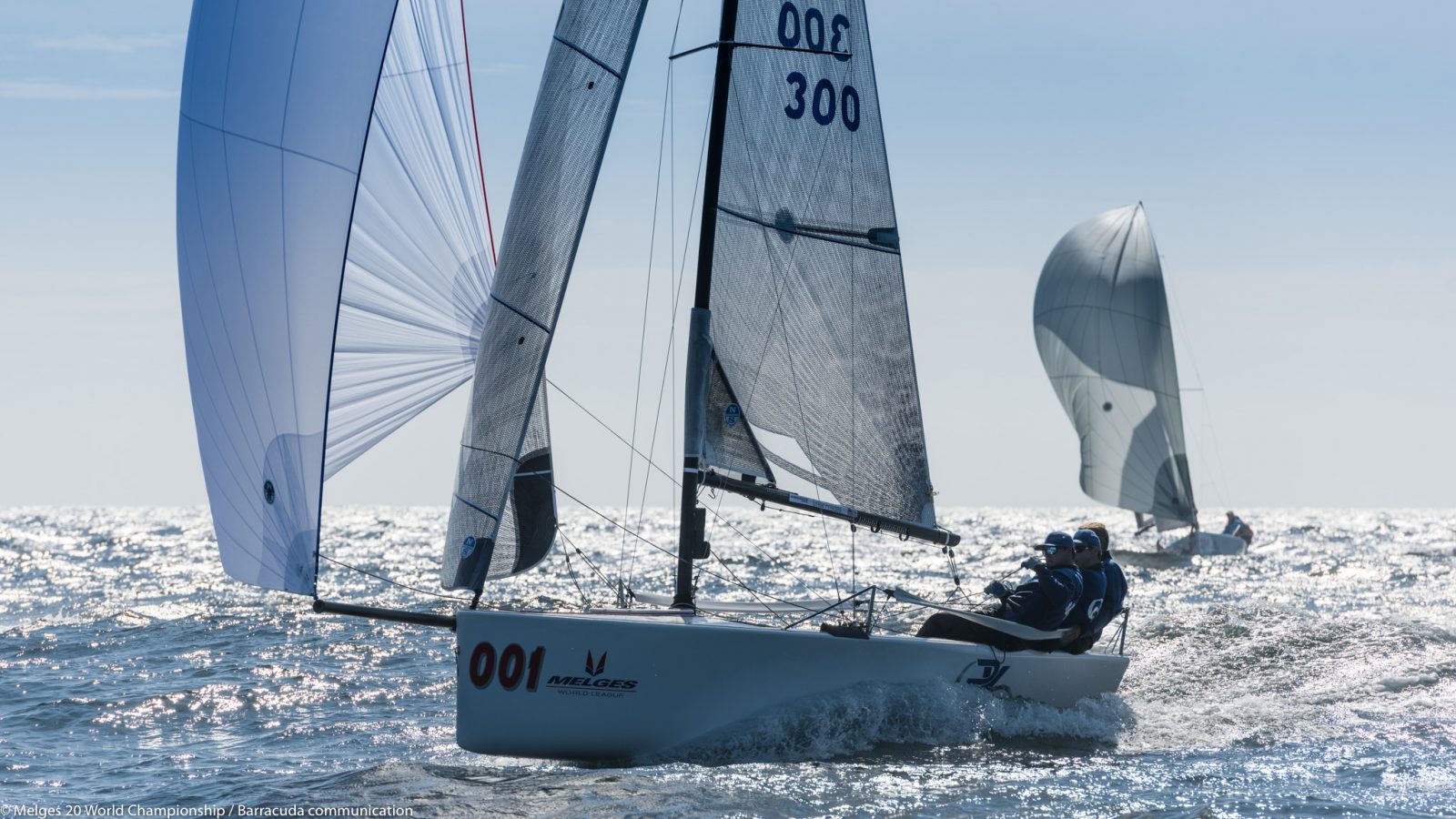
events
INTERVIEW WITH 2017 MELGES 20 WORLD CHAMPION
Melges 20 Worlds Interview
Client Drew Freides shares his team’s success story in the Melges 20
We caught up with client Drew Freides, this year’s Melges 20 World Champion. Here is what he had to say about his team and what they’ve been doing to prepare for the Worlds event this past September in Newport, RI.
NS- You’ve been a long-time crew sailing on many different boats mostly larger Grand Prix style, how was the transition to taking the helm, but also sailing a 20 Footer?
Having been a yacht designer and member of many big teams the one take away I’ve learned is to assemble the best team possible. Then I can allow everyone to work and take over their areas. I did college sailing at MIT, sailed 470’s I always loved sailing dinghies. Big boats are fun, and it was part of my job as a yacht designer, but I couldn’t afford a program like a Farr 40. Five years ago, I was sailing the Vineyard Race with Chad Corning and I asked him what kind of boat I should be looking at, he said I should get a Melges 20.
“I looked at the 20 and thought it was a great class that combined dynamics of a team but also the incredibly fun sailing on a skiff style boat. The 20’s are awesome! They are fast downwind and so responsive.”
NS- After finishing 2nd last year at the Worlds (with the same team), what did you and your team identify as things to work on for this year?
“We were gutted last year! Finishing 5th would have been palatable, finishing 2nd after leading going into the last race was just tough to take. After the event we crossed the finish line with our heads down. Our coach turned to us and said, “Coming into this event if I had said you would finish second in the world would you be satisfied?” We all responded “Yes.”
We put our heads together and asked how do we get one notch better? We took the next 12 months to do every single event that we could in the US so we could get better in every aspect of our sailing. Get a little fast and look for every opportunity to find speed in the whole program where others haven’t looked before. There are boats like Samba Pa Ti who are still faster than us in high winds, but we feel like we are good in all conditions. We always feel fast and consistent, and that is what keeps us in the hunt. We were talking to Ed Adams during the event and he said that we might be the only boat who doesn’t want one condition but all of the conditions because it would give us the ability to shine through the range.
NS- I think what showed that was the early part of the regatta when it was windy and then one of the light air days you were over early and came back to a top 10 race.
“That was the best race we have sailed as a team, EVER. We came off the line and everyone was in hyper focus. It’s the Worlds. We wouldn’t allow this to be our demise.”
Morgan to his credit picked out every puff and shift and we worked our way through the fleet picking up one boat at a time. One thing we learned last year in Italy was we were really slow in light air. We asked to tune with a boat named Raya, who weren’t the fastest in a breeze, but in light air they were rockets. We went out and looked at their set up and our coach said we should try their set up, and after we did we were rocket fast. Going into things like set up with an open mind is one of the things I felt we were good at.
NS- Did you have to make any major boat set up changes from last year in Italy to Newport this year?
No, honestly we’ve been refining our techniques of the last two years.
NS-How do you split the responsibilities among the team? (who looks at weather and the notice board? Who makes sure sails are ready, etc.)
Morgan is completely responsible for tactics and strategy of the boat, and where we want to be. He coordinates with our weather guy to stay aware of what is happening. Morgan is completely focused on boat positioning all the time when we are on the water. If I’m doing my job well, by steering the boat fast and giving Morgan feedback for his main trim, that really allows him to look around.
“The most important thing we have found is staying on top of the heel angle. Charlie’s job, besides making sure everything with the boat is great, is to work with me on boat speed. Because he has been all over every little part we’ve, ‘knock on wood’, never broken anything. Before the event, one of the other boats pulled a pad eye out of the back of their boat, so Charlie went and looked at ours and noticed a little rust, so he replaced them all. While sailing Charlie will work the rig and listen to what I’m saying about the helm load and if need be will start pulling the rig on to flatten the main. ”
I take on our sails, working with our coach, I make sure we are using our buttons properly and our sails are up to date. Helping to decide if it’s a non-sanctioned regatta to use a non-buttoned sail, saving the buttoned sails for sanctioned regattas. With that said, Morgan trims the main before we leave the dock, so Morgan chooses which battens to use and how tight he wants to make them.
“The good and bad thing about the 20 is the rig is complicated, so after making changes to the rig we went back out sailing and were much faster. It might have taken two years to achieve this, but we learned in 10 min by working with our coach and fine-tuning to have a better idea of where our base was. This made the difference.”
NS-You looked at the 3Di sails but used the 3DL. What pushed you in that direction?
“We had looked at the 3Di sails leading into the worlds. But we had worked so hard in our current set up and felt comfortable with 3DL sails. We got another 3Di jib days before the World’s, started and it looked great. Had we gotten the sail earlier I think we might have used it. I’m planning on getting a 3Di main next year.”
NS- How do you think you were crew weight compared to the fleet? (The Melges 20 has no crew weight)
Really Average. There were two top boats that had four people (2nd Nika & 6th Wildman). When it was really windy it forces us to work harder but in the light we make that up on them.
NS- It seems like the class has leveled itself out and everyone is in the same range of crew weight.
Absolutely. Ed Adams used to say to us that we were incredibly fast upwind but not that specular a lot of times downwind. This regatta we past most of our boats downwind.
NS- How did you fix your downwind speed?
By sailing as many regattas we could I learned how hard I could push the boat. Also Charlie worked super hard and did a great job trimming. Morgan did a great job of setting us up to jump past packs of boats when we jibed and keeping clear lanes.
NS-What races do you have planned for next year?
“We are doing the Miami Winter Series. Looking into racing in Charleston, but thinking about taking the boat to Europe and try to defend our title.” said Drew.
Find out more about our World Championship winning products for the Melges 20, or contact your local expert.
READ MORE
READ MORE
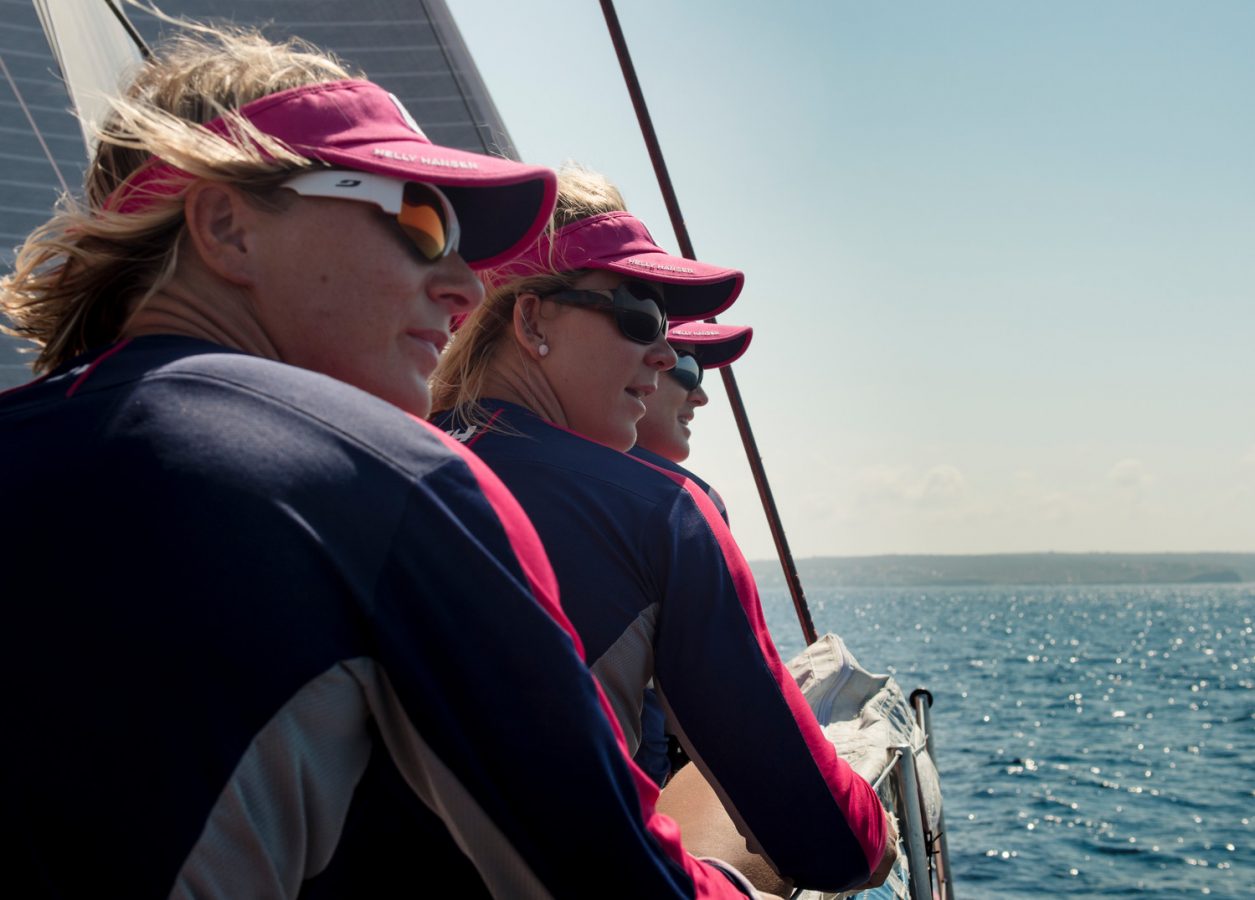
events
LET'S HEAR IT FOR THE GIRLS
LET’S HEAR IT FOR THE GIRLS
Recognizing A Shift In Momentum For The Ocean’s Leading Women
© Tanya Visser/PPL
A new rule change for 2017-18 has brought women back to the center of the Volvo Ocean Race by leaving all-male crews at a significant disadvantage.
The rule pays homage to the race’s history of female sailors, which began in 1977 with skipper Claire Francis and includes the first all-female Volvo Ocean Race team of 1989 onboard Maiden, the Whitbread maxi skippered by Tracey Edwards. A long hiatus from 2005 – 2012 was broken in the 2014 edition by Team SCA, another all-female team led by two-time Vendée Globe skipper, Samantha Davies. The enthusiasm surrounding Team SCA, as well as the mounting interest from female sailors throughout the globe, prompted race organizers to keep the momentum going. The Volvo Ocean Race will have a landmark edition in 2017-18, with every team in the race electing to have two girls among the crew – guaranteeing a female sailor at the top of the podium in Gothenburg.
North Sails is proud to have supported a number of offshore sailing’s most notable female trailblazers, drawing back to Ellen McArthur’s notable campaign on Kingfisher (2000) where she achieved both the women’s singlehanded transatlantic record (east-to-west passage) and women’s singlehanded, non-stop, monohull circumnavigation record. North’s support continued on to her multihull platform B&Q/Castorama, on which she broke Francis Joyon’s outright circumnavigation record with a time of 71 days, 14 hours, 18 minutes and 33 seconds. In more recent history, North Sails powered Sam Davies and the crew of Team SCA in the 2011-12 Volvo Ocean Race, as well as Dee Cafari, skipper of Turn the Tide on Plastic, who currently has 800 nm to go in Leg 1 from Alicante to Lisbon. Dee is the only female skipper in this edition of the Volvo Ocean Race and elected three female sailors to her crew.
Tracey Edwards competed in the Volvo Ocean Race in 1985-86 (then referred to as the “Whitbread Race”) and went on to skipper her own entry, Maiden, in 1989-90.
Team SCA completed the 2014-15 Volvo Ocean Race with a crew of 11 women. © Corinna Halloran/ Volvo Ocean Race
Team SCA would spark a flame of enthusiasm for female sailors around the globe, and encourage race organizers to promote participation from women. © Corinna Halloran/ Volvo Ocean Race
In 2006, Dee Caffari became the first woman to sail single-handedly and non-stop around the world “the wrong way” – westward against the prevailing winds and currents. © Jen Edney/Volvo Ocean Race
Dee is currently the sole female skipper in the 2017-18 Volvo Ocean Race, onboard VO65 Turn the Tide on Plastic. © Ainhoa Sanchez/Volvo Ocean Race
READ MORE
READ MORE
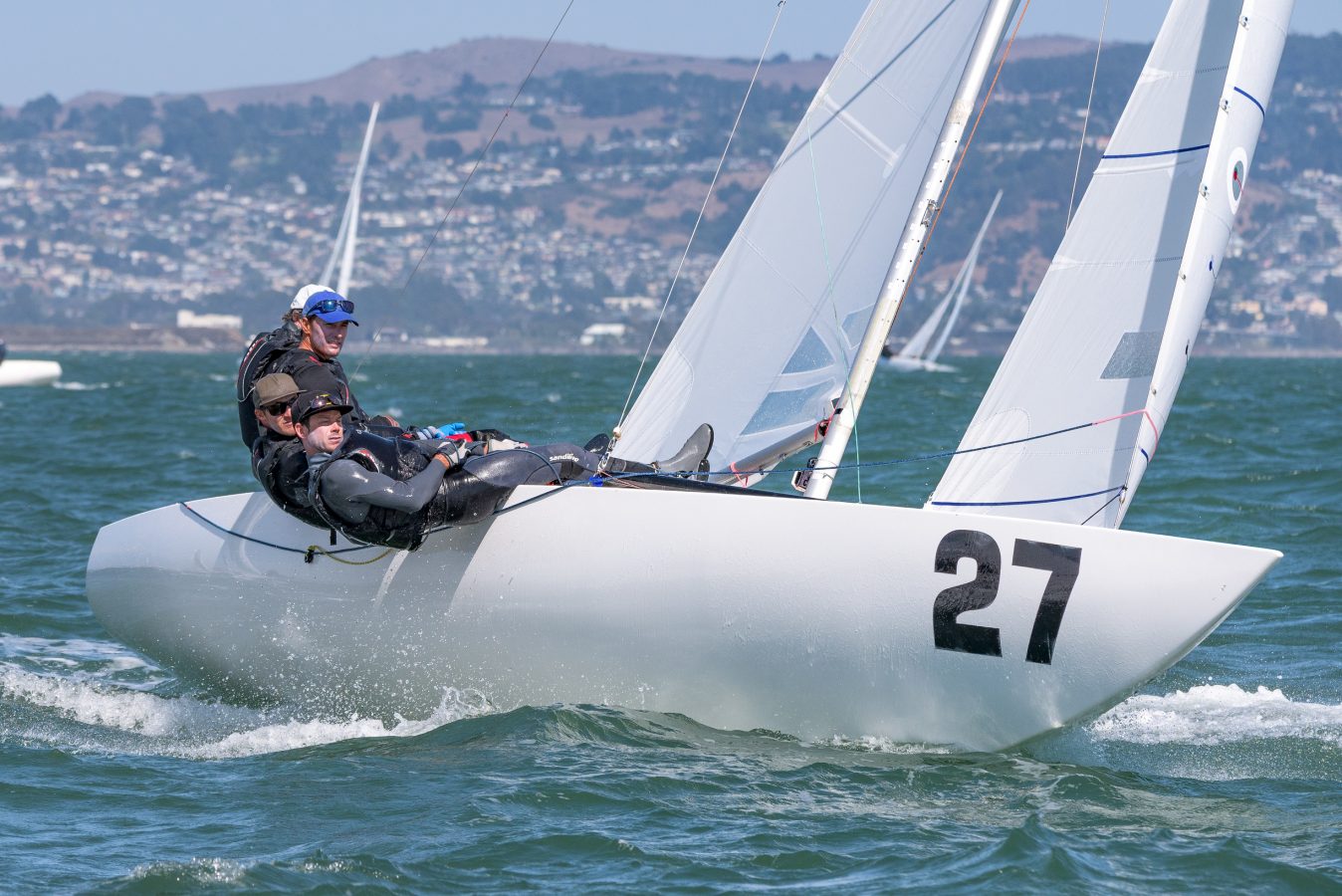
events
ETCHELLS WORLDS INTERVIEW
ETCHELLS WORLDS INTERVIEW
How North Sails Stella Blue conquered the Etchells World Championship in San Francisco
We caught up with Steve Benjamin to get his overall perspective on sailing the Etchells, which is one of the most competitive One Design Classes in the world. As many of you may already know, Steve has an impressive history of racing that sailing enthusiasts could only dream of from small boats to 52-footers in an open-ocean race setting. Here is our Q & A with Steve to see what had to say about the Etchells, what draws him to the class, and what he does to be the best in every Etchells event he competes.
NS: Steve, first off you have sailed many, different types of boats over the years. From 470’s (Olympic Silver medalist in 1984) to 505’s and big boats including the TP52. What is the appeal of the Etchells class to you?
Benj: There are three things that attract me to the class. First is the level of competition which is really one of the highest of any class in the world right now. A lot of teams in the US and abroad are putting so much effort into succeeding. Second is the technical nature of the boat. The Etchells is very sensitive to tuning and tweaking. I really enjoy working with North on developing the sails and tuning techniques. Third, is the teamwork aspect of the four (or three) person boat. The team dynamics of sailing with a four person crew are a great challenge. We all try to do our best to specialize in our individual roles.
NS: You’ve sailed with much of the same team for at least the last year, Michael Menninger, Ian Liberty and Dave Hughes. How do you divide up the roles? Who does what and when and where do you as the helmsman come in?
Benj: We do try to specialize. The specialization begins with Dave Hughes. He trims the jib upwind and the kite downwind. He is also in charge of the tuning of the boat. Michael is on tactics and also trims the main. He works on the weather and current. For example, Michael selects the battens for the main each day. Ian rigs the boat, cleans the bottom (thanks Ian), charges radios and does most of the boat prep stuff. Ian sits between Dave and Michael upwind. When the spinnaker pole comes into play Ian slides to the foredeck. Ian puts the pole up and Dave eases the jib sheet.
“My job is to give the guys feedback on how the boat feels. We do a lot of coarse adjusting depending the immediate conditions. If I see a set of waves ahead I’ll tell the guys we are going bow down or if we have to hold a lane I’ll verbalize that and say we need a high mode. My role is really as the coordinator. I schedule the practices and events, and handle the organization of the boats and the program.”
NS: You sailed a newer Ontario boat. Can you tell us a little bit about the mast and what you are looking for in how it bends. Did you have any special set-up with your spreader deflection fore and aft?
Crew set up:
Yes, we sailed a new boat that was launched in April. It was a birthday present from my wife Heidi, and the Ontario Yachts team did a great job. We put a lot of planning into the systems and the deck layout for sailing with a four person crew. For example the hiking line was moved to the back of the barney post for me. Michael hikes off the main sheet which is at the front of the console. Ian hikes off the spinnaker sheet and Dave hikes off the foot block and the jib sheet. I hardly ever touch the main sheet.
Boat set up:
We’ve done a lot of work on masts. We pretty much have one of each maker and have tried all of them except the Whale Spars mast that I would eventually like to take a look at. In the end we decided we did not have enough time to trial anything else and stuck with what we were familiar with, which is an older Proctor mast. We have two of these from 2001 and 2002. The one we used was the 2001 which incidentally was the same mast Ken Read used when he won the Worlds.
Our spreaders are pretty much straight out. We are looking at the swinging spreaders. I think these should always be better downwind as long as the rigs don’t blow out of the boat. We have not seen any evidence of that happening as yet. Certainly they allow the rig to go further forward which has to be faster and it seems like you should be able to restrict the aft sweep to whatever you want within the rules.
NS: The “Dog” mast lever is still fairly new in the class. Can you tell us how you use it normally and what changes you might make with it in special situations like when you want to point or go fast forward?
The mast lever is a must have. Downwind you always let it go all the way forward. If there are waves and the mast is rocking around you want to lock it forward with the mast ram forward control line. Some boats have shockcord to pull the mast ram forward. We tried that and prefer the positive aspects of the control line. Upwind over 8-9 knots (as soon as hiking) we always have the mast all the way back in the partners all the time. That presumes the mast butt is in the right location.
“Where the mast lever really comes into play is in lighter winds as a mechanism to power up the boat. If you are lacking power you call pull the lever forward which adds sag to the headstay and makes the jib more full. It also induces more prebend in the mast which opens up the leech of the main. This seems to work really well with North’s designs and allows you to go through the whole wind range quite well. Also when you encounter some chop in light air you can pull the lever back and tighten everything up, then stabilize the rig to get through it.”
Our rule of the thumb is to position the mast all the way aft in the partners once we are hiking. Then we adjust the mast step to the correct location. We move it further forward as the wind builds, aft as it lightens. We try our best to always create as much separation between the luff of the jib and the leech of the main as possible.
NS: How do you decide what spinnaker to use? The VMG or Runner?
We use the VMG until crossover, which is about 9 knots true wind speed in flat water. If it is wavy and choppy we push the VMG a little higher maybe to 10 to 11 knots. We have thought about using the VMG for planing conditions but we have not had a chance to try it yet.
NS: What about rig tuning? Do you follow the North guide and/or are there any rules of thumb you use when setting up the rig before the start?
Dave Hughes handles our rig tuning. One of things is we have tried really hard to develop is a solid base setting. We always return the boat to base after every day of sailing. The base setting may evolve a little during an event due to things stretching and settling. We check base every morning before we leave the dock so we are sure.
“We simplified the way we talk about where the mast butt is. We measure 3800 millimeters forward, from the aft deck (mark 12’ aft from the aft edge of the partners) through the barney post to the keel “I” beam. Then we talk about millimeters forward of this mark. We are generally between 7 and 25 mm from that mark. The step position is sort of the foundation of it all. Our base setting is around 14 on the new boat (1262) and closer to 18 on the older boats (1060, 1228 and 1262).
We are at about 47 ⅜” on the headstay length “arc.” We set the headstay to 10 on the gauge using just the backstay. At that tension we go to 19 on the uppers and 15 on the lowers for base. Another thing we have changed is that we use open body turnbuckles on the shrouds like you have on a J/70. We actually use half turns on those since the threads are finer and you are adjusting two studs at once. We have “third hands” on the shrouds and Dave has batten tool he can use to turn the turnbuckles. It has a loop of light shockcord on it so we can lock in the shrouds while we are sailing.”
We have the “Dog” (Andrew Palfrey) swivel on the headstay.
The rule of thumb that you want your leeward upper shroud just taut holds true up to a point. As the wind builds there is a point where you’ll need too many turns get the leeward upper taut. So many that the mast will suffer from over-compression bending. We have found that it is quite fast in breeze when the leeward lower is engaged. Especially with the PC-FM main.
NS: Lets talk about sails. You’ve mentioned that you really like the new PC-FM main. What other sails did you measure in for the Worlds? I suspect it was kind of a tricky decision based on the time of year in San Francisco where it can actually be pretty light on some days?
“Yes indeed we really like the PC-FM main, it is very versatile. Our “go to” jib is the LM-2H RH (Radial Head) and we have 100% confidence in that sail. We also had 100% consensus with the sailing team that we had to use this sail. Where it got tricky was whether to measure the light jib or the heavy (GM 6.5). I did talk to my good friend Stan Honey before the regatta and his models showed little temperature and pressure difference during the week between San Francisco and inland. That lead Stan to suggest we select the light jib, which we did. We like the LM-2L without the radial head. It seems to be a very powerful light air sail.”
NS: You’ve helped to start an initiative to get more younger sailors involved with the Etchells class. Can you tell us a bit about that?
Benj: With the help of David Franks, Senet Bischoff, and Michael Gavin we started with the Youth Program this year in conjunction with the Gertrude Cup in the UK. This year we sent two teams to it and they did great. One team, led by team captain Connor Needham was leading the event for a while and ended up second in the Gertrude Cup. Resulting in the US Team winning the first ever Etchells Youth Challenge.
NS: How does a youth sailor get involved?
Benj: This year there was an application process. We had about 15 youth sailors apply and we selected eight US youth sailors to go to the UK to compete. We are hoping to expand the program this year and get some other countries involved. We already have an invite from Australia for their event in January.
“I am really hoping many more of the other owners get behind this. There is a funding need as well as help needed with logistics and boats. It’s a great way to grow the class and create interest among younger sailors. To qualify, the youth sailors cannot have reached their 25th birthday as of the 1st of January in the competition year.”
NS: Steve, thanks so much for your time and wish you the best in the upcoming Winter events in Florida!
“Thanks for the fast sails, and we hope to see everyone in Miami this Winter.”
READ MORE
READ MORE

events
NEW J-6 JIB SHINES AT THE 2017 J/70 NORTH AMERICANS
JOEL RONNING WINS J/70 NORTH AMERICANS
J-6 proves to be the most user-friendly High-Clew Jib available
Team Catapult, 2017 J/70 North American Champions. © Chris Howell
Fifty-three teams met in New York at American Yacht Club for the 2017 J/70 North American Championship. Going into the first day, the wind was sustained at 25, with larger gusts to 30. The waves were very steep, due to the current going against them. Keeping safety of the teams and regatta personnel in mind, PRO Mark Foster made the right call to stay ashore.
Day two brought lighter sailable conditions with the wind ranging from 12 to 18 knots. The challenging aspect of the day was the steep chop that was left over from the previous days’ strong winds. Pounding through the disorganized, at times 1.2 meter waves, increased the difficulty of holding a lane off the line. To make up for lost time from the previous day, 4 races were sailed, each lasting about 1.5 hours. Exciting planing conditions downwind allowed sailors to exercise a variety of techniques, including wing on wing in the lighter patches.
Day three was a stark contrast from the start of the event, with winds from the same easterly direction, only peaking at ten knots in the morning tapering to almost nothing in the afternoon. Strong up-course current made starting and sailing downwind in the light air difficult. A late shift to the right on the last downwind in one race saw a bit of fleet inversion with the some of the boats that were last around the final top mark making it into the top ten. With the overall windspeed dying and oscillating between 40 degrees, racing was called for the day.
Due to the lack of races so far for the event, an earlier start time was in store for day four, meaning anything could happen with the scoreboard. Winds started out at 5-12 knots out of the southwest for the first two races of the day. Shifty conditions gave the edges flatter water and ended up paying for those who committed to the sides. For the final race of the regatta, the wind picked up to 15 knots, and by the end of the first beat , teams were back up to planing conditions for downwind. Joel Ronning and his team Catapult won the final race of the regatta, claiming the title. Congrats to Joel and his crew on some great sailing, and a special thanks to Mark Foster for getting in as many quality races as possible in trying conditions.
Catapult sailed with North XCS-1 Mainsail, J-6 Jib and AP-1 Spinnaker. We are very proud of the way our new J-6 jib performed at the North Americans. It delivers an untouchable mode of upwind speed and height. The new J-6 jib has again proved its top end speed in a wide range of conditions.
“The results at the NAs reinforce that the J-6 is the most user-friendly high-clew jib available.” said North Sails One Design President Tim Healy.
Here are some tips from the North Americans:
Setting Up the J-6 Jib for Max Speed
One key element of setup is the weather sheet. It is imperative to sail with enough weather sheet to give the sail some depth and power down low, while generating twist and keeping the upper leech open. Make sure the weather sheet comes on as quickly as possible after the tack as the boat needs the power from the bottom of the jib to get up to speed immediately after a tack. Some teams even experimented with “pre-setting” the weather sheet as they steer through the tack!
Another key to trimming the J-6 for maximum speed is to make sure that the main sail is flat enough down low to be sure that you aren’t getting too much return from the lower leech of the jib. Your lower shrouds shouldn’t be too tight, keeping in mind that you have enough outhaul on and, in over 13 knots, that you have some vang on to keep that lower main flat. Look for pre-bend wrinkles in the lower third of the main to be sure you’re set up correctly.
Detach from the Pack
In big fleets, it is incredibly helpful to be able to separate from other boats and give yourself the opportunity to use your boat speed to make gains on other packs. Packs create high traffic, and disturb the airflow. It is important that the tactician looks for the lanes that might allow them to “detach” from these packs and move up that half ladder rung, which leads to getting a narrow cross later on up the beat. This can make a difference between a top 10 rounding, and being stuck in the middle.
Having a good start in the front row is the first way to get yourself out and running away from the big pack of boats, but it doesn’t stop there in a 50+ boat fleet. The tactician needs to think ahead and ask themselves, “If I tack here, am I going to have a lane?” Or will I be putting the boat in a position to make a gain using my extra gear of boat speed?”
The same can be said for the downwind legs as well. Rarely it works to sail the middle of the course downwind because there is so much disturbed airflow from the big fleet. Pick a side and commit to it – doing your best to separate from other boats and keep your lane and air clear.
When picking which gate to round in a congested fleet, make sure you predict which mark will have the cleanest “escape”. Which mark does it look like the pack in front of you will round? After you round the leeward mark, there will still be boats coming down the run. Which side of the course has less boats on it? Even if you want the right side of the course on the next beat, it might be better to round the course-left gate mark if it means staying clear of downwind boats coming at you with spinnakers, creating a ton of chop. Every bit of separation you can get can lead to big gains at the finish line!
For more information contact our on-site support team at the NAs: Zeke Horowitz, Mike Marshall, Eric Doyle or Max Skelley.
Shop J/70 sails
READ MORE
READ MORE



















